Table of Contents
- Introduction
- Rack PDU Front Panel
- Command Line Interface
- About the Command Line Interface (CLI)
- Log on to the CLI
- About the Main Screen
- Using the CLI
- Command Syntax
- Command Response Codes
- Network Management Card Command Descriptions
- Device Command Descriptions
- Network Port Sharing Commands
- alarmList
- bkLowLoad
- bkNearOver
- bkOverLoad
- bkPeakCurr
- bkReading
- bkRestrictn
- devLowLoad
- devNearOver
- devOverLoad
- devPeakLoad
- devReading
- devStartDly
- dispID
- energyWise
- humAlGen
- humHyst
- humLow
- humMin
- humReading
- humStatus
- lcd
- lcdBlink
- logToFlash
- olAssignUsr
- olCancelCmd
- olDlyOff
- olDlyOn
- olDlyReboot
- olGroups
- olLowLoad
- olName
- olNearOver
- olOff
- olOffDelay
- olOn
- olOnDelay
- olOverLoad
- olPeakLoad
- olRbootTime
- olReading
- olReboot
- olStatus
- olType
- olUnasgnUsr
- phBal
- phBalAlGen
- phLowLoad
- phNearOver
- phOverLoad
- phPeakCurr
- phReading
- phRestrictn
- phTophVolts
- prodInfo
- sensorName
- tempAlGen
- tempHigh
- tempHyst
- tempMax
- tempReading
- tempStatus
- userAdd
- userDelete
- userList
- userPasswd
- Web User Interface
- Status Tab
- Control
- Configuration
- About the Configuration Tab
- Configure Load Thresholds
- Configure Rack PDU Name and Location
- Set the Coldstart Delay for the Rack PDU
- Reset Peak Load and kWh
- Set the Overload Outlet Restrictions
- Configure Phase Load Balance
- Configure and Control Outlet Groups
- Outlet group terminology
- Purpose and benefits of outlet groups
- System requirements for outlet groups
- Rules for configuring outlet groups
- Enable outlet groups
- Create a local outlet group
- Create a global outlet group
- Edit or delete an outlet group
- Typical outlet group configurations
- Verify your setup and configuration for global outlet groups
- Outlet Settings
- Configure Outlet Alarm Actions
- Schedule Outlet Actions
- Outlet User Manager
- Configure Temperature and Humidity Sensors
- Security
- Network Features
- Notifications
- General Menu
- Logs in the Configuration Menu
- Tests Tab
- Logs Tab
- About Tab
- Device IP Configuration Wizard
- How to Export Configuration Settings
- File Transfers
- Troubleshooting
APC AP8681 User Manual
Displayed below is the user manual for AP8681 by APC which is a product in the Power Distribution Units (PDUs) category. This manual has pages.
Related Manuals

User Guide
Rack Power Distribution Unit
Metered-by-Outlet with Switching
AP86XX
990-5570L-001
Publication Date: June 2019

APC by Schneider Electric Legal Disclaimer
The information presented in this manual is not warranted by the APC by Schneider Electric to be authoritative,
error free, or complete. This publication is not meant to be a substitute for a detailed operational and site
specific development plan. Therefore, APC by Schneider Electric assumes no liability for damages, violations of
codes, improper installation, system failures, or any other problems that could arise based on the use of this
Publication.
The information contained in this Publication is provided as is and has been prepared solely for the purpose of
evaluating data center design and construction. This Publication has been compiled in good faith by APC by
Schneider Electric. However, no representation is made or warranty given, either express or implied, as to the
completeness or accuracy of the information this Publication contains.
IN NO EVENT SHALL APC BY SCHNEIDER ELECTRIC, OR ANY PARENT, AFFILIATE OR SUBSIDIARY
COMPANY OF APC BY SCHNEIDER ELECTRIC OR THEIR RESPECTIVE OFFICERS, DIRECTORS, OR
EMPLOYEES BE LIABLE FOR ANY DIRECT, INDIRECT, CONSEQUENTIAL, PUNITIVE, SPECIAL, OR
INCIDENTAL DAMAGES (INCLUDING, WITHOUT LIMITATION, DAMAGES FOR LOSS OF BUSINESS,
CONTRACT, REVENUE, DATA, INFORMATION, OR BUSINESS INTERRUPTION) RESULTING FROM,
ARISING OUT, OR IN CONNECTION WITH THE USE OF, OR INABILITY TO USE THIS PUBLICATION OR
THE CONTENT, EVEN IF APC BY SCHNEIDER ELECTRIC HAS BEEN EXPRESSLY ADVISED OF THE
POSSIBILITY OF SUCH DAMAGES. APC BY SCHNEIDER ELECTRIC RESERVES THE RIGHT TO MAKE
CHANGES OR UPDATES WITH RESPECT TO OR IN THE CONTENT OF THE PUBLICATION OR THE
FORMAT THEREOF AT ANY TIME WITHOUT NOTICE.
Copyright, intellectual, and all other proprietary rights in the content (including but not limited to software, audio,
video, text, and photographs) rests with APC by Schneider Electric or its licensors. All rights in the content not
expressly granted herein are reserved. No rights of any kind are licensed or assigned or shall otherwise pass to
persons accessing this information.
This Publication shall not be for resale in whole or in part.

Table of Contents
Metered by Outlet with Switching Rack PDU AP86XX User Guide i
Introduction ............................................................................................................1
Product Features . . . . . . . . . . . . . . . . . . . . . . . . . . . . . . . . . . . . . . . . . . . . . . . . . . . . . . . . 1
Types of User Accounts . . . . . . . . . . . . . . . . . . . . . . . . . . . . . . . . . . . . . . . . . . . . . . . . . . . 2
Watchdog Features . . . . . . . . . . . . . . . . . . . . . . . . . . . . . . . . . . . . . . . . . . . . . . . . . . . . . . 3
Overview . . . . . . . . . . . . . . . . . . . . . . . . . . . . . . . . . . . . . . . . . . . . . . . . . . . . . . . .3
Network interface watchdog mechanism . . . . . . . . . . . . . . . . . . . . . . . . . . . . . . . 3
Resetting the network timer . . . . . . . . . . . . . . . . . . . . . . . . . . . . . . . . . . . . . . . . . 3
Network Port Sharing (NPS). . . . . . . . . . . . . . . . . . . . . . . . . . . . . . . . . . . . . . . . . . . . . . . . 4
About the Network Port Sharing Feature . . . . . . . . . . . . . . . . . . . . . . . . . . . . . . . 4
Display ID . . . . . . . . . . . . . . . . . . . . . . . . . . . . . . . . . . . . . . . . . . . . . . . . . . . . . . . 4
Installation Instructions . . . . . . . . . . . . . . . . . . . . . . . . . . . . . . . . . . . . . . . . . . . . . 4
Specific assignment of Display IDs . . . . . . . . . . . . . . . . . . . . . . . . . . . . . . . . . . . . 4
Firmware Upgrade with NPS . . . . . . . . . . . . . . . . . . . . . . . . . . . . . . . . . . . . . . . . . . . . . . . 5
RF Tag . . . . . . . . . . . . . . . . . . . . . . . . . . . . . . . . . . . . . . . . . . . . . . . . . . . . . . . . . . . . . . . . 5
EnergyWise . . . . . . . . . . . . . . . . . . . . . . . . . . . . . . . . . . . . . . . . . . . . . . . . . . . . . . . . . . . .5
EnergyWise and NPS. . . . . . . . . . . . . . . . . . . . . . . . . . . . . . . . . . . . . . . . . . . . . . . . . . . . . 6
Getting Started . . . . . . . . . . . . . . . . . . . . . . . . . . . . . . . . . . . . . . . . . . . . . . . . . . . . . . . . . .6
Establish Network Settings. . . . . . . . . . . . . . . . . . . . . . . . . . . . . . . . . . . . . . . . . . . . . . . . . 7
IPv4 initial setup . . . . . . . . . . . . . . . . . . . . . . . . . . . . . . . . . . . . . . . . . . . . . . . . . .7
IPv6 initial setup . . . . . . . . . . . . . . . . . . . . . . . . . . . . . . . . . . . . . . . . . . . . . . . . . .7
TCP/IP configuration methods . . . . . . . . . . . . . . . . . . . . . . . . . . . . . . . . . . . . . . . 7
.ini file utility . . . . . . . . . . . . . . . . . . . . . . . . . . . . . . . . . . . . . . . . . . . . . . . . . . . . . 7
DHCP and BOOTP configuration . . . . . . . . . . . . . . . . . . . . . . . . . . . . . . . . . . . . . 8
Network Management with Other Applications . . . . . . . . . . . . . . . . . . . . . . . . . . . 9
Command Line Interface (CLI) . . . . . . . . . . . . . . . . . . . . . . . . . . . . . . . . . . . . . . . 9
Recovering from a Lost Password . . . . . . . . . . . . . . . . . . . . . . . . . . . . . . . . . . . . . . . . . . 10
Rack PDU Front Panel ........................................................................................11
Network Status LED . . . . . . . . . . . . . . . . . . . . . . . . . . . . . . . . . . . . . . . . . . . . . . 13
10/100 LED . . . . . . . . . . . . . . . . . . . . . . . . . . . . . . . . . . . . . . . . . . . . . . . . . . . . . 13
Load indicator LED . . . . . . . . . . . . . . . . . . . . . . . . . . . . . . . . . . . . . . . . . . . . . . . 13
Example 1 . . . . . . . . . . . . . . . . . . . . . . . . . . . . . . . . . . . . . . . . . . . . . . . . . . . . . . 14
Example 2 . . . . . . . . . . . . . . . . . . . . . . . . . . . . . . . . . . . . . . . . . . . . . . . . . . . . . . 15
Example 3 . . . . . . . . . . . . . . . . . . . . . . . . . . . . . . . . . . . . . . . . . . . . . . . . . . . . . . 16
Example 4 . . . . . . . . . . . . . . . . . . . . . . . . . . . . . . . . . . . . . . . . . . . . . . . . . . . . . . 17
Example 5 . . . . . . . . . . . . . . . . . . . . . . . . . . . . . . . . . . . . . . . . . . . . . . . . . . . . . . 18
Example 6 . . . . . . . . . . . . . . . . . . . . . . . . . . . . . . . . . . . . . . . . . . . . . . . . . . . . . . 19
Command Line Interface......................................................................................20
About the Command Line Interface (CLI) . . . . . . . . . . . . . . . . . . . . . . . . . . . . . . . . . . . . .20
Log on to the CLI . . . . . . . . . . . . . . . . . . . . . . . . . . . . . . . . . . . . . . . . . . . . . . . . . . . . . . .20
Local access to the Command Line Interface . . . . . . . . . . . . . . . . . . . . . . . . . . 20
Remote access to the Command Line Interface . . . . . . . . . . . . . . . . . . . . . . . . . 21
About the Main Screen . . . . . . . . . . . . . . . . . . . . . . . . . . . . . . . . . . . . . . . . . . . . . . . . . . . 22
Using the CLI . . . . . . . . . . . . . . . . . . . . . . . . . . . . . . . . . . . . . . . . . . . . . . . . . . . . . . . . . . 24
Command Syntax . . . . . . . . . . . . . . . . . . . . . . . . . . . . . . . . . . . . . . . . . . . . . . . . . . . . . . . 25

Metered by Outlet with Switching Rack PDU AP86XX User Guideii
Command Response Codes. . . . . . . . . . . . . . . . . . . . . . . . . . . . . . . . . . . . . . . . . . . . . . .26
CLI Commands for Rack PDUs by SKU/type . . . . . . . . . . . . . . . . . . . . . . . . . . .27
Network Management Card Command Descriptions . . . . . . . . . . . . . . . . . . . . . . . . . . . .29
? or help . . . . . . . . . . . . . . . . . . . . . . . . . . . . . . . . . . . . . . . . . . . . . . . . . . . . . . .29
about . . . . . . . . . . . . . . . . . . . . . . . . . . . . . . . . . . . . . . . . . . . . . . . . . . . . . . . . . .30
alarmcount . . . . . . . . . . . . . . . . . . . . . . . . . . . . . . . . . . . . . . . . . . . . . . . . . . . . .30
boot . . . . . . . . . . . . . . . . . . . . . . . . . . . . . . . . . . . . . . . . . . . . . . . . . . . . . . . . . . .31
cd . . . . . . . . . . . . . . . . . . . . . . . . . . . . . . . . . . . . . . . . . . . . . . . . . . . . . . . . . . . .32
cipher . . . . . . . . . . . . . . . . . . . . . . . . . . . . . . . . . . . . . . . . . . . . . . . . . . . . . . . . .32
clrrst . . . . . . . . . . . . . . . . . . . . . . . . . . . . . . . . . . . . . . . . . . . . . . . . . . . . . . . . . .34
console . . . . . . . . . . . . . . . . . . . . . . . . . . . . . . . . . . . . . . . . . . . . . . . . . . . . . . . .34
date . . . . . . . . . . . . . . . . . . . . . . . . . . . . . . . . . . . . . . . . . . . . . . . . . . . . . . . . . . .35
delete . . . . . . . . . . . . . . . . . . . . . . . . . . . . . . . . . . . . . . . . . . . . . . . . . . . . . . . . .35
dir . . . . . . . . . . . . . . . . . . . . . . . . . . . . . . . . . . . . . . . . . . . . . . . . . . . . . . . . . . . .36
dns . . . . . . . . . . . . . . . . . . . . . . . . . . . . . . . . . . . . . . . . . . . . . . . . . . . . . . . . . . .37
eapol . . . . . . . . . . . . . . . . . . . . . . . . . . . . . . . . . . . . . . . . . . . . . . . . . . . . . . . . . .38
email . . . . . . . . . . . . . . . . . . . . . . . . . . . . . . . . . . . . . . . . . . . . . . . . . . . . . . . . . .39
eventlog . . . . . . . . . . . . . . . . . . . . . . . . . . . . . . . . . . . . . . . . . . . . . . . . . . . . . . .40
exit, quit, or bye . . . . . . . . . . . . . . . . . . . . . . . . . . . . . . . . . . . . . . . . . . . . . . . . . .41
firewall . . . . . . . . . . . . . . . . . . . . . . . . . . . . . . . . . . . . . . . . . . . . . . . . . . . . . . . . .41
format . . . . . . . . . . . . . . . . . . . . . . . . . . . . . . . . . . . . . . . . . . . . . . . . . . . . . . . . .42
ftp . . . . . . . . . . . . . . . . . . . . . . . . . . . . . . . . . . . . . . . . . . . . . . . . . . . . . . . . . . . .42
lang . . . . . . . . . . . . . . . . . . . . . . . . . . . . . . . . . . . . . . . . . . . . . . . . . . . . . . . . . . .43
lastrst . . . . . . . . . . . . . . . . . . . . . . . . . . . . . . . . . . . . . . . . . . . . . . . . . . . . . . . . .43
ledblink . . . . . . . . . . . . . . . . . . . . . . . . . . . . . . . . . . . . . . . . . . . . . . . . . . . . . . . .43
logzip . . . . . . . . . . . . . . . . . . . . . . . . . . . . . . . . . . . . . . . . . . . . . . . . . . . . . . . . . .43
netstat . . . . . . . . . . . . . . . . . . . . . . . . . . . . . . . . . . . . . . . . . . . . . . . . . . . . . . . . .44
ntp . . . . . . . . . . . . . . . . . . . . . . . . . . . . . . . . . . . . . . . . . . . . . . . . . . . . . . . . . . . .44
ping . . . . . . . . . . . . . . . . . . . . . . . . . . . . . . . . . . . . . . . . . . . . . . . . . . . . . . . . . . .45
portSpeed . . . . . . . . . . . . . . . . . . . . . . . . . . . . . . . . . . . . . . . . . . . . . . . . . . . . . .45
prompt . . . . . . . . . . . . . . . . . . . . . . . . . . . . . . . . . . . . . . . . . . . . . . . . . . . . . . . . .46
pwd . . . . . . . . . . . . . . . . . . . . . . . . . . . . . . . . . . . . . . . . . . . . . . . . . . . . . . . . . . .46
radius . . . . . . . . . . . . . . . . . . . . . . . . . . . . . . . . . . . . . . . . . . . . . . . . . . . . . . . . .47
reboot . . . . . . . . . . . . . . . . . . . . . . . . . . . . . . . . . . . . . . . . . . . . . . . . . . . . . . . . .48
resetToDef . . . . . . . . . . . . . . . . . . . . . . . . . . . . . . . . . . . . . . . . . . . . . . . . . . . . .48
session . . . . . . . . . . . . . . . . . . . . . . . . . . . . . . . . . . . . . . . . . . . . . . . . . . . . . . . .49
smtp . . . . . . . . . . . . . . . . . . . . . . . . . . . . . . . . . . . . . . . . . . . . . . . . . . . . . . . . . .50
snmp . . . . . . . . . . . . . . . . . . . . . . . . . . . . . . . . . . . . . . . . . . . . . . . . . . . . . . . . . .51
snmpv3 . . . . . . . . . . . . . . . . . . . . . . . . . . . . . . . . . . . . . . . . . . . . . . . . . . . . . . . .52
snmptrap . . . . . . . . . . . . . . . . . . . . . . . . . . . . . . . . . . . . . . . . . . . . . . . . . . . . . . .54
system . . . . . . . . . . . . . . . . . . . . . . . . . . . . . . . . . . . . . . . . . . . . . . . . . . . . . . . . .55
tcpip . . . . . . . . . . . . . . . . . . . . . . . . . . . . . . . . . . . . . . . . . . . . . . . . . . . . . . . . . .56
tcpip6 . . . . . . . . . . . . . . . . . . . . . . . . . . . . . . . . . . . . . . . . . . . . . . . . . . . . . . . . .57
user . . . . . . . . . . . . . . . . . . . . . . . . . . . . . . . . . . . . . . . . . . . . . . . . . . . . . . . . . . .58
userdflt . . . . . . . . . . . . . . . . . . . . . . . . . . . . . . . . . . . . . . . . . . . . . . . . . . . . . . . .59
web . . . . . . . . . . . . . . . . . . . . . . . . . . . . . . . . . . . . . . . . . . . . . . . . . . . . . . . . . . .61
whoami . . . . . . . . . . . . . . . . . . . . . . . . . . . . . . . . . . . . . . . . . . . . . . . . . . . . . . . .62
xferINI . . . . . . . . . . . . . . . . . . . . . . . . . . . . . . . . . . . . . . . . . . . . . . . . . . . . . . . . .62
xferStatus . . . . . . . . . . . . . . . . . . . . . . . . . . . . . . . . . . . . . . . . . . . . . . . . . . . . . .63
Device Command Descriptions. . . . . . . . . . . . . . . . . . . . . . . . . . . . . . . . . . . . . . . . . . . . .64
Network Port Sharing Commands . . . . . . . . . . . . . . . . . . . . . . . . . . . . . . . . . . .64
alarmList . . . . . . . . . . . . . . . . . . . . . . . . . . . . . . . . . . . . . . . . . . . . . . . . . . . . . . .64
bkLowLoad . . . . . . . . . . . . . . . . . . . . . . . . . . . . . . . . . . . . . . . . . . . . . . . . . . . . .64
bkNearOver . . . . . . . . . . . . . . . . . . . . . . . . . . . . . . . . . . . . . . . . . . . . . . . . . . . . .65
bkOverLoad . . . . . . . . . . . . . . . . . . . . . . . . . . . . . . . . . . . . . . . . . . . . . . . . . . . .65
bkPeakCurr . . . . . . . . . . . . . . . . . . . . . . . . . . . . . . . . . . . . . . . . . . . . . . . . . . . . .66
bkReading . . . . . . . . . . . . . . . . . . . . . . . . . . . . . . . . . . . . . . . . . . . . . . . . . . . . . .66
bkRestrictn . . . . . . . . . . . . . . . . . . . . . . . . . . . . . . . . . . . . . . . . . . . . . . . . . . . . .67
devLowLoad . . . . . . . . . . . . . . . . . . . . . . . . . . . . . . . . . . . . . . . . . . . . . . . . . . . .67
devNearOver . . . . . . . . . . . . . . . . . . . . . . . . . . . . . . . . . . . . . . . . . . . . . . . . . . . .68
devOverLoad . . . . . . . . . . . . . . . . . . . . . . . . . . . . . . . . . . . . . . . . . . . . . . . . . . .68
devPeakLoad . . . . . . . . . . . . . . . . . . . . . . . . . . . . . . . . . . . . . . . . . . . . . . . . . . .68
devReading . . . . . . . . . . . . . . . . . . . . . . . . . . . . . . . . . . . . . . . . . . . . . . . . . . . . .69
devStartDly . . . . . . . . . . . . . . . . . . . . . . . . . . . . . . . . . . . . . . . . . . . . . . . . . . . . .70

Metered by Outlet with Switching Rack PDU AP86XX User Guide iii
dispID . . . . . . . . . . . . . . . . . . . . . . . . . . . . . . . . . . . . . . . . . . . . . . . . . . . . . . . . . 70
energyWise . . . . . . . . . . . . . . . . . . . . . . . . . . . . . . . . . . . . . . . . . . . . . . . . . . . . 71
humAlGen . . . . . . . . . . . . . . . . . . . . . . . . . . . . . . . . . . . . . . . . . . . . . . . . . . . . . 73
humHyst . . . . . . . . . . . . . . . . . . . . . . . . . . . . . . . . . . . . . . . . . . . . . . . . . . . . . . . 73
humLow . . . . . . . . . . . . . . . . . . . . . . . . . . . . . . . . . . . . . . . . . . . . . . . . . . . . . . . 74
humMin . . . . . . . . . . . . . . . . . . . . . . . . . . . . . . . . . . . . . . . . . . . . . . . . . . . . . . . . 74
humReading . . . . . . . . . . . . . . . . . . . . . . . . . . . . . . . . . . . . . . . . . . . . . . . . . . . . 75
humStatus . . . . . . . . . . . . . . . . . . . . . . . . . . . . . . . . . . . . . . . . . . . . . . . . . . . . . 75
lcd . . . . . . . . . . . . . . . . . . . . . . . . . . . . . . . . . . . . . . . . . . . . . . . . . . . . . . . . . . . . 76
lcdBlink . . . . . . . . . . . . . . . . . . . . . . . . . . . . . . . . . . . . . . . . . . . . . . . . . . . . . . . . 76
logToFlash . . . . . . . . . . . . . . . . . . . . . . . . . . . . . . . . . . . . . . . . . . . . . . . . . . . . . 76
olAssignUsr . . . . . . . . . . . . . . . . . . . . . . . . . . . . . . . . . . . . . . . . . . . . . . . . . . . . 77
olCancelCmd . . . . . . . . . . . . . . . . . . . . . . . . . . . . . . . . . . . . . . . . . . . . . . . . . . . 77
olDlyOff . . . . . . . . . . . . . . . . . . . . . . . . . . . . . . . . . . . . . . . . . . . . . . . . . . . . . . . . 78
olDlyOn . . . . . . . . . . . . . . . . . . . . . . . . . . . . . . . . . . . . . . . . . . . . . . . . . . . . . . . . 78
olDlyReboot . . . . . . . . . . . . . . . . . . . . . . . . . . . . . . . . . . . . . . . . . . . . . . . . . . . . 79
olGroups . . . . . . . . . . . . . . . . . . . . . . . . . . . . . . . . . . . . . . . . . . . . . . . . . . . . . . . 80
olLowLoad . . . . . . . . . . . . . . . . . . . . . . . . . . . . . . . . . . . . . . . . . . . . . . . . . . . . . 81
olName . . . . . . . . . . . . . . . . . . . . . . . . . . . . . . . . . . . . . . . . . . . . . . . . . . . . . . . . 82
olNearOver . . . . . . . . . . . . . . . . . . . . . . . . . . . . . . . . . . . . . . . . . . . . . . . . . . . . . 83
olOff . . . . . . . . . . . . . . . . . . . . . . . . . . . . . . . . . . . . . . . . . . . . . . . . . . . . . . . . . . 83
olOffDelay . . . . . . . . . . . . . . . . . . . . . . . . . . . . . . . . . . . . . . . . . . . . . . . . . . . . . . 84
olOn . . . . . . . . . . . . . . . . . . . . . . . . . . . . . . . . . . . . . . . . . . . . . . . . . . . . . . . . . . 85
olOnDelay . . . . . . . . . . . . . . . . . . . . . . . . . . . . . . . . . . . . . . . . . . . . . . . . . . . . . . 85
olOverLoad . . . . . . . . . . . . . . . . . . . . . . . . . . . . . . . . . . . . . . . . . . . . . . . . . . . . . 86
olPeakLoad . . . . . . . . . . . . . . . . . . . . . . . . . . . . . . . . . . . . . . . . . . . . . . . . . . . . 87
olRbootTime . . . . . . . . . . . . . . . . . . . . . . . . . . . . . . . . . . . . . . . . . . . . . . . . . . . . 88
olReading . . . . . . . . . . . . . . . . . . . . . . . . . . . . . . . . . . . . . . . . . . . . . . . . . . . . . . 89
olReboot . . . . . . . . . . . . . . . . . . . . . . . . . . . . . . . . . . . . . . . . . . . . . . . . . . . . . . . 90
olStatus . . . . . . . . . . . . . . . . . . . . . . . . . . . . . . . . . . . . . . . . . . . . . . . . . . . . . . . 90
olType . . . . . . . . . . . . . . . . . . . . . . . . . . . . . . . . . . . . . . . . . . . . . . . . . . . . . . . . . 91
phBal . . . . . . . . . . . . . . . . . . . . . . . . . . . . . . . . . . . . . . . . . . . . . . . . . . . . . . . . . 91
phBalAlGen . . . . . . . . . . . . . . . . . . . . . . . . . . . . . . . . . . . . . . . . . . . . . . . . . . . . 91
olUnasgnUsr . . . . . . . . . . . . . . . . . . . . . . . . . . . . . . . . . . . . . . . . . . . . . . . . . . . . 92
phLowLoad . . . . . . . . . . . . . . . . . . . . . . . . . . . . . . . . . . . . . . . . . . . . . . . . . . . . . 92
phNearOver . . . . . . . . . . . . . . . . . . . . . . . . . . . . . . . . . . . . . . . . . . . . . . . . . . . . 93
phOverLoad . . . . . . . . . . . . . . . . . . . . . . . . . . . . . . . . . . . . . . . . . . . . . . . . . . . . 93
phPeakCurr . . . . . . . . . . . . . . . . . . . . . . . . . . . . . . . . . . . . . . . . . . . . . . . . . . . . 94
phReading . . . . . . . . . . . . . . . . . . . . . . . . . . . . . . . . . . . . . . . . . . . . . . . . . . . . . 94
phRestrictn . . . . . . . . . . . . . . . . . . . . . . . . . . . . . . . . . . . . . . . . . . . . . . . . . . . . . 95
phTophVolts . . . . . . . . . . . . . . . . . . . . . . . . . . . . . . . . . . . . . . . . . . . . . . . . . . . . 95
prodInfo . . . . . . . . . . . . . . . . . . . . . . . . . . . . . . . . . . . . . . . . . . . . . . . . . . . . . . . 96
sensorName . . . . . . . . . . . . . . . . . . . . . . . . . . . . . . . . . . . . . . . . . . . . . . . . . . . . 96
tempAlGen . . . . . . . . . . . . . . . . . . . . . . . . . . . . . . . . . . . . . . . . . . . . . . . . . . . . . 97
tempHigh . . . . . . . . . . . . . . . . . . . . . . . . . . . . . . . . . . . . . . . . . . . . . . . . . . . . . . 97
tempHyst . . . . . . . . . . . . . . . . . . . . . . . . . . . . . . . . . . . . . . . . . . . . . . . . . . . . . . 98
tempMax . . . . . . . . . . . . . . . . . . . . . . . . . . . . . . . . . . . . . . . . . . . . . . . . . . . . . . . 98
tempReading . . . . . . . . . . . . . . . . . . . . . . . . . . . . . . . . . . . . . . . . . . . . . . . . . . . 99
tempStatus . . . . . . . . . . . . . . . . . . . . . . . . . . . . . . . . . . . . . . . . . . . . . . . . . . . . . 99
userAdd . . . . . . . . . . . . . . . . . . . . . . . . . . . . . . . . . . . . . . . . . . . . . . . . . . . . . . . 99
userDelete . . . . . . . . . . . . . . . . . . . . . . . . . . . . . . . . . . . . . . . . . . . . . . . . . . . . 100
userList . . . . . . . . . . . . . . . . . . . . . . . . . . . . . . . . . . . . . . . . . . . . . . . . . . . . . . . 100
userPasswd . . . . . . . . . . . . . . . . . . . . . . . . . . . . . . . . . . . . . . . . . . . . . . . . . . . 102
Web User Interface ........................................................................................... 103
Supported Web Browsers . . . . . . . . . . . . . . . . . . . . . . . . . . . . . . . . . . . . . . . . . . . . . . . 103
Log On to the Web User Interface . . . . . . . . . . . . . . . . . . . . . . . . . . . . . . . . . . . . . . . . . 103
Overview . . . . . . . . . . . . . . . . . . . . . . . . . . . . . . . . . . . . . . . . . . . . . . . . . . . . . 103
URL address formats . . . . . . . . . . . . . . . . . . . . . . . . . . . . . . . . . . . . . . . . . . . . 104
First log on . . . . . . . . . . . . . . . . . . . . . . . . . . . . . . . . . . . . . . . . . . . . . . . . . . . . 104
Limited Status Access . . . . . . . . . . . . . . . . . . . . . . . . . . . . . . . . . . . . . . . . . . . 104

Metered by Outlet with Switching Rack PDU AP86XX User Guideiv
Web User Interface Features . . . . . . . . . . . . . . . . . . . . . . . . . . . . . . . . . . . . . . . . . . . . .105
Tabs . . . . . . . . . . . . . . . . . . . . . . . . . . . . . . . . . . . . . . . . . . . . . . . . . . . . . . . . .105
Device status icons . . . . . . . . . . . . . . . . . . . . . . . . . . . . . . . . . . . . . . . . . . . . . .105
Quick Links . . . . . . . . . . . . . . . . . . . . . . . . . . . . . . . . . . . . . . . . . . . . . . . . . . . .106
Network Port Sharing (NPS) on the Web User Interface (Web UI). . . . . . . . . . . . . . . . .107
Group Control using Network Port Sharing . . . . . . . . . . . . . . . . . . . . . . . . . . . .107
About Home . . . . . . . . . . . . . . . . . . . . . . . . . . . . . . . . . . . . . . . . . . . . . . . . . . . . . . . . . .107
The Overview view . . . . . . . . . . . . . . . . . . . . . . . . . . . . . . . . . . . . . . . . . . . . . .107
Status Tab ......................................................................................................... 108
About the Status Tab . . . . . . . . . . . . . . . . . . . . . . . . . . . . . . . . . . . . . . . . . . . . . . . . . . .108
View the Load Status and Peak Load . . . . . . . . . . . . . . . . . . . . . . . . . . . . . . . .109
View the Network Status . . . . . . . . . . . . . . . . . . . . . . . . . . . . . . . . . . . . . . . . . .110
Current IPv4 Settings . . . . . . . . . . . . . . . . . . . . . . . . . . . . . . . . . . . . . . . . . . . .110
Current IPv6 Settings . . . . . . . . . . . . . . . . . . . . . . . . . . . . . . . . . . . . . . . . . . . .110
Domain Name System Status . . . . . . . . . . . . . . . . . . . . . . . . . . . . . . . . . . . . . .110
Ethernet Port Speed . . . . . . . . . . . . . . . . . . . . . . . . . . . . . . . . . . . . . . . . . . . . .110
Control............................................................................................................... 111
Controlling Rack PDU Outlets. . . . . . . . . . . . . . . . . . . . . . . . . . . . . . . . . . . . . . . . . . . . .112
To control the outlets on your Rack PDU . . . . . . . . . . . . . . . . . . . . . . . . . . . . .112
Control actions you can select . . . . . . . . . . . . . . . . . . . . . . . . . . . . . . . . . . . . .112
Managing User Sessions . . . . . . . . . . . . . . . . . . . . . . . . . . . . . . . . . . . . . . . . . . . . . . . .113
Resetting the Network Interface . . . . . . . . . . . . . . . . . . . . . . . . . . . . . . . . . . . . . . . . . . .113
Configuration ..................................................................................................... 114
About the Configuration Tab . . . . . . . . . . . . . . . . . . . . . . . . . . . . . . . . . . . . . . . . . . . . . .114
Configure Load Thresholds. . . . . . . . . . . . . . . . . . . . . . . . . . . . . . . . . . . . . . . . . . . . . . .115
To configure load thresholds . . . . . . . . . . . . . . . . . . . . . . . . . . . . . . . . . . . . . . .115
Configure Rack PDU Name and Location . . . . . . . . . . . . . . . . . . . . . . . . . . . . . . . . . . .115
Set the Coldstart Delay for the Rack PDU . . . . . . . . . . . . . . . . . . . . . . . . . . . . . . . . . . .115
Reset Peak Load and kWh . . . . . . . . . . . . . . . . . . . . . . . . . . . . . . . . . . . . . . . . . . . . . . .115
Set the Overload Outlet Restrictions. . . . . . . . . . . . . . . . . . . . . . . . . . . . . . . . . . . . . . . .116
To set Overload Outlet Restrictions: . . . . . . . . . . . . . . . . . . . . . . . . . . . . . . . . .116
Configure Phase Load Balance . . . . . . . . . . . . . . . . . . . . . . . . . . . . . . . . . . . . . . . . . . .116
Configure and Control Outlet Groups . . . . . . . . . . . . . . . . . . . . . . . . . . . . . . . . . . . . . . .116
Outlet group terminology . . . . . . . . . . . . . . . . . . . . . . . . . . . . . . . . . . . . . . . . . .116
Purpose and benefits of outlet groups . . . . . . . . . . . . . . . . . . . . . . . . . . . . . . .117
System requirements for outlet groups . . . . . . . . . . . . . . . . . . . . . . . . . . . . . . .117
Rules for configuring outlet groups . . . . . . . . . . . . . . . . . . . . . . . . . . . . . . . . . .117
Enable outlet groups . . . . . . . . . . . . . . . . . . . . . . . . . . . . . . . . . . . . . . . . . . . . .118
Create a local outlet group . . . . . . . . . . . . . . . . . . . . . . . . . . . . . . . . . . . . . . . .118
Create a global outlet group . . . . . . . . . . . . . . . . . . . . . . . . . . . . . . . . . . . . . . .119
Edit or delete an outlet group . . . . . . . . . . . . . . . . . . . . . . . . . . . . . . . . . . . . . .119
Typical outlet group configurations . . . . . . . . . . . . . . . . . . . . . . . . . . . . . . . . . .120
Verify your setup and configuration for global outlet groups . . . . . . . . . . . . . . .121
Outlet Settings . . . . . . . . . . . . . . . . . . . . . . . . . . . . . . . . . . . . . . . . . . . . . . . . . . . . . . . .122
Configure outlet settings and the outlet name . . . . . . . . . . . . . . . . . . . . . . . . .122
Configure Outlet Alarm Actions. . . . . . . . . . . . . . . . . . . . . . . . . . . . . . . . . . . . . . . . . . . .123

Metered by Outlet with Switching Rack PDU AP86XX User Guide v
Schedule Outlet Actions . . . . . . . . . . . . . . . . . . . . . . . . . . . . . . . . . . . . . . . . . . . . . . . . . 124
Actions you can schedule . . . . . . . . . . . . . . . . . . . . . . . . . . . . . . . . . . . . . . . . . 124
Schedule an outlet event . . . . . . . . . . . . . . . . . . . . . . . . . . . . . . . . . . . . . . . . . 124
Edit, disable, enable, or delete a scheduled outlet event . . . . . . . . . . . . . . . . . 125
Outlet User Manager . . . . . . . . . . . . . . . . . . . . . . . . . . . . . . . . . . . . . . . . . . . . . . . . . . . 125
Configure an outlet user . . . . . . . . . . . . . . . . . . . . . . . . . . . . . . . . . . . . . . . . . . 125
Outlet Manager and Network Port Sharing . . . . . . . . . . . . . . . . . . . . . . . . . . . 125
Configure Temperature and Humidity Sensors . . . . . . . . . . . . . . . . . . . . . . . . . . . . . . . 126
Security . . . . . . . . . . . . . . . . . . . . . . . . . . . . . . . . . . . . . . . . . . . . . . . . . . . . . . . . . . . . . 127
Session Management screen . . . . . . . . . . . . . . . . . . . . . . . . . . . . . . . . . . . . . . 127
Ping Response . . . . . . . . . . . . . . . . . . . . . . . . . . . . . . . . . . . . . . . . . . . . . . . . . 127
Local Users . . . . . . . . . . . . . . . . . . . . . . . . . . . . . . . . . . . . . . . . . . . . . . . . . . . 127
Remote Users . . . . . . . . . . . . . . . . . . . . . . . . . . . . . . . . . . . . . . . . . . . . . . . . . 129
Configure the RADIUS Server . . . . . . . . . . . . . . . . . . . . . . . . . . . . . . . . . . . . . 130
Supported RADIUS servers . . . . . . . . . . . . . . . . . . . . . . . . . . . . . . . . . . . . . . . 130
RADIUS and Network Port Sharing . . . . . . . . . . . . . . . . . . . . . . . . . . . . . . . . . 130
Firewall Menus . . . . . . . . . . . . . . . . . . . . . . . . . . . . . . . . . . . . . . . . . . . . . . . . . 131
802.1X Security Configuration . . . . . . . . . . . . . . . . . . . . . . . . . . . . . . . . . . . . . 133
Network Features . . . . . . . . . . . . . . . . . . . . . . . . . . . . . . . . . . . . . . . . . . . . . . . . . . . . . . 134
Protocol Configuration Summary . . . . . . . . . . . . . . . . . . . . . . . . . . . . . . . . . . . 134
TCP/IP and Communication Settings . . . . . . . . . . . . . . . . . . . . . . . . . . . . . . . . 135
Port Speed . . . . . . . . . . . . . . . . . . . . . . . . . . . . . . . . . . . . . . . . . . . . . . . . . . . . 137
DNS . . . . . . . . . . . . . . . . . . . . . . . . . . . . . . . . . . . . . . . . . . . . . . . . . . . . . . . . . 138
Web . . . . . . . . . . . . . . . . . . . . . . . . . . . . . . . . . . . . . . . . . . . . . . . . . . . . . . . . . 139
Console . . . . . . . . . . . . . . . . . . . . . . . . . . . . . . . . . . . . . . . . . . . . . . . . . . . . . . 141
SNMP . . . . . . . . . . . . . . . . . . . . . . . . . . . . . . . . . . . . . . . . . . . . . . . . . . . . . . . . 142
SNMPv1 . . . . . . . . . . . . . . . . . . . . . . . . . . . . . . . . . . . . . . . . . . . . . . . . . . . . . . 143
SNMPv3 . . . . . . . . . . . . . . . . . . . . . . . . . . . . . . . . . . . . . . . . . . . . . . . . . . . . . . 144
FTP Server . . . . . . . . . . . . . . . . . . . . . . . . . . . . . . . . . . . . . . . . . . . . . . . . . . . . 145
Notifications . . . . . . . . . . . . . . . . . . . . . . . . . . . . . . . . . . . . . . . . . . . . . . . . . . . . . . . . . . 146
Event Actions . . . . . . . . . . . . . . . . . . . . . . . . . . . . . . . . . . . . . . . . . . . . . . . . . . 146
Configure event actions . . . . . . . . . . . . . . . . . . . . . . . . . . . . . . . . . . . . . . . . . . 146
Email notification screens . . . . . . . . . . . . . . . . . . . . . . . . . . . . . . . . . . . . . . . . . 148
SNMP trap receiver screen . . . . . . . . . . . . . . . . . . . . . . . . . . . . . . . . . . . . . . . 150
SNMP traps test screen . . . . . . . . . . . . . . . . . . . . . . . . . . . . . . . . . . . . . . . . . . 150
General Menu. . . . . . . . . . . . . . . . . . . . . . . . . . . . . . . . . . . . . . . . . . . . . . . . . . . . . . . . . 151
Identification screen . . . . . . . . . . . . . . . . . . . . . . . . . . . . . . . . . . . . . . . . . . . . . 151
Date/Time screen . . . . . . . . . . . . . . . . . . . . . . . . . . . . . . . . . . . . . . . . . . . . . . . 152
Creating and importing settings with the config file . . . . . . . . . . . . . . . . . . . . . 153
Configure Links . . . . . . . . . . . . . . . . . . . . . . . . . . . . . . . . . . . . . . . . . . . . . . . . 153
Logs in the Configuration Menu . . . . . . . . . . . . . . . . . . . . . . . . . . . . . . . . . . . . . . . . . . . 154
Identifying Syslog servers . . . . . . . . . . . . . . . . . . . . . . . . . . . . . . . . . . . . . . . . 154
Syslog settings . . . . . . . . . . . . . . . . . . . . . . . . . . . . . . . . . . . . . . . . . . . . . . . . . 154
Syslog test and format example . . . . . . . . . . . . . . . . . . . . . . . . . . . . . . . . . . . . 155
Tests Tab .......................................................................................................... 156
Set the Network Status LED or Device LCD to Blink . . . . . . . . . . . . . . . . . . . . . . . . . . . 156
Logs Tab ........................................................................................................... 157
Event, Data and Firewall Logs . . . . . . . . . . . . . . . . . . . . . . . . . . . . . . . . . . . . . . . . . . . . 157
Event log . . . . . . . . . . . . . . . . . . . . . . . . . . . . . . . . . . . . . . . . . . . . . . . . . . . . . 157
Data log . . . . . . . . . . . . . . . . . . . . . . . . . . . . . . . . . . . . . . . . . . . . . . . . . . . . . . 159
Firewall Logs . . . . . . . . . . . . . . . . . . . . . . . . . . . . . . . . . . . . . . . . . . . . . . . . . . 161
Use FTP or SCP to retrieve log files . . . . . . . . . . . . . . . . . . . . . . . . . . . . . . . . 161
About Tab.......................................................................................................... 163
About the Rack PDU . . . . . . . . . . . . . . . . . . . . . . . . . . . . . . . . . . . . . . . . . . . . . . . . . . . 163
Support Screen . . . . . . . . . . . . . . . . . . . . . . . . . . . . . . . . . . . . . . . . . . . . . . . . 163

Metered by Outlet with Switching Rack PDU AP86XX User Guidevi
Device IP Configuration Wizard......................................................................... 164
Capabilities, Requirements, and Installation. . . . . . . . . . . . . . . . . . . . . . . . . . . . . . . . . .164
How to use the Wizard to configure TCP/IP settings . . . . . . . . . . . . . . . . . . . .164
System requirements . . . . . . . . . . . . . . . . . . . . . . . . . . . . . . . . . . . . . . . . . . . .164
Installation . . . . . . . . . . . . . . . . . . . . . . . . . . . . . . . . . . . . . . . . . . . . . . . . . . . . .164
How to Export Configuration Settings................................................................ 165
Retrieving and Exporting the .ini File . . . . . . . . . . . . . . . . . . . . . . . . . . . . . . . . . . . . . . .165
Summary of the procedure . . . . . . . . . . . . . . . . . . . . . . . . . . . . . . . . . . . . . . . .165
Contents of the .ini file . . . . . . . . . . . . . . . . . . . . . . . . . . . . . . . . . . . . . . . . . . .165
.ini and Network Port Sharing . . . . . . . . . . . . . . . . . . . . . . . . . . . . . . . . . . . . . .165
Detailed procedures . . . . . . . . . . . . . . . . . . . . . . . . . . . . . . . . . . . . . . . . . . . . .166
The Upload Event and Error Messages . . . . . . . . . . . . . . . . . . . . . . . . . . . . . . . . . . . . .168
The event and its error messages . . . . . . . . . . . . . . . . . . . . . . . . . . . . . . . . . .168
Messages in config.ini . . . . . . . . . . . . . . . . . . . . . . . . . . . . . . . . . . . . . . . . . . . .168
Errors generated by overridden values . . . . . . . . . . . . . . . . . . . . . . . . . . . . . . .168
Related Topics . . . . . . . . . . . . . . . . . . . . . . . . . . . . . . . . . . . . . . . . . . . . . . . . . . . . . . . .168
File Transfers..................................................................................................... 169
Upgrading Firmware . . . . . . . . . . . . . . . . . . . . . . . . . . . . . . . . . . . . . . . . . . . . . . . . . . . .169
Benefits of upgrading firmware . . . . . . . . . . . . . . . . . . . . . . . . . . . . . . . . . . . . .169
Firmware module files (Rack PDU) . . . . . . . . . . . . . . . . . . . . . . . . . . . . . . . . . .169
Firmware File Transfer Methods . . . . . . . . . . . . . . . . . . . . . . . . . . . . . . . . . . . . . . . . . . .170
Using the Firmware Upgrade Utility . . . . . . . . . . . . . . . . . . . . . . . . . . . . . . . . .170
Use FTP or SCP to upgrade one Rack PDU . . . . . . . . . . . . . . . . . . . . . . . . . .171
Use XMODEM to upgrade one Rack PDU . . . . . . . . . . . . . . . . . . . . . . . . . . . .172
Use a USB drive to transfer and upgrade the files . . . . . . . . . . . . . . . . . . . . . .172
How to upgrade multiple Rack PDUs . . . . . . . . . . . . . . . . . . . . . . . . . . . . . . . .173
Using the Firmware Upgrade Utility for multiple upgrades . . . . . . . . . . . . . . . .173
Updating firmware for Network Port Sharing (NPS) Groups . . . . . . . . . . . . . . .173
Verifying Upgrades and Updates . . . . . . . . . . . . . . . . . . . . . . . . . . . . . . . . . . . . . . . . . .174
Verify the success or failure of the transfer . . . . . . . . . . . . . . . . . . . . . . . . . . . .174
Last Transfer Result codes . . . . . . . . . . . . . . . . . . . . . . . . . . . . . . . . . . . . . . . .174
Verify the version numbers of installed firmware. . . . . . . . . . . . . . . . . . . . . . . .174
Download Log files to a USB Flash drive . . . . . . . . . . . . . . . . . . . . . . . . . . . . . . . . . . . .174
Troubleshooting................................................................................................. 175
Rack PDU Access Problems . . . . . . . . . . . . . . . . . . . . . . . . . . . . . . . . . . . . . . . . . . . . .175
SNMP Issues . . . . . . . . . . . . . . . . . . . . . . . . . . . . . . . . . . . . . . . . . . . . . . . . . . . . . . . . .177
Source Code Copyright Notice . . . . . . . . . . . . . . . . . . . . . . . . . . . . . . . . . . . . . . . . . . . .178

1Metered by Outlet with Switching Rack PDU AP86XX User Guide
Introduction
Product Features
The APC by Schneider Electric Metered-by-Outlet with Switching Rack Power Distribution Unit (PDU) may be
used as a stand-alone, network-manageable power distribution device or up to four devices can be connected
together using one network connection. The Rack PDU provides real-time remote monitoring of connected
loads. User-defined alarms warn of potential circuit overloads. The Rack PDU provides full control over outlets
through remote commands and user interface settings.
Your Rack PDU comes with a terminator installed in the display In or Out port. In stand-alone operation, one
terminator must be installed in the display In or Out port. To use Network Port Sharing between up to four units,
a terminator must be installed in the In port at one end of the group and another on the Out port at the other
end of the group.
You can manage a Rack PDU through its Web User Interface (Web UI), its Command Line Interface (CLI),
StruxureWare Data Center Expert, or Simple Network Management Protocol (SNMP). (To use the PowerNet
MIB with an SNMP browser, see the Powe rNet SNMP Managemen t Informat ion Base (MIB) Refe rence Guide ,
available at www.apc.com.) Rack PDUs have these additional features:
• Device power, peak power, apparent power, power factor and energy.
• Phase voltage, current, peak current, power, apparent power and power factor.
• Bank current and peak current (for models that support breaker banks).
• Outlet current, energy, and power monitoring.
• Configurable alarm thresholds that provide network and visual alarms to help avoid overloaded
circuits.
• Various levels of access: Super User, Administrator, Device User, Read-Only, Outlet User, and
Network-Only User (These are protected by user name and password requirements).
• Multiple user login feature which allows up to four users to be logged in simultaneously.
• Individual outlet power control.
• Configurable outlet power On or Off delays.
• Event and data logging. The event log is accessible by Telnet, Secure CoPy (SCP), File Transfer
Protocol (FTP), serial connection, or Web browser (using HTTPS access with SSL/TLS, or using
HTTP access). The data log is accessible by Web browser, SCP, or FTP.
• Email notifications for Rack PDU and Network Management Card (NMC) system events.
• SNMP traps, Syslog messages, and email notifications based on the severity level or category of
the Rack PDU and NMC system event.
• Security protocols for authentication and encryption.
• Network Port Sharing (NPS). Up to four Rack PDUs of any model can be connected using the In
and Out ports so that only one network connection is necessary.
• NPS guest firmware auto-update feature allows the NPS host to automatically pass a firmware
update to its connected guests. This feature will be functional for all guests that have AOS
firmware version 6.1.3 or later.
• RF Code wireless monitoring support via serial port connection
• Cisco EnergyWise certified.
• Log files can be downloaded by inserting a USB Flash drive into the USB port on the Display
Interface of the Rack PDU.
NOTE:
The Rack PDU does not provide power surge protection. To ensure that the device is protected from
power failure or power surges, connect the Rack PDU to a Schneider Electric Uninterruptible Power Supply
(UPS).

Metered by Outlet with Switching Rack PDU AP86XX User Guide2
Types of User Accounts
The Rack PDU has various levels of access (Super User, Administrator, Device User, Read-Only User, Outlet
User, and Network-Only User), which are protected by user name and password requirements. Up to four
users are allowed to login to the same Rack PDU simultaneously (available in AOS version 6.1.3 or later).
NOTE: You will be prompted to enter a new password the first time you connect to the RPDU with the Super
User account. The Administrator, Device User, Read-Only User, and Network-Only user accounts are disabled
by default, and cannot be enabled until the Super User default password (apc) is changed.
• An Administrator or the Super User can use all of the menus in the Web UI and all of the
commands in the CLI. Administrator user types can be deleted, but the Super User cannot be
deleted.
The default user name and password for the Super User are both apc.
–The Super User or Administrator can manage another Administrator's account (enable,
disable, change password, etc.).
• A Device User has read and write access to device-related screens. Administrative functions like
session management under the Security menu and Firewall under Logs are grayed out.
• A Read-Only User has the following restricted access:
– Access to the same menus as a Device User, but without the capability to change
configurations, control devices, delete data, or use file transfer options. Links to configuration
options are visible but disabled. The event and data logs display no button to clear the log.
• An Outlet User has the following restricted access:
– Access through the Web UI and CLI.
– Access to the same menus as a Device User, but with limited capability to change
configurations, control devices, delete data, or use file transfer options. Links to configuration
options are visible but are disabled. The Outlet User has access to the Outlet Control menu
option that allows the user to control only the outlets assigned by the Administrator. Outlet
Users cannot clear the event or data logs. The user name and password are defined by the
Administrator during the process of adding a new Outlet User.
• A Network-Only User (remote user) can only log on using the Web UI and CLI (Telnet or SSH). A
network-only user has read/write access to the network related menus only.

3Metered by Outlet with Switching Rack PDU AP86XX User Guide
Watchdog Features
Overview
To detect internal problems and recover from unanticipated inputs, the Rack PDU uses internal, system-wide
watchdog mechanisms. When it restarts to recover from an internal problem, a Network Interface Restarted
event is recorded in the event log.
Network interface watchdog mechanism
The Rack PDU implements internal watchdog mechanisms to protect itself from becoming inaccessible over
the network. For example, if the Rack PDU does not receive any network traffic for 9.5 minutes (either direct
traffic, such as SNMP, or broadcast traffic, such as an Address Resolution Protocol [ARP] request), it assumes
that there is a problem with its network interface and restarts. The network interface watchdog mechanism is
only enabled on a PDU that discovers an active network interface connection at start-up. This allows guest
PDUs in a Network Port Sharing chain to function normally without rebooting every 9.5 minutes.
Resetting the network timer
To ensure that the Rack PDU does not restart if the network is quiet for 9.5 minutes, the Rack PDU attempts to
contact the default gateway every 4.5 minutes. If the gateway is present, it responds to the Rack PDU, and the
response restarts the 9.5-minute timer. If your application does not require or have a gateway, specify the IP
address of a computer that is running on the network and is on the same subnet. The network traffic of that
computer will restart the 9.5-minute time frequently enough to prevent the Rack PDU from restarting.

Metered by Outlet with Switching Rack PDU AP86XX User Guide4
Network Port Sharing (NPS)
About the Network Port Sharing Feature
You can use the Network Port Sharing feature to view the status of and configure and manage up to four Rack
PDUs using only one network connection. This is made possible by connecting the Rack PDUs via the In and
Out ports on the Rack PDU front panel.
NOTE: All Rack PDUs in the group must be using the same Rack PDU firmware revision, 5.1.5 or later
(excluding v6.0.5 EnergyWise), in order to support the Network Port Sharing Feature.
Display ID
The display ID is a number, 1 to 4, used to uniquely identify the Rack PDUs in a group. After two or more Rack
PDUs are connected to one another in an NPS group, they can be identified on the various interfaces by the
use of this "Display ID". This Display ID is viewable in the top left corner of the display. Alternatively, a larger
Display ID “shadow” can be enabled on the LCD by selecting the Display Settings > Display ID > Show option
on the LCD keypad.
Installation Instructions
Connect up to four Rack PDUs via the In and Out ports on the Rack PDU. Insert an RJ45 terminator (included)
in the unused In/Out ports on each end of the chain.
NOTE: Failure to use terminators may cause a loss of communication on the Rack PDUs.
NOTE: To reduce the possibility of communication issues, the maximum total length of cabling connecting
Rack PDUs in a group should not exceed 10 meters. All Rack PDUs in a NPS group should reside in the same
rack enclosure.
Connect the "Network" port of one of the grouped Rack PDUs to a network hub or switch. This unit will be the
Host for the Rack PDU group. Guest PDU data will be viewable on the Host PDU. Set up network functionality
for this Host Rack PDU as specified in the Establish Network Settings section. The Host will automatically
discover any Guest PDUs connected via In/Out ports. The Rack PDU group is now available via the Host's IP
address.
NOTE: Only one Rack PDU in an NPS group is allowed to be the host. If two host Rack PDUs are connected
together, one will automatically be chosen to be the single host for the NPS group. The user also has the
option to select a particular guest to be the host as long as that guest has an active network link.
The host Rack PDU supports many features that are not supported by NPS guests. These include, but are not
limited to:
• SNMP rPDU2 Group OIDs
• EnergyWise support
• Initiating AOS/APP firmware updates for guest Rack PDUs
• Time synchronization for guest Rack PDUs
• Data logging for the guest Rack PDUs
Specific assignment of Display IDs
Follow the instructions below before powering up any of the Rack PDUs in the group.
If it is desired to have a specific assignment of Display IDs, this can be achieved by powering up the units for
the first time in the desired order, 1 to 4. For example, before powering up any of the Rack PDUs connected in
a group, determine the Display ID order that you would like. Then, first power up the unit that you would like to
have Display ID 1. After that unit has initialized and the LCD has started displaying its screens, power on the
unit that you would like to have Display ID 2. Continue in the same way for units 3 and 4, if applicable for your
setup.
NOTE: The Display ID can be configured from the Web UI via the "Configuration > RPDU > Device > Display
ID" field. The Display ID can also be configured from the CLI interface via the dispID command.

5Metered by Outlet with Switching Rack PDU AP86XX User Guide
Firmware Upgrade with NPS
At start-up and routinely during operation, the Rack PDU NPS host compares its own AOS and application
versions with the versions found on each guest. In the event of a version difference, the host copies its AOS
and then its application to the non-complying guests via the NPS chain.
NOTE: Automatic firmware upgrade is only available for Rack PDUs running AOS version v6.1.3 or later as
this functionality requires resident firmware support in the NPS host and guests. This functionality requires that
any replacement Rack PDUs also be running AOS version v6.1.3 or later to maintain correct operation of the
NPS chain.
RF Tag
The Rack PDU supports the RF Code sensor tag for APC by Schneider Electric Rack PDUs. The tag enables
data center managers to wirelessly monitor power consumption and utilization with the enterprise-class Asset
RF Code Zone Manager. The Zone Manager middleware consumes information about power attribute values
as reported by the Rack PDU. The RF Code sensor tag for APC by Schneider Electric works in concert with the
AP8XXX Rack PDUs with firmware v6.1.0 or later. To implement an RF Code sensor tag solution, plug the tag
into the RJ-12 socket labeled Serial Port. Scroll the LCD menu to highlight the RF Code Control entry, press
the Select button. Press the select button again to enable. The Rack PDU will immediately reboot and start
serial communication with the tag. When an NPS guest RF tag is removed, the NPS host will signal an alarm.
In order to clear this alarm, one must replace the tag and disable the tag in the LCD menu. Then the error will
be cleared and the NPS guest will auto reboot.
The RF Tag reports per-phase load voltage/amperage/power readings every 10 minutes and device power/
energy use, per-outlet watt-hour/switch state/RMS current, and phase outlet voltages/bank overload state
readings every hour. Outlet and bank readings are Rack PDU model dependent as all models do not support
monitoring. The complete RF solution requires an RF Code reader, an RF Code Zone Manager, or RF Code
Asset Manager. For more information see: www.rfcode.com.
EnergyWise
The Rack PDU has the capability of becoming a Cisco EnergyWise Entity. This entity reports power usage and
alarms in the EnergyWise Domain.
To exercise this capability, plug the Rack PDU network port into a Cisco switch/router that supports the
EnergyWise Domain. Log into the Web UI of the Rack PDU and navigate to the Configuration/RPDU/
EnergyWise Web page. Click on the enable radio button to initiate the task. The task will generate unique
parent and children names, default roles, keywords and importance values that comply with EnergyWise
requirements. Customization of the aforementioned is supported by clicking on any of the underlined entities to
navigate to a configuration Web page.
The EnergyWise port, domain name and shared secret may also be modified, but must be coordinated with the
same parameters in the Cisco gear.
The Rack PDU implementation supports a single parent, multiple children hierarchy. The parent may exist as a
standalone Rack PDU or as the host Rack PDU for an NPS chain of Rack PDUs. The parent usage reports the
power consumed by the Rack PDUs themselves, including any NPS guest Rack PDUs. The children report
either inlet power or, in the case of monitored outlets, the power consumed at the outlet. Both parent and
children report a usage level (0-10 scale). The parent and inlet usage are always reported as 10 or “On”. In the
case of switched outlets the actual state of the switch is reported and may also be altered by the Cisco device.
When the parent is the host Rack PDU of an NPS chain, the reported parent power is the sum of the parent
and each of the NPS guests. The parent also reports an inlet entity for itself and for each guest as well as an
outlet entity for each host outlet and each outlet of every guest.
The remaining configurable items are string variables that may be modified as needed and are retained across
power cycles or reboots.

Metered by Outlet with Switching Rack PDU AP86XX User Guide6
EnergyWise and NPS
The AP86XX Rack PDUs support Cisco EnergyWise with Rack PDU v6.1.0 firmware or later. The Rack PDU
EnergyWise application generates a family tree at startup. This tree is reported to Cisco hardware during the
discovery process.
For an initial installation, either establish the NPS chain and enable EnergyWise on the host or enable
EnergyWise on the host and then disable and re-enable EnergyWise after the NPS communication is
established. Clearly, the first option is simpler.
For Rack PDU replacement, the following procedure should be followed. Power down the Rack PDU – any
children associated with this Rack PDU will report EW levels and usage as zero. On the Status/Rack PDU/
Group Web page, there should be a check box to allow the user to remove the now non-functioning Rack PDU
from the NPS chain. Once removed from the chain, any children associated with that Rack PDU will report “.0.”
in the display identifier portion of the EW name field. At this time, one can replace the Rack PDU with another
of the same model and expect the EnergyWise to function properly again once communication is established.
If for some reason the replacement model is different, EnergyWise will have to be disabled and re-enabled
after NPS communication is established, to update the family tree and the order of data reported. For more
information see: www.cisco.com/en/us/products/ps10195/index.html.
Getting Started
To start using the Rack PDU:
1. Install the Rack PDU using the Rack Power Distribution Unit Installation Instru ctio ns that were
shipped with your Rack PDU.
2. Apply power and connect to your network. Follow the directions in the Rack Power Distribution
Unit Installation Instructions.
3. Establish network settings
4. Begin using the Rack PDU by way of one of the following:
– “Web User Interface” on page 104
– “Command Line Interface” on page 20
– “Rack PDU Front Panel” on page 11

7Metered by Outlet with Switching Rack PDU AP86XX User Guide
Establish Network Settings
IPv4 initial setup
You must define three TCP/IP settings for the Rack PDU before it can operate on the network:
• The IP address of the Rack PDU
• The subnet mask of the Rack PDU
• The IP address of the default gateway (only needed if you are going off segment)
NOTE: If a default gateway is unavailable, use the IP address of a computer that is located on the
same subnet as the Rack PDU and is usually running. The Rack PDU used the default gateway to
test the network when traffic is very light.
NOTE: Do NOT use the loopback address (127.0.0.1) as the default gateway. Doing so disables the card. To
enable again, you must log on using a serial connection and reset the TCP/IP settings to their defaults.
For detailed information on how to use a DHCP server to configure the TCP/IP settings at an Rack PDU, see
“DHCP response options” on page 137
IPv6 initial setup
IPv6 network configuration provides flexibility to accommodate your requirements. IPv6 can be used anywhere
an IP address is entered on this interface. You can configure manually, automatically, or using DHCP.
TCP/IP configuration methods
Use one of the following methods to define the TCP/IP settings needed by the Rack PDU:
• “Device IP Configuration Wizard” on page 165
• “DHCP and BOOTP configuration”
• “Command Line Interface” on page 20
.ini file utility
You can use the .ini file export utility to export .ini file settings from configured Rack PDUs to one or more
unconfigured Rack PDUs. For more information, see “Creating and importing settings with the config file” on
page 154.

Metered by Outlet with Switching Rack PDU AP86XX User Guide8
DHCP and BOOTP configuration
The default TCP/IP configuration setting, DHCP, assumes that a properly configured DHCP server is available
to provide TCP/IP settings to Rack PDU. You can also configure the setting for BOOTP.
A user configuration (INI) file can function as a BOOTP or DHCP boot file. For more information, see “Creating
and importing settings with the config file” on page 154.
If neither of these servers is available, see “Device IP Configuration Wizard” on page 165 or “Device IP
Configuration Wizard” on page 165.
BOOTP:
For the Rack PDU to use a BOOTP server to configure its TCP/IP settings, it must find a properly
configured RFC951-compliant BOOTP server.
In the BOOTPTAB file of the BOOTP server, enter the Rack PDU’s MAC address, IP address, subnet mask,
and default gateway, and, optionally, a bootup file name. Look for the MAC address on the bottom of the Rack
PDU or on the Quality Assurance slip included in the package.
When the Rack PDU reboots, the BOOTP server provides it with the TCP/IP settings.
• If you specified a bootup file name, the Rack PDU attempts to transfer that file from the BOOTP
server using TFTP or FTP. The Rack PDU assumes all settings specified in the bootup file.
• If you did not specify a bootup file name, you can configure the other settings of the Rack PDU
remotely through its “Web User Interface” on page 104 or “Command Line Interface” on page 20;
the user name and password are both apc, by default. To create a bootup file, see your BOOTP
server documentation.
DHCP:
You can use an RFC2131/RFC2132-compliant DHCP server to configure the TCP/IP settings for the
Rack PDU.
This section summarizes the Rack PDU’s communication with a DHCP server. For more detail about how a
DHCP server can configure the network settings for a Rack PDU, see “DHCP response options” on page 137.
1. The Rack PDU sends out a DHCP request that uses the following to identify itself:
– A Vendor Class Identifier (APC by default)
– A Client Identifier (by default, the MAC address of the Rack PDU)
– A User Class Identifier (by default, the identification of the application firmware installed on the
Rack PDU)
– A Host Name (by default, apcXXYYZZ with XXYYZZ being the last six digits of the MAC
address of the Rack PDU). This is known as DHCP Option 12.
2. A properly configured DHCP server responds with a DHCP offer that includes all the settings that
the Rack PDU needs for network communication. The DHCP offer also includes the Vendor
Specific Information option (DHCP option 43). The Rack PDU can be configured to ignore DHCP
offers that do not encapsulate the APC cookie in DHCP option 43 using the following
hexadecimal format. (The Rack PDU does not require this cookie by default.)
Option 43 = 01 04 31 41 50 43
Where:
– The first byte (01) is the code.
– The second byte (04) is the length.
– The remaining bytes (31 41 50 43) are the APC cookie.
See your DHCP server documentation to add code to the Vendor Specific Information option.
NOTE: By selecting the Require vendor specific cookie to accept DHCP Address check
box in the Web UI, you can require the DHCP server to provide an “APC” cookie, which
supplies information to the Rack PDU.

9Metered by Outlet with Switching Rack PDU AP86XX User Guide
Network Management with Other Applications
These applications and utilities work with a Rack PDU which is connected to the network.
• PowerNet
®
Management Information Base (MIB) with a standard MIB browser — Perform SNMP
SETs and GETs and use SNMP traps
• StruxureWare Data Center Expert — Provide enterprise-level power management and
management of agents, Rack PDUs, and environmental monitors.
• Device IP Configuration Utility — Configure the basic settings of one or more Rack PDU over the
network, see “Device IP Configuration Utility”
• Security Wizard — Create components needed to help with security for the Rack PDUs when you
are using Secure Sockets Layer (SSL) or Transport Layer Security (TLS) and related protocols
and encryption routines.
Command Line Interface (CLI)
1. Log on to the CLI. See “Log on to the CLI” on page 20.
2. Contact your network administrator to obtain the IP address, subnet mask, and default gateway
for the Rack PDU.
3. Use these three commands to configure network settings. (Text in italics indicates a variable.)
tcpip -i yourIPaddress
tcpip -s yourSubnetMask
tcpip -g yourDefaultGateway
For each variable, type a numeric value that has the format xxx.xxx.xxx.xxx.
For example, to set a system IP address of 156.205.14.141, type the following command and
press E
NTER
:
tcpip -i 156.205.14.141
4. Type exit. The Rack PDU restarts to apply the changes.

Metered by Outlet with Switching Rack PDU AP86XX User Guide10
Recovering from a Lost Password
You can use a local computer (a computer that connects to the Rack PDU or other device through the serial
port) to access the Command Line Interface.
1. Select a serial port at the local computer, and disable any service that uses that port. NOTE: If
your computer does not have a serial port, you will need to acquire a machine that has one or
purchase an adapter to fit your machine.
2. Connect the serial cable (APC by Schneider Electric part number 940-0144A) to the selected port
on the computer and to the Serial port at the Rack PDU.
3. Run a terminal program (such as Tera Term® or HyperTerminal®) and configure the selected port
for 9600 bps, 8 data bits, no parity, 1 stop bit, and no flow control.
4. Press
E
NTER
, repeatedly if necessary, to display the User Name prompt. If you are unable to
display the User Name prompt, verify the following:
– The serial port is not in use by another application.
– The terminal settings are correct as specified in step 3.
– The correct cable is being used as specified in step 2.
5. Press the Reset button. The Status LED will flash alternately orange and green within 5 to 7
seconds of pressing the Reset button. Press the Reset button a second time immediately when
the LED begins flashing to reset the user name and password to their defaults temporarily.
6. Press
E
NTER
,
repeatedly if necessary, to display the User Name prompt again, then use the
default, apc, for the user name and password. (If you take longer than 30 seconds to log on after
the User Name prompt is re-displayed, you must repeat step 5 and log on again.)
7. At the Command Line Interface, use the following commands to change the Password setting,
which is apc at this stage:
user -n <user name> -pw <user password>
For example, to change the Super User password to XYZ type:
user -n apc -cp apc -pw XYZ
8. Type quit or exit to log off, reconnect any serial cable you disconnected, and restart any
service you disabled.
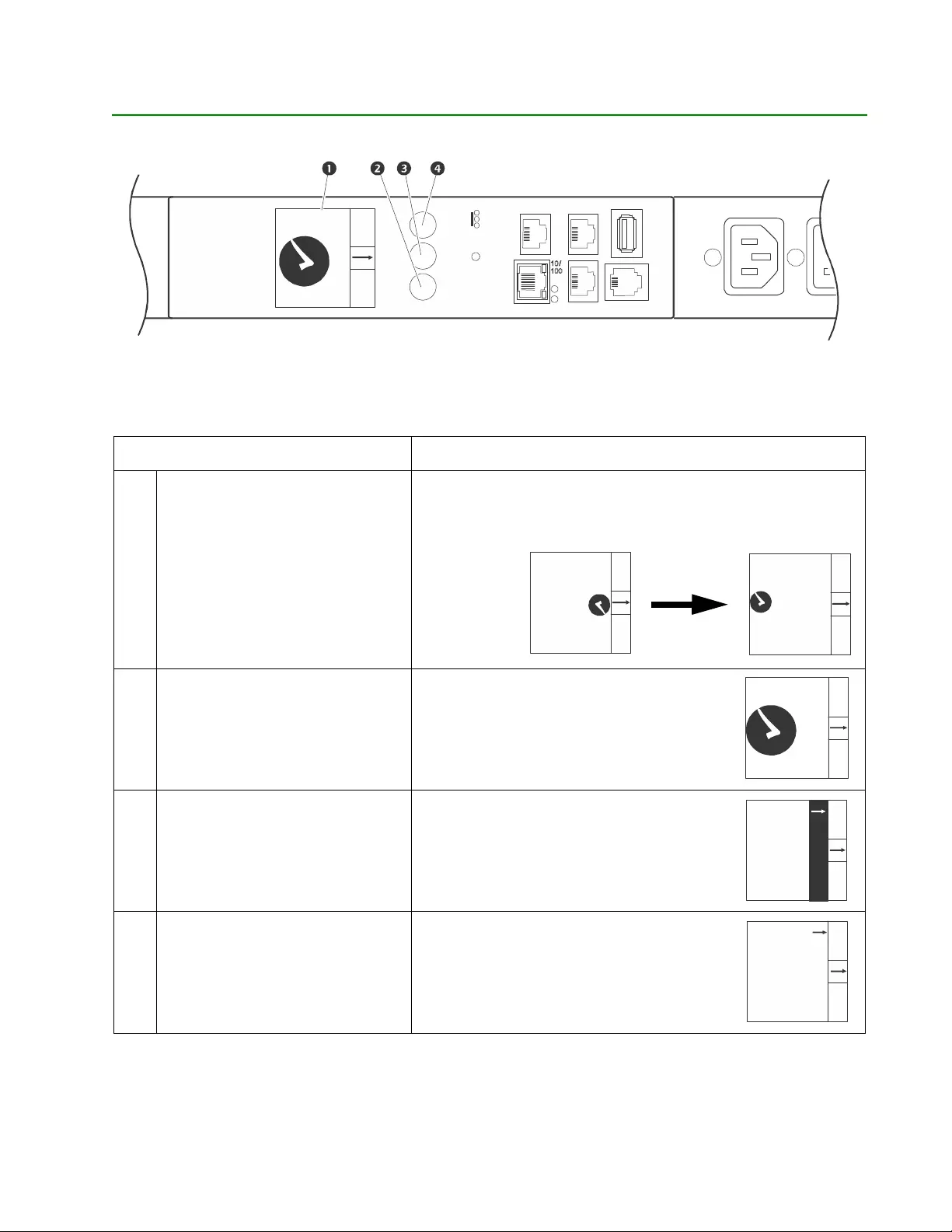
11Metered by Outlet with Switching Rack PDU AP86XX User Guide
Rack PDU Front Panel
NOTE: Your Rack PDU is configured so the display backlight turns off after 10 minutes of inactivity. The
backlight can be turned on by depressing any button below the display.
Item Function
Display
Shows information about the Rack PDU. In normal operation,
input voltage, current, and power refreshes every five seconds.
To reverse the text, select Display settings, scroll to Orientation
and press Select.
Main Menu button
Press to view the Rack PDU electrical input.
Scroll button
Press once to display the menu. Press
additional times to highlight the desired
menu option.
Select button
With a menu option highlighted, press the
Select button to display Rack PDU
information. (Network information is shown
at right.)
pdu0711a
Serial
Network
In
Out
Te m p / Hu m i di t
y
USB
Reset
Main
Menu
Select
Scroll
- Warning
- OK
- Overload
x
SELECT
MAIN
0
0
0
4.37 kW
pdu0713a
SELECT
MA
IN
0
24.5ºC
37.8%RH
Device Name
apc
12345678
pdu0712a
SELECT
MA
IN
0
24.5ºC
37.8%RH
Device Name
apc12345678
pdu0724a
SELECT
MA
IN
0
0
1.23 kW
pdu0714a
SELECT
MA
IN
Outlet Current
Temp/Humidity
Pha
se Info
Ne
twork
pdu0715a
SELECT
MA
IN
IPv4 Address
10.234.576.89

Metered by Outlet with Switching Rack PDU AP86XX User Guide12
Item Function
Load Indicator LEDs. Indicates the status of the Rack PDU load. See “Load indicator
LED” on page 13.
Temp/Humidity port. Port for connecting an optional APC by Schneider Electric
Temperature Sensor (AP9335T) or an optional APC by
Schneider Electric Temperature/Humidity Sensor (AP9335TH).
In and Out ports. For use with the Network Port Sharing feature.
USB port. For use with a flash drive for firmware upgrades - 5V @ 100ma.
Can also be used for downloading log files.
Outlet status LED. Illuminates green when the outlet is energized. (Each outlet has
an outlet LED.)
RJ-12 Serial Port. Port for connecting the Rack PDU to a terminal emulator
program for local access to the Command Line Interface. Use
the supplied serial cable (APC by Schneider Electric part
number 940-0144A).
10/100 Base-T Connector. Connects the Rack PDU to the network.
Network status LED. See “Network Status LED” on page 13.
10/100 LED. See “10/100 LED” on page 13.
Reset button. Resets the management interface without affecting the outlet
status.
pdu0740a
Serial
Network
In
Out
Te m p / Hu m i di t y
USB
Reset
Main
Menu
Select
Scroll
- Warning
- OK
- Overload
x
SELECT
MAIN
0
0
0
4.37 kW

13Metered by Outlet with Switching Rack PDU AP86XX User Guide
Network Status LED
10/100 LED
Load indicator LED
The load indicator LED identifies overload and warning conditions for the Rack PDU.
Condition Description
Off
One of the following situations exists:
• The Rack PDU is not receiving input power.
• The Rack PDU is not operating properly. It may need to be repaired or
replaced. Contact Customer Support.
Solid Green The Rack PDU has valid TCP/IP settings.
Solid Orange A hardware failure has been detected in the Rack PDU. Contact Customer
Support.
Flashing Green The Rack PDU does not have valid
TCP/IP
settings.
Flashing Orange The Rack PDU is making BOOTP requests.
Alternately flashing Green
and Orange
If the LED is flashing slowly, the Rack PDU is making DHCP2 requests1.
If the LED is flashing rapidly, the Rack PDU is starting up.
1. If you do not use a BOOTP or DHCP server, see “Establish Network Settings” on page 7 to configure the TCP/IP
settings of the Rack PDU.
2. To use a DHCP server, see “TCP/IP and Communication Settings” on page 136.
Condition Description
Off
One or more of the following situations exists:
• The Rack PDU is not receiving input power.
• The cable that connects the Rack PDU to the network is disconnected or
defective
• The device that connects the Rack PDU to the network is turned off.
• The Rack PDU itself is not operating properly. It may need to be repaired or
replaced. Contact Customer Support.
Solid Green The Rack PDU is connected to a network operating at 10 Megabits per second
(Mbps).
Solid Orange The Rack PDU is connected to a network operating at 100 Mbps.
Flashing Green The Rack PDU is receiving or transmitting data packets at 10 Mbps.
Flashing Orange The Rack PDU is receiving or transmitting data packets at 100 Mbps.
Condition Description
Solid Green OK. No near-overload (warning) or overload (critical) alarms are present.
Solid Yellow Warning. At least one near-overload (warning) alarm is present, but no
overload (critical) alarms are present.
Flashing Red Overload. At least one overload (critical) alarm is present.

Metered by Outlet with Switching Rack PDU AP86XX User Guide14
Example 1
Phase Info
Outlet Current
Te mp / Hu m i di t y
Network
Software Info
SKU/Serial #
Display Settings
RF Code Control
Log To Flash
MAIN SELECT
Main Menu
pdu0851a
NOTE:
The display screen is restricted to four lines per page. If there are more than four available
selections, they will appear on multiple pages. “Outlet Current” only appears on Metered-by-Outlet
and Metered-by-Outlet with Switching units. “Temp/Humidity” only appears when an AP9335T or
AP9335TH sensor is attached.
Phase Info
Outlet
Current
T/H
Network
SW Info
SKU/SN
Display
Settings
RF Code
Log To Flash
RPDU2G Monochrome LCD
Display Tree - Main Menu
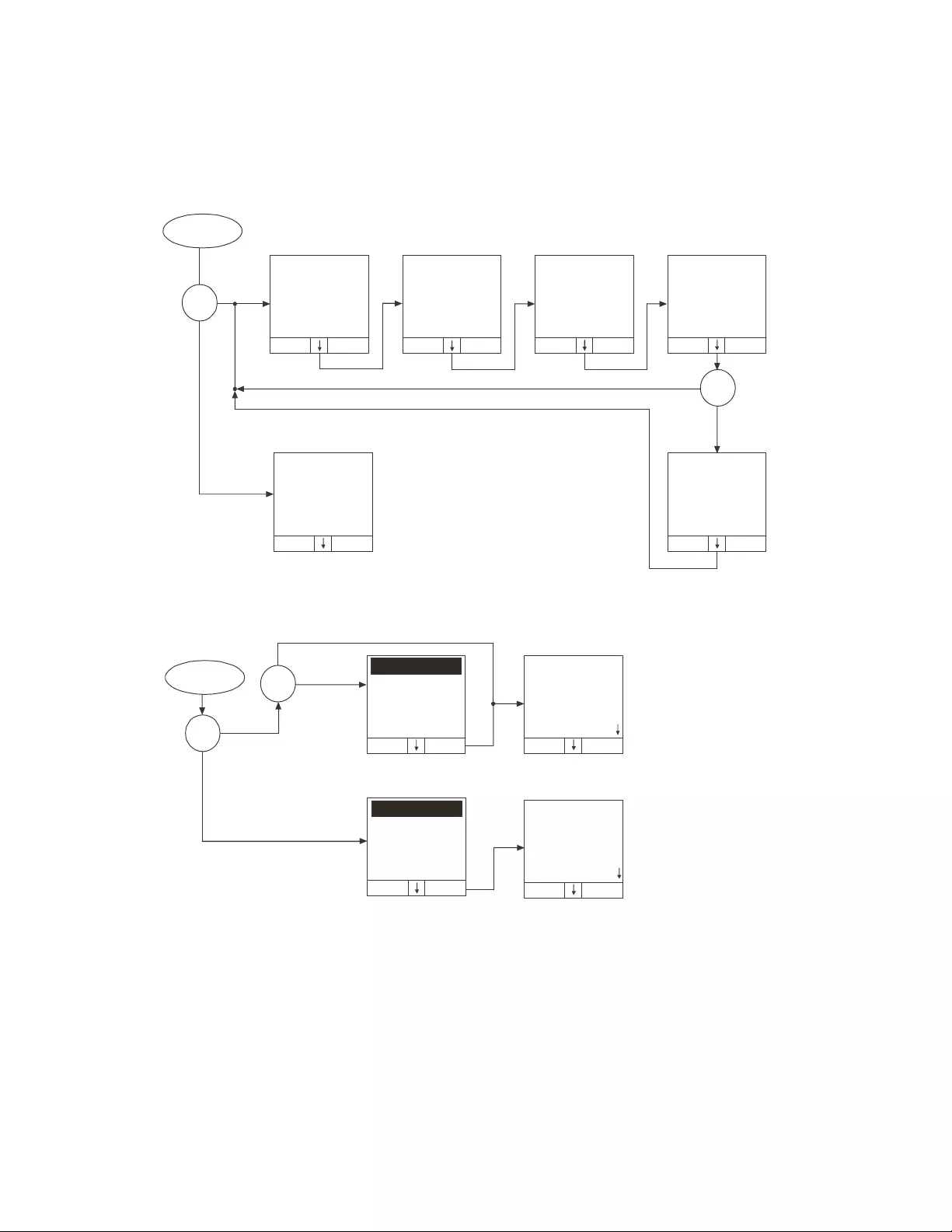
15Metered by Outlet with Switching Rack PDU AP86XX User Guide
Example 2
Phase 1
208.0 V
14.1 A
1.23 kW
MAIN SELECT
Phase 2
208.0 V
14.2 A
1.23 kW
MAIN SELECT
Phase 3
208.0 V
14.3 A
1.23 kW
MAIN SELECT
Phase Current
1: 14.1 A
2: 14.2 A
3: 14.3 A
MAIN SELECT
Phase Info
Voltage
L1-2: 208 V
L2-3: 208 V
L3-1: 208 V
MAIN SELECT
Input
208.0 V
14.1 A
1.23 kW
MAIN SELECT
MAIN SELECT
L1 Outlets
L2 Outlets
L3 Outlets
MAIN SELECT
YES
NO
pdu0850a
P
ress “Down” arrow
to cycle through
the outlets.
1
phase
P to P
outlets
YES
NO
Outlet Current
1
phase
> 1
bank
NO
YES
All Outlets
Bank 1 Outlets
Bank 2 Outlets
Outlet 1
1.2 A
10 W
to switch
MAIN SELECT
Phase 1
Outlet 1
1.2 A
10 W
MAIN SELECT
All Outlets
YES
NO
P
ress “Down” arrow
to cycle through
the outlets.
RPDU2G Monochrome LCD
Display Tree - Submenu 1
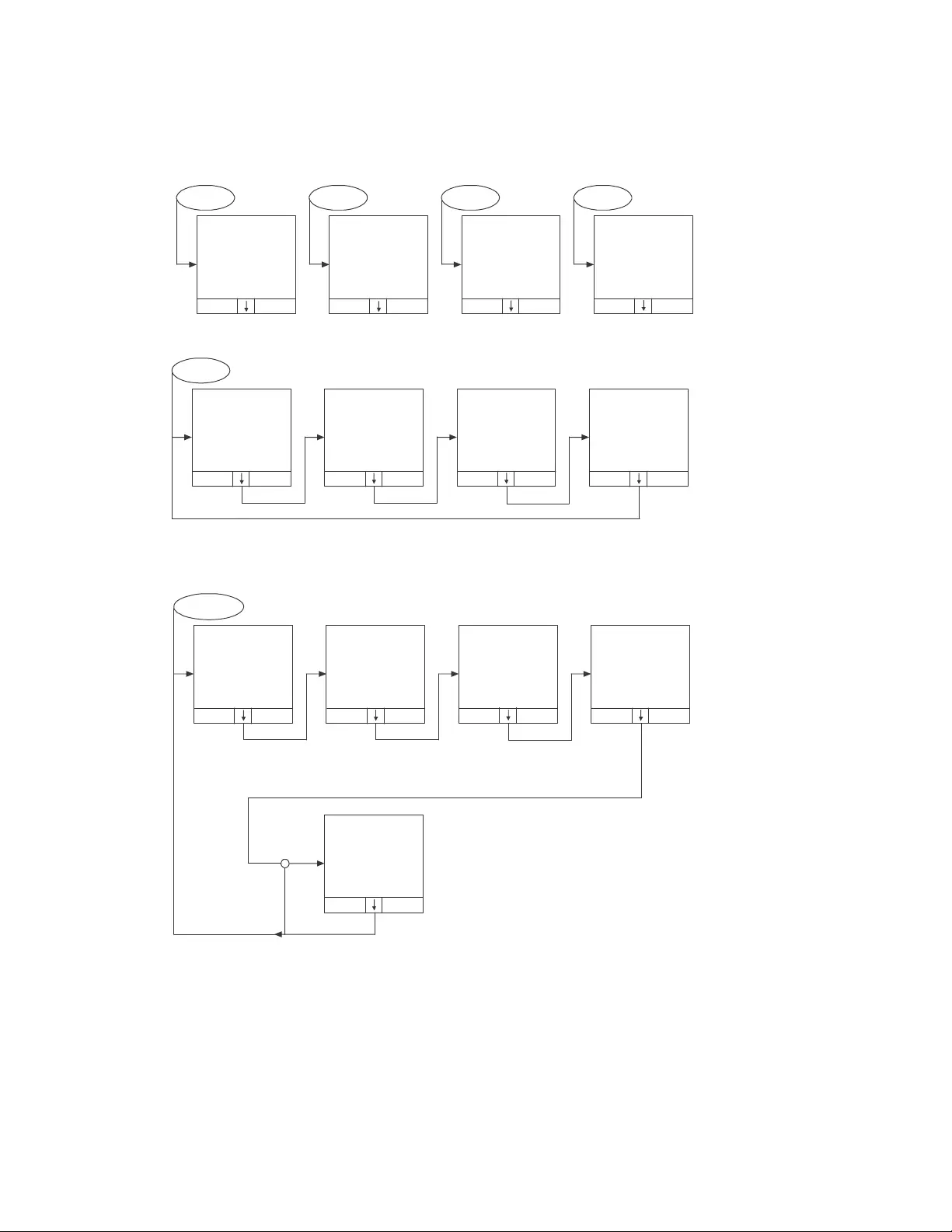
Metered by Outlet with Switching Rack PDU AP86XX User Guide16
Example 3
Sensor
Temp: 45.6°C
Hum: 37.8%RH
MAIN SELECT
Model
AP8xxx
Serial Number
ZAxxxxxxxxxx
MAIN SELECT
AOS
6.8.0
APP
6.8.0
MAIN SELECT
RF Code-Console
Disabled
Press “Select”
WILL REBOOT
MAIN SELECT
TH SKU/SN
SW Info RF Code
IPv4 Address
255.255.255.255
MAIN SELECT
IPv6 Address
1234:5678:9012:
3456:7890:1234:
5678:9012
MAIN SELECT
IPv6 Address
(scrolls
through each
IPv6 addr)
MAIN SELECT
MAC Address
00 00 00
00 00 00
MAIN SELECT
Network
LCD Contrast
5/9
Press “Select”
to adjust
MAIN SELECT
LCD Backlight
Auto-On
Press “Select”
to switch
MAIN SELECT
LCD Orientation
Normal
Press “Select”
to switch
MAIN SELECT
LCD Load
Graph
Press “Select”
to switch
MAIN SELECT
Disp Settings
Display ID
Hide
Press “Select”
to switch
MAIN SELECT
YES
NO
pdu0848a
Network Port
Share group?
P
ress “Select” to
show or hide the
display ID.
P
ress “Select” to
e
nable or disable.
Unit will reboot.
Press “Select” to
increment contrast. Press “Select” to
switch on or off. Press “Select” to
change orientation.
Press “Select” to
change display
style of load.
RPDU2G Monochrome LCD
Display Tree - Submenu 2
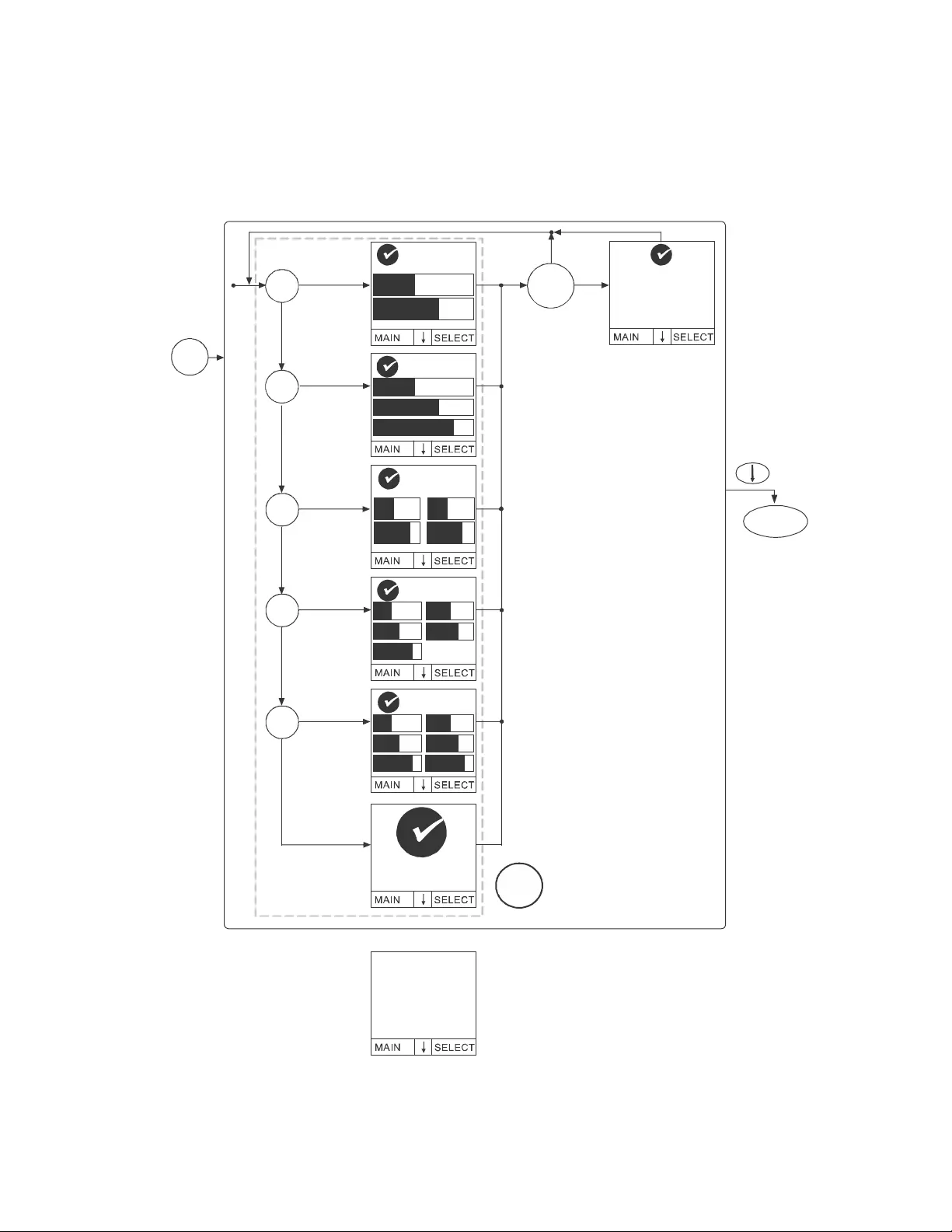
17Metered by Outlet with Switching Rack PDU AP86XX User Guide
Example 4
pdu0720a
Bank Current
1: 10.5 A
2: 10.6 A
NOTE:
Numeric and graph pages will not display
if no bank exists. A total device power page will
be added when using the numeric load display if
banks exist on your equipment.
MAIN
3 bank
2 bank
1.23 kW
1
2
1
2
Yes
No
Yes
Yes
Yes
Yes
NoNoNo
4 bank
5 bank
6 bank
1.23 kW
No
Yes
Sensor
24.5ºC
37.8%RH
Device Name
apc12345678
Main
Menu
1.23 kW
1
2
3
4
1.23 kW
1
2
3
4
5
1.23 kW
1
2
3
4
5
6
1.23 kW
Device
Load
RPDU2G Monochrome LCD
Display Tree - Monitor
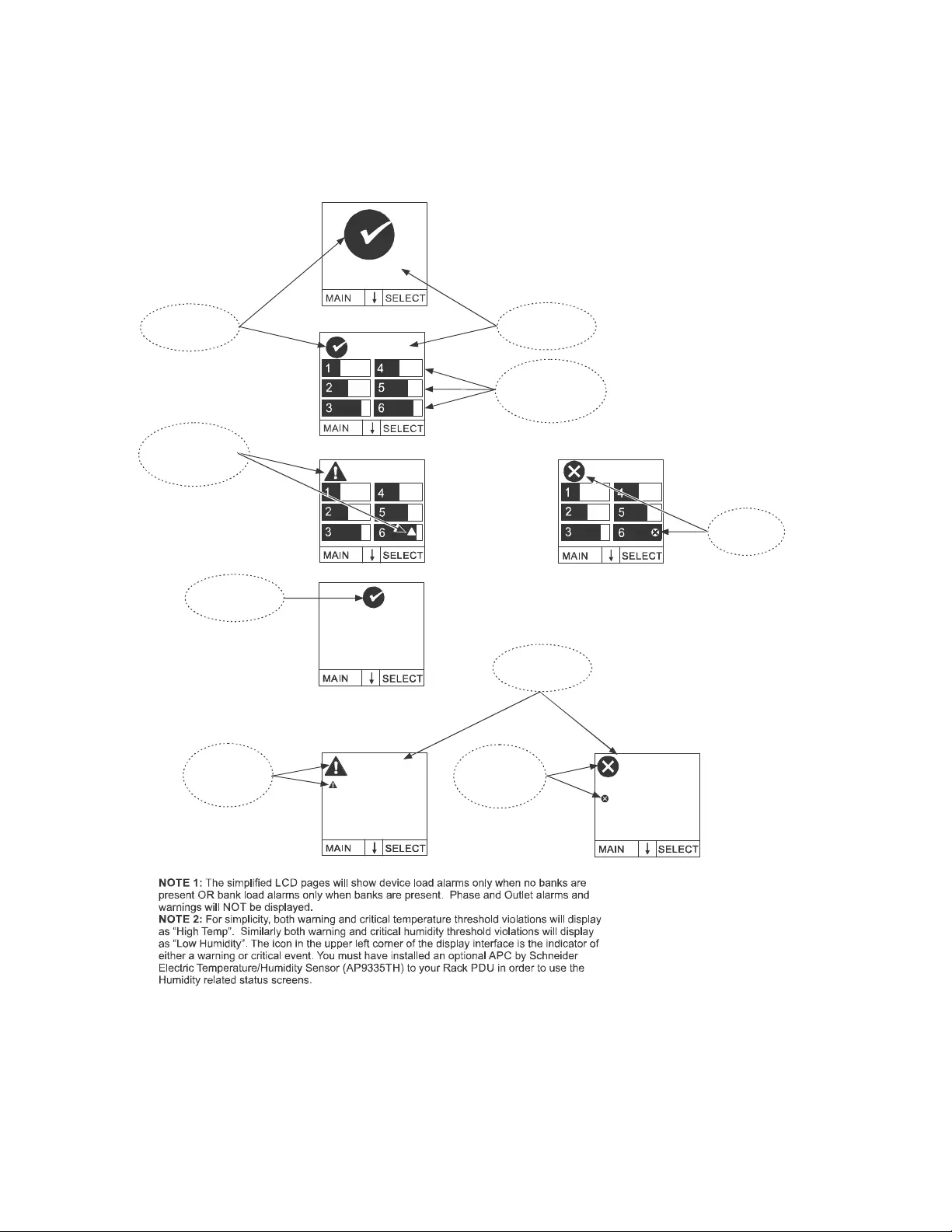
Metered by Outlet with Switching Rack PDU AP86XX User Guide18
Example 5
pdu0721a
Normal Status
Indicator
Device Load
Reading
Bank Load Graphs
(No Indicator =
Normal Status)
Warning
(Near Overload
or Low Load)
Indicator
Critical
(Overload)
Indicator
Normal
Sensor Status
Indicator
Warning
Threshold
Violation
Indicator
Critical
Threshold
Violation
Indicator
Most Critical
Sensor Status
(see NOTE 1)
1.23 kW
1.23 kW
5.67 kW
24.5ºC
37.8% RH
Device Name
apc12345678
7.89 kW
59.0ºC
30.0% RH
Device Name
apc12345678
High Temp
25.0ºC
10.0% RH
Device Name
apc12345678
Low Humidity
RPDU2G Monochrome LCD
Display Tree - Monitor Status Indicators
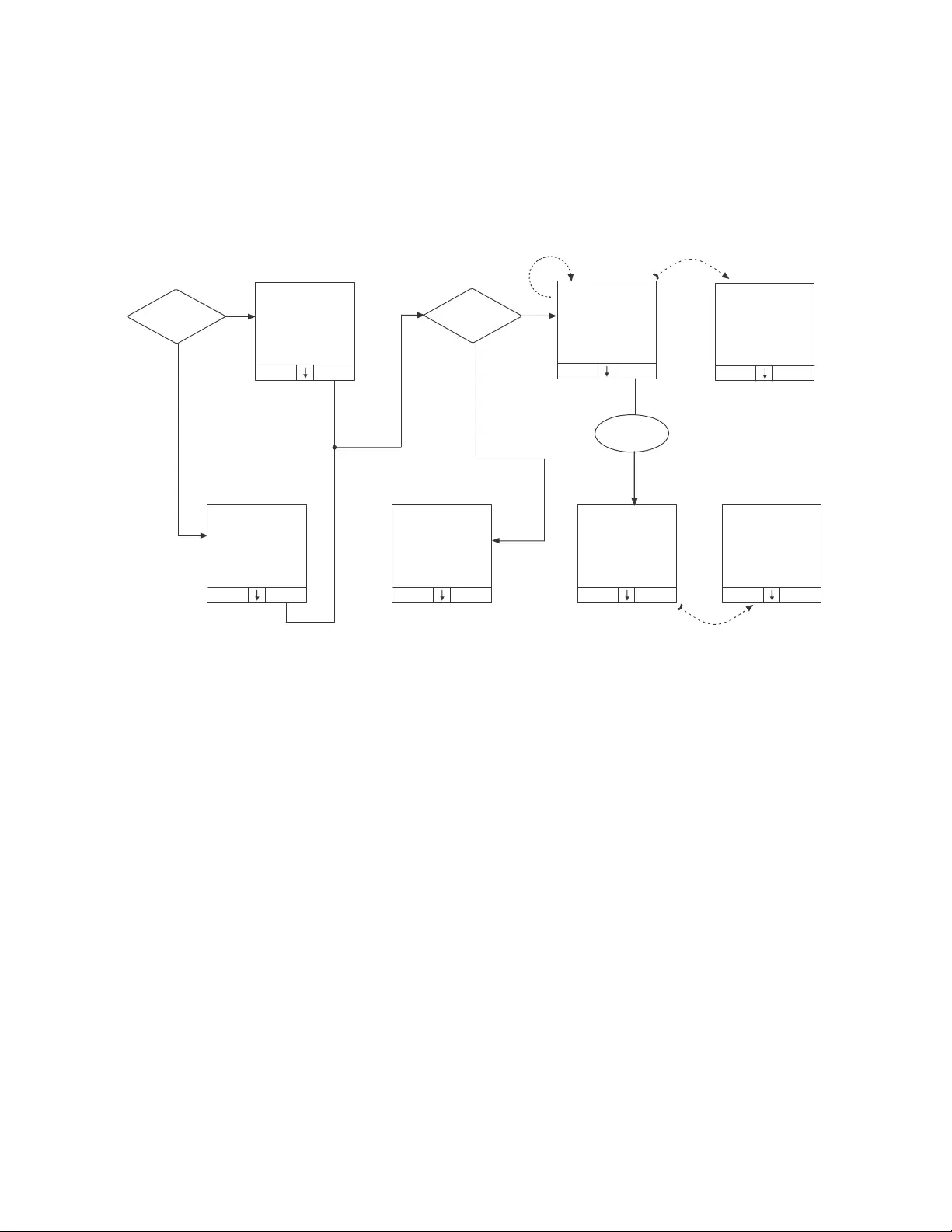
19Metered by Outlet with Switching Rack PDU AP86XX User Guide
Example 6
pdu0849a
Log to Flash
Press “Select” to start
Completed
Logs export
completed
Has export
recorded?
YES
NO
Log to Flash
Press “Select” to start
No previous records
USB Flash
detected?
Y
ES
NO
Log to Flash
Press “Select” to
Abort
12% Completed
Exporting Logs
Log to Flash
Press “Select” to start
Failed
No USB Detected
Press
“Select”
Auto refresh
percentage
Press
“Select” to
Abort
Log to Flash
Press “Select” to
Abort
Aborting . . .
Please wait
Log to Flash
Press “Select” to Start
Aborted
Logs export aborted
C
onfirmation screen displays
automatically on completion
C
onfirmation screen displays
automatically on completion
Log to Flash
Press “Select” to start
Completed
Logs export
completed
Idle State Export Started
MAIN SELECT MAIN SELECT
MAIN SELECT
MAIN SELECTMAIN SELECT
MAIN SELECT MAIN SELECT
RPDU2G Monochrome LCD
Display Tree - Log to Flash

Metered by Outlet with Switching Rack PDU AP86XX User Guide20
Command Line Interface
About the Command Line Interface (CLI)
You can use the Command Line Interface to view the status of and configure and manage the Rack PDU (and
any connected Rack PDUs, if using the Network Port Sharing Feature). In addition, the Command Line
Interface enables you to create scripts for automated operation. You can configure all parameters of a Rack
PDU (including those for which there are not specific CLI commands) by using the CLI to transfer an INI file to
the Rack PDU. The CLI uses XMODEM to perform the transfer, however, you cannot read the current INI file
through XMODEM.
Log on to the CLI
To access the Command Line Interface, you can use either a local (serial) connection or a remote (Telnet or
SSH) connection with a computer on the same network as the Rack PDU.
Local access to the Command Line Interface
For local access, use a computer that connects to the Rack PDU through the serial port to access the
Command Line Interface:
1. Select a serial port at the computer and disable any service that uses that port.
2. Connect the serial cable (Schneider Electric part number 940-0144A) from the selected serial
port on the computer to the Serial port on the Rack PDU.
3. Run a terminal program (e.g., Tera Term or HyperTerminal) and configure the selected port for
9600 bps, 8 data bits, no parity, 1 stop bit, and no flow control.
4. Press
E
NTER
. It may take multiple (up to three) attempts to get a prompt to appear. At the prompt,
enter your user name and password (by default, apc and apc for the Super User). If this is your
first log on, you will be prompted to change the default password.
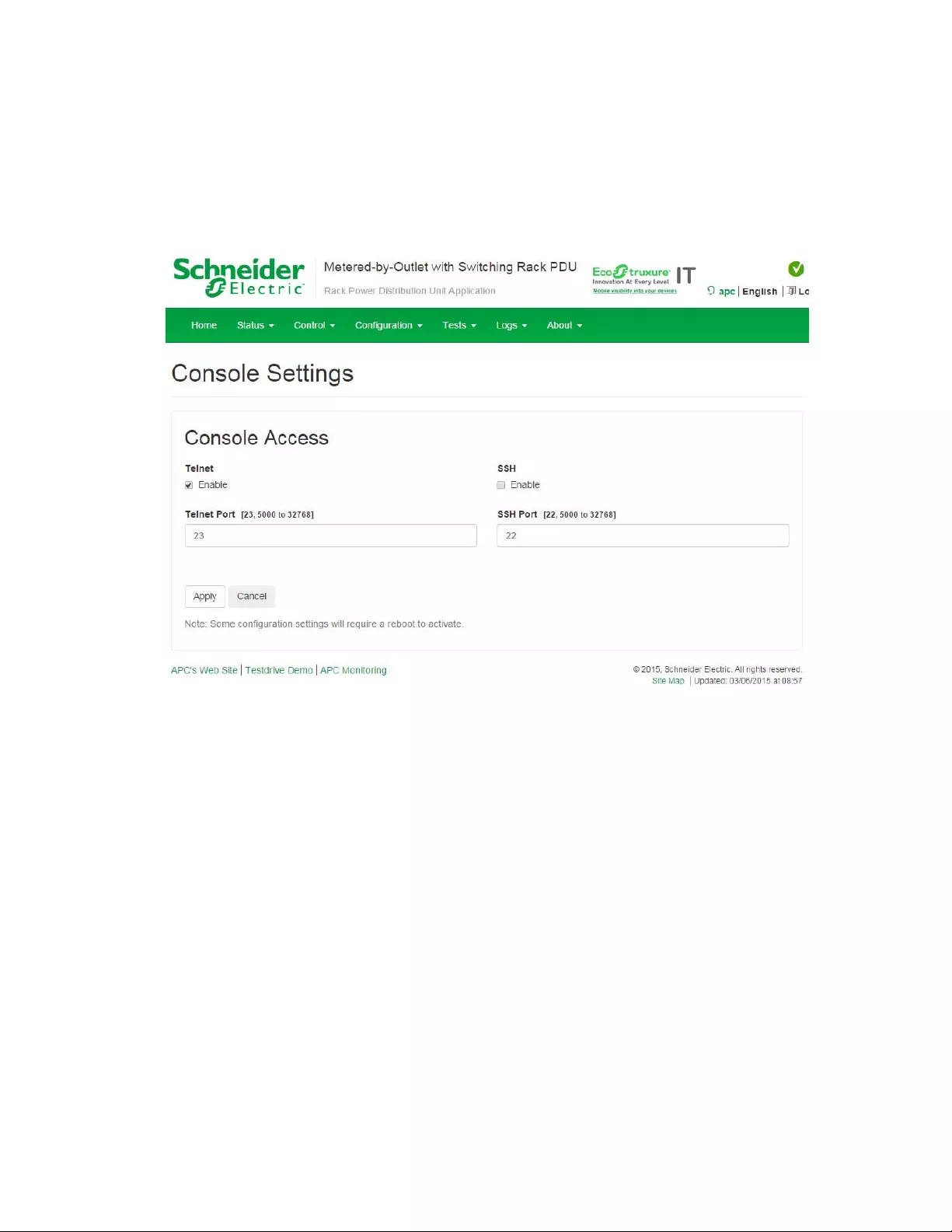
21Metered by Outlet with Switching Rack PDU AP86XX User Guide
Remote access to the Command Line Interface
You can choose to access the Command Line Interface remotely through Telnet and/or SSH. SSH is enabled
by default.
You can use the console command (page 34) to enable or disable either Telnet or SSH.
If needed, you can also use the Web UI to enable or disable either Telnet or SSH. On the Configuration tab,
select Network from the menu to open the Console Access page. Click to check the desired Enable box.
Click Apply to save your changes or Cancel to leave the page.
Telnet for basic access: :
Telnet provides the basic security of authentication by user name and password,
but not the high-security benefits of encryption. Telnet is disabled by default.
To use Telnet to access the Command Line Interface:
1. From a computer that has access to the network on which the Rack PDU is installed, at a
command prompt, type telnet and the IP address for the Rack PDU (for example, telnet
139.225.6.133, when the Rack PDU uses the default Telnet port of 23), and press
ENTER
.
If the Rack PDU uses a non-default port number (from 5000 to 32768), you must include a colon
or a space, depending on your Telnet client, between the IP address (or DNS name) and the port
number. (These are commands for general usage: Some clients do not allow you to specify the
port as an argument and some types of Linux might want extra commands).
2. Enter the user name and password (by default, apc and apc for the Super User).
If you cannot remember your user name or password, see “Recovering from a Lost Password” on
page 10.
SSH for high-security access:
If you use the high security of SSL/TLS for the Web UI, use SSH for
access to the Command Line Interface. SSH encrypts user names, passwords, and transmitted data. The
interface, user accounts, and user access rights are the same whether you access the Command Line
Interface through SSH or Telnet, but to use SSH, you must first configure SSH and have an SSH client
program installed on your computer. SSH is enabled by default.

Metered by Outlet with Switching Rack PDU AP86XX User Guide22
About the Main Screen
Following is an example of the main screen, which is displayed when you log on to the Command Line
Interface of a Rack PDU.
• Two fields identify the operating system (AOS) and application (APP) firmware versions. The
application firmware name identifies the type of device that connects to the network. In the
example above, the application firmware for the Rack PDU is displayed.
Network Management Card AOS vx.x.x
RPDU 2g vx.x.x
• Three fields identify the system name, contact person, and location of the Rack PDU.
Name : Test Lab
Contact : Don Adams
Location : Building 3
Schneider Electric Network Management Card AOS vx.x.x
(c) Copyright 2019 All Rights Reserved RPDU 2g APP vx.x.x
--------------------------------------------------------------------------------------
Name : Test Lab Date : 06/30/2019
Contact : Don Adams Time : 05:58:30
Location : Building 3 User : Administrator
Up Time : 0 Days 21 Hours 21 Minutes Stat : P+ N4+ N6+ A+
--------------------------------------------------------------------------------------
IPv4 : Enabled IPv6 : Enabled
Ping response : Enabled
--------------------------------------------------------------------------------------
HTTP : Disabled HTTPS
: Enabled
FTP : Disabled Telnet : Disabled
SSH/SCP
: Enabled
SNMPv1 : Disabled
SNMPv3 : Disabled
--------------------------------------------------------------------------------------
Super User
: Enabled
RADIUS : Disabled
Administrator : Disabled Device User : Disabled
Read-only User : Disabled Network-Only User : Disabled
Type ? For command listing
Use tcpip for IP address (-i), subnet (-s), and gateway (-g)
apc>

23Metered by Outlet with Switching Rack PDU AP86XX User Guide
• An Up Time field reports how long the Rack PDU Management Interface has been running since
it was last turned on or reset.
Up Time: 0 Days 21 Hours 21 Minutes
• Two fields identify when you logged in, by date and time.
Date: 06/30/2019
Time: 05:58:30
• The User field identifies whether you logged in through the Super User, Administrator or Device
Manager account.
User: Administrator
• A
Stat field reports the Rack PDU status.
Stat:P+ N4+ N6+ A+
NOTE: If P+ is not displayed, contact the Schneider Electric Customer Care Center.
• The remaining fields show which protocols and user accounts are enabled.
P+ The APC operating system (AOS) is functioning properly.
IPv4
only
IPv6
only
IPv4 and
IPv6* Description
N+ N+ N4+ N6+ The network is functioning properly.
N? N6? N4? N6? A BOOTP request cycle is in progress.
N– N6- N4- N6- The Rack PDU failed to connect to the network.
N! N6! N4! N6! Another device is using the Rack PDU IP address.
* The N4 and N6 values can be different from one another: you could, for
example, have N4- N6+.
A+ The application is functioning properly.
A– The application has a bad checksum.
A? The application is initializing.
A! The application is not compatible with the AOS.

Metered by Outlet with Switching Rack PDU AP86XX User Guide24
Using the CLI
At the Command Line Interface, you can use commands to configure the Rack PDU. To use a command, type
the command and press
ENTER
. Commands and arguments are valid in lowercase, uppercase, or mixed case.
Options are case-sensitive.
While using the Command Line Interface, you can also do the following:
• Type ? and press
ENTER
to view a list of available commands, based on your account type.
• To obtain information about the purpose and syntax of a specified command, type the command,
a space, and ? or the word help. For example, to view RADIUS configuration options, type:
radius ?
or
radius help
• Press the
UP
arrow key to view the command that was entered most recently in the session. Use
the
UP
and
DOWN
arrow keys to scroll through a list of up to ten previous commands.
• Type at least one letter of a command and press the
TAB
key to scroll through a list of valid
commands that match the text you typed in the command line.
• Type exit or quit to close the connection to the Command Line Interface.

25Metered by Outlet with Switching Rack PDU AP86XX User Guide
Command Syntax
Example of a command that supports multiple options:
ftp [-p <port number>] [-S <enable | disable>]
In this example, the ftp command accepts the option -p, which defines the port number, and the option -S,
which enables or disables the FTP feature.
To change the FTP port number to 5010, and enable FTP:
1. Type the ftp command, the port option, and the argument 5010:
ftp -p 5010
2. After the first command succeeds, type the ftp command, the enable/disable option, and the
enable selection:
ftp -S enable
Example of a command that accepts mutually exclusive arguments for an option:
alarmcount -p [all | warning | critical]
In this example, the option -p accepts only three arguments: all, warning, or critical. For example, to view the
number of active critical alarms, type:
alarmcount -p critical
The command will fail if you type an argument that is not specified.
Item Description
- Options are preceded by a hyphen.
< > Definitions of options are enclosed in angle brackets. For example:
-dp <device password>
[ ] If a command accepts multiple options or an option accepts mutually
exclusive arguments, the values may be enclosed in brackets.
|A vertical line between items enclosed in brackets or angle brackets indicates
that the items are mutually exclusive. You must use one of the items.

Metered by Outlet with Switching Rack PDU AP86XX User Guide26
Command Response Codes
The command response codes enable scripted operations to detect error conditions reliably without having to
match error message text:
The CLI reports all command operations with the following format:
E [0-9] [0-9] [0-9] : Error message
Code Message Code Message
E000 Success E200 Input Error
E001 Successfully Issued E201 No Response
E002 Reboot required for change to take effect E202 User already exists
E100 Command failed E203 User does not exist
E101 Command not found E204 User does not have access to this
command
E102 Parameter Error E205 Exceeds Maximum Users
E103 Command Line Error E206 Invalid value
E104 User Level Denial E207 Outlet Command Error: Device not
initialized.
E105 Command Prefill E208 Outlet Command Error: Previous
command is pending.
E106 Data Not Available E209 Outlet Command Error: Database rejected
request.
E107 Serial communication with the
Rack
PDU
has been lost E210 Outlet Command Error: Outlet restricted.
E108 EAPoL disabled due to invalid/encrypted
certificate.

27Metered by Outlet with Switching Rack PDU AP86XX User Guide
CLI Commands for Rack PDUs by SKU/type
AP71XXB: InLine Current Meter
AP88XX: Metered Rack PDU (vertical)
APF88XX Configurable Metered Rack PDU
AP78XXB: Metered Rack PDU (horizontal)
AP86XX: MBO with Switching (vertical)
APF86XX: Configurable MBO with Switching
AP79XXB: Switched Rack PDU (horizontal)
AP84XX: MBO Rack PDU (vertical)
APF84XX: Configurable MBO Rack PDU
AP89XX: Switched Rack PDU
APF89XX: Configurable Switched Rack PDU
Command Description
alarmList Display the alarms that are present on the device or another device in a
Network Port Sharing group.
xxxxx xx
bkLowLoad Set or read the bank low load threshold. x x x x x x
bkNearOver Set or read the bank near overload threshold. x x x x x x
bkOverLoad Set or read the bank overload threshold x x x x x x
bkPeakCurr Read the bank peak current. x x x x x x
bkReading Displays a reading/measurement from a bank(s). x x x x x x
bkRestrictn Set or read the overload restriction feature to prevent outlets from turning
on when the overload alarm threshold is violated.
xxx
devLowLoad Set or read the device low load warning threshold. x x x x
devNearOver Set or read the device near overload threshold. x x x x
devOverLoad Set or read the device overload threshold. x x x x
devPeakLoad Display the device peak load. x x x x
devReading Displays the total power or energy the device is drawing. x x x x
devStartDly Set or read the device cold start delay. x x x
dispID Set or read the Display ID. x x x x
energyWise Configuration Options x x x x x x x
humAlGen Set or read whether humidity alarms are enabled or disabled. x x x x
humHyst Set or read the humidity hysteresis value. x x x x
humLow Set or read the low humidity threshold. x x x x
humMin Set or read the minimum humidity threshold. x x x x
humReading Display the humidity reading from the sensor. x x x x
lcd Control the LCD Display. x x x x
lcdBlink Blink the LCD Display. xxxx
logToFlash Backup log files to USB flash. x x x x
olAssignUsr Assign outlets to a user that exists in the local database. x x x x
olCancelCmd Cancel all pending commands for an outlet or group of outlets. x x x
olDlyOff Turns off an outlet or group of outlets after power off delay. x x x
olDlyOn Turns on an outlet or group of outlets after power on delay. x x x
olDlyReboot Delayed Cycle power to an outlet or a group of outlets. x x x
olGroups List the outlet synchronization groups defined on the switched rack PDU. x x x
olLowLoad Set or view the outlet low-load threshold in kilowatts.xx
olName Set or display a name assigned to an outlet. x x x x
olNearOver Set or view the outlet near-overload threshold in kilowatts. x x

Metered by Outlet with Switching Rack PDU AP86XX User Guide28
olOff Turn an outlet or group of outlets off. x x x
olOffDelay Set or read the power off delay time. x x x
olOn Turn an outlet or group of outlets on. x x x
olOnDelay Set or read the power on delay time. x x x
olOverLoad Set or view the outlet overload threshold in kilowatts. x x
olPeakLoad Display the peak current measurement from a bank(s). x x
olRbootTime Set or read the outlet reboot duration time. x x x
olReading Displays a reading/measurement from an outlet or a group of outlets. x x
olReboot Cycles power to an outlet or group of outlets. x x x
olStatus Display the status of selected outlets. x x x
olType Displays the type and rating of selected outlets. x x x
olUnasgnUsr Unassign outlets to a user that exists in the local database. x x x x
phBal *Set or read the phase load balance threshold. x x x x
phBalAlGen *Set or read whether phase load balance alarms are enabled or disabled. x x x x
phLowLoad Set or read the phase low load threshold. x x x x x x x
phNearOver Set or read the phase near overload threshold. x x x x x x x
phOverLoad Set or read the phase overload threshold. x x x x x x x
phPeakCurr Read the peak current reading/measurement from a phase(s). x x x x x x x
phReading View the current, voltage, or power for a phase. x x x x x xx
phRestrictn Set or read the overload restriction feature to prevent outlets from turning
on when the overload alarm threshold is violated.
xxx
phTophVolts Read the phase-to-phase voltage on 3-phase devices. x xxx
prodInfo Displays information about the rack PDU x x x x x x x
sensorName Set or display the name assigned to the temperature or temperature/
humidity sensor.
xxxx
tempAlGen Set or read whether temperature alarms are enabled or disabled. x x x x
tempHigh Set or read the temperature high threshold. x x x x
tempMax Set or read the temperature max threshold. x x x x
tempHyst Set or read the temperature threshold hysteresis value. xxxx
tempPeak Display the peak temperature reading of the sensor. x x x x
tempReading Display the temperature reading from the sensor. x x x x
tempStatus Display the status of the sensor. x x x x
userAdd Add an outlet user to the local user database. x x x x
userDelete Remove an outlet user from the local user database. x x xx
userList List the users and outlets assigned to them. x x x x
userPasswd Set a user password. x x x x
*Phase balance commands only applies to models with two or more metered phases.
Command Description

29Metered by Outlet with Switching Rack PDU AP86XX User Guide
Network Management Card Command Descriptions
? or help
Access:
Super User, Administrator, Device User, Read Only
Description:
View a list of all the CLI commands available to your account type. To view help text for a
specific command, type the command followed by a question mark.
Parameters:
[<command>]
Example 1:
apc> ?
Network Management Card Commands:
---------------------------------------------------------------------
Example 2:
apc> help boot
Usage: boot -- Configuration Options
boot [-b <dhcpBootp | dhcp | bootp | manual>] (Boot Mode)
[-a <remainDhcpBootp | gotoDhcpOrBootp>] (After IP
Assignment)
[-o <stop | prevSettings>] (On Retry Fail)
[-c <enable | disable>] (Require DHCP Cookie)
[-s <retry then stop #>] (Note: 0 = never)
[-f <retry then fail #>] (Note: 0 = never)
[-v <vendor class>]
[-i <client id>]
[-u <user class>]
Error Message:
E000, E102
? about alarmcount boot bye cd
cipher clrrst console date delete dir
dns eapos email eventlog exit firewall
format ftp hhelp lang lastrst ledblink
pwd quit radius reboot resetToDef session
smtp snmp snmptrap snmpv3 system tcpip
tcpip6 user userdflt web whoami xferINI
xferstatus

Metered by Outlet with Switching Rack PDU AP86XX User Guide30
about
Access:
Super User, Administrator, Device User, Read Only
Description:
Displays system information (Model Number, Serial Number, Manufacture Dates, etc.)
Parameters:
None
Example:
apc> about
E000: Success
Hardware Factory
---------------
Model Number: APXXXX
Serial Number: ST0913012345
Hardware Revision: HW05
Manufacture Date: 06/30/2019
MAC Address: 00 05 A2 18 00 01
Management Uptime: 0 Days 21 Hours 21 Minutes
Error Message:
E000
alarmcount
Access:
Super User, Administrator, Device User, Read Only
Description:
Displays alarms present in the system.
Parameters:
Example:
To view all active warning alarms, type:
apc> alarmcount
E000: Success
AlarmCount: 0
Error Message:
E000, E102
Option Argument Description
-p
all View the number of active alarms reported by the Rack PDU.
Information about the alarms is provided in the event log.
warning View the number of active warning alarms.
critical View the number of active critical alarms.

31Metered by Outlet with Switching Rack PDU AP86XX User Guide
boot
Access:
Super User, Administrator
Description:
Allows the user to get/set the network startup configuration of the device, such as setting boot
mode (DHCP vs BOOTP vs MANUAL).
Parameters:
Example:
Using a DHCP server to obtain network settings:
apc> boot
E000: Success
Boot Mode: manual
Non-Manual Mode Shared Settings
-------------------------------
Vendor class: <device class>
Client id: XX XX XX XX XX XX
User class: <user class>
After IP assignment: gotoDhcpOrBootp
DHCP Settings
-------------
Retry then stop: 4
DHCP cookie is: enable
BOOTP Settings
--------------
Retry then fail: never
On retry failure: prevSettings
Error Message:
E000, E102
Optio
nArgument Description
-b
<boot
mode> dhcp | bootp | manual
Define how the TCP/IP settings will be configured when
the Rack PDU turns on, resets, or restarts. See “TCP/IP
and Communication Settings” on page 136 for
information about each boot mode setting.
-c [<enable | disable>]
(Require DHCP Cookie)
dhcp and dhcpBootp boot modes only. Enable or
disable the requirement that the DHCP server provide the
APC cookie.
-v [<vendor class>] Vendor Class is APC
-i [<client id>] The MAC address of the Rack PDU’s NMC, which
uniquely identifies it on the network.
-u [<user class>] The name of the application firmware module.

Metered by Outlet with Switching Rack PDU AP86XX User Guide32
cd
Access:
Super User, Administrator, Device User, Outlet User, Read Only
Description:
Allows the user to set the working directory of the file system. The working directory is set back
to the root directory ‘/’ when the user logs out of the CLI.
Parameters:
<dicrectory name>
Example:
apc> cd logs
E000: Success
apc> cd /
E000: Success
Error Message:
E000, E102
cipher
Access:
Super User, Administrator
Description:
Enable or disable cryptographic algorithms for Web UI sessions. You cannot enable or disable
these algorithms directly from the Web UI. You must reboot your appliance after enabling or disabling
algorithms for changes to take effect.
There are three categories of algorithms: Authentication algorithms, Block Cipher algorithms, and MAC
algorithms. Available and Blocked Cipher Suites are also listed.
NOTE: Disabling the only algorithm will block all SSL/TLS sessions.
Parameters:
Example 1:
Disable the triple-DES block cipher.
apc> cipher -3des disable
E002: Success
Reboot required for change to take effect.
Option Argument Description
-3des <enable | disable> Triple-DES
-aes <enable | disable> AES
-dh <enable | disable> DH
-rsake <enable | disable> RSA Key Exchange
-rsaau <enable | disable> RSA Authentication
-sha1 <enable | disable> SHA
-sha2 <enable | disable> SHA256
-ecdhe <enable | disable> ECDHE

33Metered by Outlet with Switching Rack PDU AP86XX User Guide
Example 2:
Retrieve a list of each available cryptographic algorithm and its status.
apc> cipher
E000: Success
Key Exchange Algorithms
-----------------------
DH enabled
RSA Key Exchange enabled
ECDHE enabled
Authentication Algorithms
-------------------------
RSA Authentication enabled
Cipher Algorithms
-----------------
triple-DES enabled
AES enabled
MAC Algorithms
--------------
SHA enabled
SHA256 enabled
Available Cipher Suites
-----------------------
1 TLS_ECDHE_ECDSA_WITH_AES_128_CBC_SHA
2 TLS_ECDHE_ECDSA_WITH_AES_256_CBC_SHA
3 TLS_ECDHE_RSA_WITH_AES_128_CBC_SHA
4 TLS_ECDHE_RSA_WITH_AES_256_CBC_SHA
5 TLS_DHE_RSA_WITH_3DES_EDE_CBC_SHA
6 TLS_DHE_RSA_WITH_AES_128_CBC_SHA
7 TLS_DHE_RSA_WITH_AES_128_CBC_SHA256
8 TLS_DHE_RSA_WITH_AES_256_CBC_SHA
9 TLS_DHE_RSA_WITH_AES_256_CBC_SHA256
10 SSL_RSA_WITH_3DES_EDE_CBC_SHA
11 TLS_RSA_WITH_AES_128_CBC_SHA
12 TLS_RSA_WITH_AES_256_CBC_SHA
13 TLS_RSA_WITH_AES_128_CBC_SHA256
14 TLS_RSA_WITH_AES_256_CBC_SHA256
Blocked Cipher Suites
---------------------
(the settings above disable the suites listed here)
None
Error Message:
E000, E102

Metered by Outlet with Switching Rack PDU AP86XX User Guide34
clrrst
Access:
Super User, Administrator
Description:
Clear reset reason.
Example:
None
Error Message:
None
console
Access:
Super User, Administrator
Description:
Define whether users can access the Command Line Interface using Telnet, which is disabled
by default, or Secure SHell (SSH), which is enabled by default and provides protection by transmitting user
names, passwords, and data in encrypted form. You can change the Telnet or SSH port setting for additional
security. Alternately, disable network access to the Command Line Interface.
Parameters:
Example 1:
To enable SSH access to the Command Line Interface, type:
console -S ssh
Example 2:
To change the Telnet port to 5000, type:
apc> console
E000: Success
Telnet: enabled
SSH: disabled
Telnet Port: 23
SSH Port: 22
Baud Rate: 9600
Error Message:
E000, E102
Option Argument Description
-S <enable | disable>]
(ssh) Enable or Disable SSH access to the device. Enabling
SSH enables SCP.
-t <enable | disable>]
(telnet) Enable or Disable Telnet access to the device.
-pt <telnet port n> Define the Telnet port used to communicate with the
Rack PDU (23 by default).
-ps <SSH port n> Define the SSH port used to communicate with the Rack
PDU (22 by default).
-b 2400 | 9600 | 19200 |
38400 Configure the speed of the serial port connection (9600
bps by default).

35Metered by Outlet with Switching Rack PDU AP86XX User Guide
date
Access:
Super User, Administrator
Definition:
Get and set the date and time of the system.
To configure an NTP server to define the date and time for the Rack PDU, see “Date/Time screen” on
page 153.
Parameters:
Example 1:
To display the date using the format yyyy-mm-dd, type:
date -f yyyy-mm-dd
Example 2:
To define the date as Aug 30, 2018, using the format configured in the preceding example, type:
date -d “2018-08-30”
Example 3:
To define the time as 5:21:03 p.m., type:
date -t 17:21:03
Error Message:
E000, E100, E102
delete
Access:
Super User, Administrator
Description:
Delete a file in the file system.
Parameters:
Example:
apc> delete /db/prefs.dat
E000: Success
Error Messages:
E000, E102
Option Argument Description
-d <“datestring”> Set the current date. The format must match the current -f setting.
-t <00:00:00> Configure the current time, in hours, minutes, and seconds. Use the
24-hour clock format.
-f
mm/dd/yy |
dd.mm.yyyy |
mmm-dd-yy |
dd-mmm-yy |
yyyy-mm-dd
Select the numerical format in which to display all dates in this user
interface. Each letter m (for month), d (for day), and y (for year)
represents one digit. Single-digit days and months are displayed with a
leading zero.
-z <time zone
offset> Set the difference with GMT in order to specify your time zone. This
enables you to synchronize with other people in different time zones.
Argument Description
<file name> Type the name of the file to delete.

Metered by Outlet with Switching Rack PDU AP86XX User Guide36
dir
Access:
Super User, Administrator, Device User, Read Only
Description:
Displays the content of the working directory.
Parameters:
None
Example:
apc> dir
E000: Success
--wx-wx-wx 1 apc apc 3145728 Aug 3 2018 aos.bin
--wx-wx-wx 1 apc apc 3145728 Aug 4 2018 app.bin
-rw-rw-rw- 1 apc apc 45000 Aug 6 2018 config.ini
drwxrwxrwx 1 apc apc 0 Aug 3 2018 db/
drwxrwxrwx 1 apc apc 0 Aug 3 2018 ssl/
drwxrwxrwx 1 apc apc 0 Aug 3 2018 ssh/
drwxrwxrwx 1 apc apc 0 Aug 3 2018 logs/
drwxrwxrwx 1 apc apc 0 Aug 3 2018 sec/
drwxrwxrwx 1 apc apc 0 Aug 3 2018 dbg/
drwxrwxrwx 1 apc apc 0 Aug 3 2018 pdu/
Error Messages:
E000

37Metered by Outlet with Switching Rack PDU AP86XX User Guide
dns
Access:
Super User, Administrator
Definition:
Configure the manual Domain Name System (DNS) settings.
Parameters:
Example:
apc> dns
E000: Success
Active Primary DNS Server: x.x.x.x
Active Secondary DNS Server: x.x.x.x
Override Manual DNS Settings: enabled
Primary DNS Server: x.x.x.x
Secondary DNS Server: x.x.x.x
Domain Name: example.com
Domain Name IPv6: example.com
System Name Sync: Enabled
Host Name: ExampleHostName
Error Message:
E000, E102
Parameter Argument Description
-OM enable |
disable Override the manual DNS.
-p <primary DNS
server> Set the primary DNS server.
-s <secondary
DNS server> Set the secondary DNS server.
-d <domain
name> Set the domain name.
-n <domain name
IPv6> Set the domain name IPv6.
-h <host name> Set the host name.
-y <enable |
disable> System-hostname sync

Metered by Outlet with Switching Rack PDU AP86XX User Guide38
eapol
Access:
Super User, Administrator, User
Description:
Configure EAPoL (802.1X Security) settings.
Parameters:
Example 1:
To display the result of an eapol command:
apc>eapol
E000: Success
Active EAPoL Settings
--------------------
Status:enabled
Supplicant Name:NMC-Supplicant
Passphrase:<hidden>
CA file Status:Valid Certificate
Private Key Status:Valid Certificate
Public Key Status:Valid Certificate
Result:Success
Example 2:
To enable EAPoL:
apc>eapol -S enable
E002: Success
Reboot required for change to take effect.
Example 3:
To change the supplicant name:
apc>eapol -n "NMC-Supplicant"
E000: Success
Example 4:
To set the passphrase:
apc>eapol -p "client_password"
E000: Success
Option Argument Definition
-S <enable | disable> Enable or disable EAPoL.
-n <supplicant name> Set the supplicant name.
-p <private key passphrase> Set the private key passphrase.

39Metered by Outlet with Switching Rack PDU AP86XX User Guide
email
Access:
Super User, Administrator
Description:
View email
Parameters:
Example:
apc> email
E000: Success
Recipient: 1
Generation: enabled
Address: example@example.com
Format: long
Language: enUs - English
Route: local
Error Message:
E000, E102
Parameters Argument
-g[n] <enable | disable> (Generation)
-t[n] <To Address>
-o[n] <long | short> (Format)
-l[n] <Language Code>
-r [n] <Local | recipient | custom> (Route)
Custom Route Option
-f[n] <From Address>
-s{n} <SMTP Server>
-p[n] <Port>
-a[n] <enable | disable> (Authentication)
-u[n] <User Name>
-w[n] <Password>
-e[n] <none | ifsupported | always |
implicit> (Encryption)
-c[n] <enable | disable > (Required
Certificate)
-i[n] <Certificate File Name>
n= Email Recipient Number 1,2,3 or 4)

Metered by Outlet with Switching Rack PDU AP86XX User Guide40
eventlog
Access:
Super User, Administrator, Device User, Read Only
Description:
View the date and time you retrieved the event log, the status of the Rack PDU, and the status
of sensors connected to the Rack PDU. View the most recent device events and the date and time they
occurred. Use the following keys to navigate the event log:
Parameters:
Example:
apc> eventlog
---- Event Log -----------------------------------------------------
Date: 06/30/2019 Time: 13:22:26
------------------------------------
Metered Rack PDU: Communication Established
Date Time Event
---------------------------------------------------------------
06/30/2019 13:16:58 System: Set Time.
06/30/2019 13:16:57 System: Configuration change. Date format
preference.
06/30/2019 13:16:49 System: Set Date.
06/30/2019 13:16:35 System: Configuration change. Date format
preference.
06/30/2019 13:16:08 System: Set Date.
06/30/2019 13:15:30 System: Set Time.
06/30/2019 13:15:00 System: Set Time.
06/30/2019 13:13:58 System: Set Date.
06/30/2019 13:12:22 System: Set Date.
06/30/2019 13:12:08 System: Set Date.
06/30/2019 13:11:41 System: Set Date.
<ESC>- Exit, <ENTER>- Refresh, <SPACE>- Next, <D>- Delete
Error Message:
E000, E100
Key Description
E
SC
Close the event log and return to the Command Line Interface.
E
NTER
Update the log display. Use this command to view events that were recorded after
you last retrieved and displayed the log.
S
PACEBAR
View the next page of the event log.
B
View the preceding page of the event log. This command is not available at the main
page of the event log.
D
Delete the event log. Follow the prompts to confirm or deny the deletion. Deleted
events cannot be retrieved.

41Metered by Outlet with Switching Rack PDU AP86XX User Guide
exit, quit, or bye
Access:
Super User, Administrator, Device User, Outlet User, Read Only
Description:
Exit from the CLI session. The exit, quit, and bye commands all close the CLI session.
Parameters:
None
Example:
apc> exit
Bye
Error Message:
None
firewall
Access:
Super User, Administrator
Description:
Establishes a barrier between a trusted, secure internal network and another network.
Parameters:
Error Message:
E000, E102
Parameters Argument Description
-S <enable | disable> Enable or disable the Firewall.
-f <file name to activate> Name of the firewall to
activate.
-t <file name to test>
<duration time in minutes> Name of firewall to test and
duration time in minutes.
-fe No argument. List only Shows active file errors.
-te No argument. List only Shows test file errors.
-c No argument. Cancel a firewall test.
-r No argument. List only Shows active firewall rules.
-l No argument. List only Shows firewall activity log.
-Y No argument. Skip firewall test prompt.

Metered by Outlet with Switching Rack PDU AP86XX User Guide42
format
Access:
Super User, Administrator
Description:
Allows the user to format the FLASH file system. This will delete all configuration data, event
and data logs, certificates and keys, and reset the card to the factory defaults.
See “resetToDef” on page 48.
NOTE: The user must confirm by entering “YES” when prompted.
Parameters:
None
Example:
apc> format
Format FLASH file system
Warning: This will delete all configuration data,
event and data logs, certs and keys.
Enter 'YES' to continue or <ENTER> to cancel:
apc>
Error Message:
None
ftp
Access:
Super User, Administrator
Description:
Get/set the ftp configuration data,
NOTE: The system will reboot if any configuration is changed.
Parameters:
Example:
To change the TCP/IP port to 5001, type:
apc> ftp -p 5001
E000: Success
apc> ftp
E000: Success
Service: Enabled
Ftp Port: 5001
apc> ftp -p 21
E000: Success
Error Message:
E000, E102
Option Argument Definition
-p <port number>
(valid ranges are:
21 and 5000-32768)
Define the TCP/IP port that the FTP server uses to
communicate with the Rack PDU (21 by default). The FTP
server uses both the specified port and the port one number
lower than the specified port.
-S enable | disable Configure access to the FTP server.

43Metered by Outlet with Switching Rack PDU AP86XX User Guide
lang
Access:
Super User, Administrator, Device User, Outlet User
Description:
Displays the language in use
Parameters:
None
Example:
apc>lang
E000: Success
Languages
enUs - English
Error Message:
None
lastrst
Access:
Super User, Administrator
Description:
Last reset reason
Parameters:
None
Example:
apc> lastrst
00 Reset Cleared
E000: Success
Error Message:
E000, E102
ledblink
Access:
Super User, Administrator
Description:
Sets the blink rate to the LED on the Rack Power Distribution Unit.
Parameters:
<time> = Number of minutes to blink the LED
Example:
apc> ledbllink 1
E000: Success
Error Message:
E000, E102
logzip
Access:
Super User, Administrator
Description:
Places large logs into a zip file before sending.
Parameters:
[-m <email recipient>] (email recipient number (1-4))
Example:
apc> logzip
Generating files
Compressing files into /dbg/debug_ZA1023006009.tar
E000: Success
Error Message:
E000, E102

Metered by Outlet with Switching Rack PDU AP86XX User Guide44
netstat
Access:
Super User, Administrator
Description:
Displays incoming and outgoing network connections.
Parameters:
None
Example: :
apc> netstat
Current IP Information:
Family mHome Type IPAddress Status
IPv6 4 auto FE80::2C0:B7FF:FE51:F304/64 configured
IPv6 0 manual ::1/128 configured
IPv4 0 manual 127.0.0.1/32 configured
Error Message:
E000, E102
ntp
Access:
Super User, Administrator
Description:
Synchronizes the time of a computer client or server.
Parameters:
Example 1:
To enable the override of manual setting, type:
ntp -OM enable
Example 2:
To specify the primary NTP server, type:
ntp -p 150.250.6.10
Error Message:
E000, E102
Option Argument Definition
-OM enable | disable Override the manual settings.
-p <primary NTP server> Specify the primary server.
-s <secondary NTP
server> Specify the secondary server.

45Metered by Outlet with Switching Rack PDU AP86XX User Guide
ping
Access:
Super User, Administrator, Device User
Description:
Perform a network ‘ping’ to any external network device.
Parameters:
Example:
apc> ping 192.168.1.50
E000: Success
Reply from 192.168.1.50: time(ms)= <10
Reply from 192.168.1.50: time(ms)= <10
Reply from 192.168.1.50: time(ms)= <10
Reply from 192.168.1.50: time(ms)= <10
Error Message:
E000, E100, E102
portSpeed
Access:
Super User, Administrator
Description:
Allows the user to get/set the network port speed.
NOTE: The system will reboot if any configuration is changed.
Parameters:
Example:
apc> portspeed
E000: Success
Port Speed: 10 Half_Duplex
apc> portspeed -s 10h
E000: Success
apc> portspeed
E000: Success
Port Speed: 10 Half_Duplex
apc> portspeed -s auto
E000: Success
Error Message:
E000, E102
Argument Description
<IP address or DNS name> Type an IP address with the format xxx.xxx.xxx.xxx, or the DNS
name configured by the DNS server.
Option Arguments Description
-s auto | 10H |
10F | 100H |
100 F
Define the communication speed of the Ethernet port. The auto
command enables the Ethernet devices to negotiate to transmit at
the highest possible speed. See “Port Speed” on page 138 for more
information about the port speed settings.
H = Half Duplex
F = Full Duplex 10 = 10 Meg Bits
100 = 100 Meg Bits

Metered by Outlet with Switching Rack PDU AP86XX User Guide46
prompt
Access:
Super User, Administrator, Device User
Description:
Allows the user to change the format of the prompt, either short or long
.
Parameters:
Example:
apc> prompt –s long
E000: Success
Administrator@apc>prompt –s short
E000: Success
Error Message:
E000, E102
pwd
Access:
Super User, Administrator, Device User, Read Only
Description:
Used to output the path of the current working directory.
Parameters:
None
Example:
apc> pwd
/
apc> cd logs
E000: Success
apc> pwd
/logs
Error Message:
E000, E102
Option Argument Description
-s long The prompt includes the account type of the currently logged-in user.
short The default setting. The prompt is four characters long: apc>

47Metered by Outlet with Switching Rack PDU AP86XX User Guide
radius
Access:
Super User, Administrator
Description:
View the existing RADIUS settings, enable or disable RADIUS authentication, and configure
basic authentication parameters for up to two RADIUS servers.
For a summary of RADIUS server configuration and a list of supported RADIUS servers, see “Configure the
RADIUS Server” on page 131.
Additional authentication parameters for RADIUS servers are available at the Web UI of the Rack PDU. See
“RADIUS” on page 130 for more information.
For detailed information about configuring your RADIUS server, see the Security Handbook, available at
www.apc.com.
Parameters:
Example 1:
To view the existing RADIUS settings for the Rack PDU, type radius and press
E
NTER
.
Example 2:
To enable RADIUS and local authentication, type:
apc> radius -a radiusLocal
E000: Success
Example 3:
To configure a 10-second timeout for a secondary RADIUS server, type:
apc> radius -t2 10
E000: Success
Error Message:
E000, E102
Option Argument Description
-a local |
radiusLocal
| radius
Configure RADIUS authentication:
local—RADIUS is disabled. Local authentication is enabled.
radiusLocal—RADIUS, then Local Authentication. RADIUS and
local authentication are enabled. Authentication is requested from the
RADIUS server first. If the RADIUS server fails to respond, local
authentication is used.
radius—RADIUS is enabled. Local authentication is disabled.
-p1
-p2 <server IP>
The server name or IP address of the primary or secondary RADIUS
server.
NOTE: RADIUS servers use port 1812 by default to authenticate
users. To use a different port, add a colon followed by the new port
number to the end of the RADIUS server name or IP address. The
Rack PDU supports ports 1812, 5000 to 32768.
-s1
-s2 <server
secret> The shared secret between the primary or secondary RADIUS server
and the Rack PDU .
-t1
-t2 <server
timeout> The time in seconds that the Rack PDU waits for a response from the
primary or secondary RADIUS server.

Metered by Outlet with Switching Rack PDU AP86XX User Guide48
reboot
Access:
Super User, Administrator
Description:
Restart the NMC interface of the Rack PDU only. Forces the network device to reboot.
Parameters:
Example 1:
apc> reboot
E000: Success
Reboot Management Interface
Enter 'YES' to continue or <ENTER> to cancel: <user enters ‘YES’>
Rebooting...
Example 2:
apc> reboot -Y
E000: Success
Reboot Management Interface
Rebooting...
Error Message:
E000, E100
resetToDef
Access:
Super User, Administrator
Description:
Resets all parameters to their defaults. Deletes all accounts and clears event and data logs.
Resets all configuration changes, including event actions, device settings, and, optionally, TCP/IP
configuration settings.
Parameters:
Example:
To reset all of the configuration changes except the TCP/IP settings for the Rack PDU, type:
apc> resettodef -p keepip
Reset to Defaults Except TCP/IP
Enter 'YES' to continue or <ENTER> to cancel: <user enters ‘YES’>
Error Message:
E000, E100
Option Description
-Y skip confirmation prompt (Uppercase Y only)
Option Arguments Description
-p all | keepip all = all configuration data, including the IP address.
keepip = all configuration data, except the IP address.

49Metered by Outlet with Switching Rack PDU AP86XX User Guide
session
Access:
Super User, Administrator
Description:
Records who is logged in, the serial, time and ID.
Parameters:
Example:
apc>session
User Interface Address Logged In Time ID
--------------------------------------------------------------------
apc Web x.x.x.x 00:00:08 156
apc Telnet x.x.x.x 00:00:02 157
E000: Success
Error Message:
E000, E102
Option Arguments
-d [-d <session nID>] (Delete)
-M <Enable | disable> (Multi-User Enable)
-a <enable | disable (Remote Authentication Override)

Metered by Outlet with Switching Rack PDU AP86XX User Guide50
smtp
Access:
Super User, Administrator
Description:
Internet standard for electronic mail.
Parameters:
Example:
apc> smtp
E000: Success
From: address@example.com
Server: mail.example.com
Port: 25
Auth: disabled
User: User
Password: <not set>
Encryption: none
Req. Cert: disabled
Cert File: <n/a>
Error Message:
E000, E102
Option Argument
-f <From Address
-s <SMTP Server>
-p <Port> 1
-a <enable | disable> (Authentication)
-u <User Name>
-w <Password>
-e <none | ifavail | always | implicit> (Encryption)
-c <enable | disable> (Require Certificate)
-i <Certificate File Name>
1
Port options are 25, 465, 587, 2525, 5000 to 32768

51Metered by Outlet with Switching Rack PDU AP86XX User Guide
snmp
Access:
Super User, Administrator
Description:
Enable or disable SNMPv1.
Parameters:
Example:
To enable SNMP version 1, type:
apc> snmp
E000: Success
SNMPv1: enabled
Access Control summary:
Access Control #: 1
Community: public
Access Type: read
Address: 0.0.0.0
Access Control #: 2
Community: private
Access Type: write +
Address: 0.0.0.0
Access Control #: 3
Community: public2
Access Type: disabled
Address: 0.0.0.0
Access Control #: 4
Community: private2
Access Type: disabled
Address: 0.0.0.0
Error Message:
E000, E102
Option Arguments Description
-c <Community> Identify the group of Rack PDUs
-a <read | write | writeplus | disable> Set the access level
-n <IP or Domain Name> The host’s name or address
-S <enable | disable> Enable or disable SNMPv1. SNMPv1 is
disabled by default.

Metered by Outlet with Switching Rack PDU AP86XX User Guide52
snmpv3
Access:
Super User, Administrator
Description:
View the existing SNMPv3 settings, enable or disable SNMP, and configure basic SNMP
parameters.
NOTE:
SNMPv3 is disabled by default. A valid user profile must be enabled with passphrases (-a[n], -c[n]) set
before SNMPv3 communications can be established.
Parameters:
Example:
apc> snmpv3
E000: Success
SNMPv3 Configuration
SNMPV3: disabled
SNMPv3 User Profiles
Index: 1
User Name: apc snmp profile1
Authentication: None
Encryption: None
Index: 2
User Name: apc snmp profile2
Authentication: None
Encryption: None
Index: 3
User Name: apc snmp profile3
Authentication: None
Encryption: None
Index: 4
User Name: apc snmp profile4
Authentication: None
Encryption: None
Option Arguments Description
-S <enable | disable> Enable or disable SNMPv3.
-u[n] <User Name> User Name
-a[n] <Auth phrase> Authentication phrase of User profile
-c[n] <Crypt phrase> Crypt phrase of User profile
-ap[n] <sha | md5 | none> (Authentication Protocol)]
-pp[n] <aes | des | none> (Privacy Protocol)]
-ac[n] <enable | disable> (Access)
-au[n] <User profile name>] Access User Profile
-n[n] <IP or Domain Name> The host’s name or address
[n] = Access Control # = 1,2,3, or 4)

53Metered by Outlet with Switching Rack PDU AP86XX User Guide
SNMPv3 Access Control
Index: 1
User Name: apc snmp profile1
Access: disabled
NMS IP/Host Name: 0.0.0.0
Index: 2
User Name: apc snmp profile2
Access: disabled
NMS IP/Host Name: 0.0.0.0
Index: 3
User Name: apc snmp profile3
Access: disabled
NMS IP/Host Name: 0.0.0.0
Index: 4
User Name: apc snmp profile4
Access: disabled
NMS IP/Host Name: 0.0.0.0
Error Message:
E000, E102

Metered by Outlet with Switching Rack PDU AP86XX User Guide54
snmptrap
Access:
Super User, Administrator
Description:
Enable or disable SNMP trap generation
Parameters:
Example:
apc> snmptrap
E000: Success
SNMP Trap Configuration
Index: 1
Receiver IP: x.x.x.x
Community: public
Trap Type: SNMPV1
Generation: disabled
Auth Traps: enabled
User Name: apc snmp profile1
Language: enUs - English
Error Message:
E000, E102
Option Arguments
-c{n} <Community>
-r[n] <Receiver NMS IP>
-l[n] <Language> [language code]
-t[n] <Trap Type> [snmpV1 | snmpV3]]
-g[n] <Generation> [enable | disable]
-a[n] <Auth Trap> [enable | disable]
-u[n] <profile1 | profile2 | profile3 | profile4> (User Name)
n=Trap receiver # = 1,2,3,4,5 or 6

55Metered by Outlet with Switching Rack PDU AP86XX User Guide
system
Access:
Super User, Administrator
Description:
View and set the system name, the contact, the location and view up time as well as the date
and time, the logged-on user, and the high-level system status P, N, A (see “About the Main Screen” on
page 22 for more information about system status).
Parameters:
Example 1:
To set the device location as Test Lab, type:
apc> system -l “Test Lab”
E000: Success
Example 2:
To view the device name, type:
apc> system -n
E000: Success
Name: : Rack 2 in Room #222
Error Message:
E000, E102
Optio
nArgument Description
-n <system-name> Define the device name, the name of the person responsible for
the device, and the physical location of the device.
NOTE: If you define a value with more than one word, you must
enclose the value in quotation marks.
These values are also used by StruxureWare Data Center
Expert and the Rack PDU’s SNMP agent.
-c <system-contact>
-l <system-location>
-m <system-message> When defined, a custom message will appear on the log on
screen for all users.
-s <enable | disable>]
(system-hostname
sync)
Allow the host name to be synchronized with the system name
so both fields automatically contain the same value.
NOTE: When enabling this feature, the system name identifier
can no longer contain a space character (since it will be
synchronized to the host name field).

Metered by Outlet with Switching Rack PDU AP86XX User Guide56
tcpip
Access:
Super User, Administrator
Description:
View and manually configure these network settings for the Rack PDU:
Parameters:
Example 1:
To view the network settings of the Rack PDU, type tcpip and press
E
NTER
.
apc> tcpip
E000: Success
IP Address: 192.168.1.50
MAC Address: XX XX XX XX XX XX
Subnet Mask: 255.255.255.0
Gateway: 192.168.1.1
Domain Name: example.com
Host Name: HostName
Example 2:
To view the IP address of the Rack PDU, type:
apc> tcpip -i
E000: Success
IP Address: 192.168.1.50
Example 3:
To manually configure an IP address of 192.168.1.49 for the Rack PDU, type:
apc> tcpip -i 192.168.1.49
E000: Success
Reboot required for change to take effect
Error Message:
E000, E102
Option Argument Description
-i <IP address> Type the IP address of the Rack PDU, using the format
xxx.xxx.xxx.xxx
-s <subnet mask> Type the subnet mask for the Rack PDU.
-g <gateway> Type the IP address of the default gateway. Do not use the
loopback address (127.0.0.1) as the default gateway.
-d <domain name> Type the DNS name configured by the DNS server.
-h <host name> Type the host name that the Rack PDU will use.
-S enable | disable Enable or disable IPv4.

57Metered by Outlet with Switching Rack PDU AP86XX User Guide
tcpip6
Access:
Super User, Administrator
Description:
Enable IPv6 and view and manually configure these network settings for the Rack PDU:
Parameters:
Example:
To view the network settings of the Rack PDU, type tcpip6 and press
E
NTER
.
apc> tcpip6
E000: Success
IPv6: enabled
Manual Settings: disabled
IPv6 Address: ::/64
MAC Address: XX XX XX XX XX XX
Gateway: ::
IPv6 Manual Address: disabled
IPv6 Autoconfiguration: enabled
DHCPv6 Mode: router controlled
Error Message:
E000, E102
Option Argument Description
-S enable | disable Enable or disable IPv6.
-man enable | disable Enable manual addressing for the IPv6 address of the Rack
PDU.
-auto enable | disable Enable the Rack PDU to automatically configure the IPv6
address.
-i <IPv6 address> Set the IPv6 address of the Rack PDU.
-g <IPv6 gateway> Set the IPv6 address of the default gateway.
-d6 router | statefull
| stateless |
never
Set the DHCPv6 mode, with parameters of router controlled,
statefull (for address and other information, they maintain their
status), stateless (for information other than address, the status
is not maintained), never.

Metered by Outlet with Switching Rack PDU AP86XX User Guide58
user
Access:
Super User, Administrator
Description:
Configure the user name, password, and inactivity timeout for each account type. You can’t
edit a user name, you must delete it and then create a new user. For information on the permissions granted to
each account type, see “Types of User Accounts” on page 2.
Parameters:
Example:
apc> user -n apc
E000: Success
Access: Enabled
User Name: apc
Password: <hidden>
User Permission: Super User
User Description: User Description
Session Timeout: 3 minutes
Serial Remote Authentication Override: Disabled
Event Log Color Coding: Enabled
Export Log Format: Tab
Temperature Scale: Metric
Date Format: mm/dd/yyyy
Language: English (enUs)
Outlets: All
Error Message:
E000, E102
Option Argument Description
-n <user>
Specify these options for a user.
-pw <user password>
-pe <user permission>
-d <user description>
-e enable | disable Enable overall access.
-st <session timeout> Specify how long a session lasts waits before logging off a
user when the keyboard is idle.
-sr enable | disable Bypass RADIUS by using the serial console (CLI)
connection, also known as Serial Remote Authentication
Override
-el enable | disable Indicate the Event Log color coding.
-lf tab | csv Indicate the format for exporting a log file.
-ts us | metric Indicate the temperature scale, Fahrenheit or Celsius.
-df <mm/dd/yyyy |
dd.mm.yyyy | mmm-dd-
yy | dd-mmm-yy |
yyyy-mm-dd>
Specify a date format.
-lg <language code (e.g.
enUs)> Specify a user language.
-del <user name> Delete a user.
-l Display the current user list.

59Metered by Outlet with Switching Rack PDU AP86XX User Guide
userdflt
Access:
Super User, Administrator
Description:
Complimentary function to “user” establishing default user preferences. There are two main
features for the default user settings:
• Determine the default values to populate in each of the fields when the Super User or
Administrator-level account creates a new user. These values can be changed before the settings
are applied to the system.
• For remote users (user accounts not stored in the system that are remotely authenticated such as
RADIUS) these are the values used for those that are not provided by the authenticating server.
For example, if a RADIUS server does not provide the user with a temperature preference, the
value defined in this section will be used.
Parameters:
Options
Argument Description
-e <enable | disable> (Enable)
By default, user will be enabled or disabled upon
creation. Remove (Enable) from the end
-pe <Administrator | Device |
Read-Only | Network-Only>
(user permission)
Specify the user's permission level and account type.
-d <user description>
Provide a user description.
-st <session timeout>
minute(s)
Provide a default session timeout.
-bl <bad login attempts>
Number of incorrect login attempts a user has before
the system disables their account. Upon reaching this
limit, a message is displayed informing the user the
account has been locked. The Super User or an
Administrator-level account is needed to re-enable the
account to allow the user to log back in.
NOTE:
A Super User account cannot be locked out,
but can be manually disabled if necessary.
-el <enable | disable>
(Event Log Color Coding)
Enable or disable event log color coding.
-lf <tab | csv>
(Export Log Format)
Specify the log export format, tab or CSV.
-ts <us | metrics>
(Temperature Scale)
Specify the user's temperature scale. This setting is
also used by the system when a user preference is not
available (for example, email notifications).
-df <mm/dd/yyyy | dd.mm.yyyy |
mmm-dd-yy | dd-mmm-yy |
yyyy-mm-dd> (Date Format)
Specify the user's preferred date format.
-lg <language code (enUs, etc)>
User language
-sp <enable | disable>
Strong password
-pp <interval in days>
Required password change interval

Metered by Outlet with Switching Rack PDU AP86XX User Guide60
Example:
apc> userdflt
E000: Success
Access: Disabled
User Permission: Administrator
User Description: User Description
Session Timeout: 3 minutes
Bad Login Attempts: 0
Event Log Color Coding: Enabled
Export Log Format: Tab
Temperature Scale: Metric
Date Format: mm/dd/yyyy
Language: English (enUs)
Strong Passwords: Disabled
Require Password Change: 0 day(s) (Disabled)
Error Message:
E000, E102

61Metered by Outlet with Switching Rack PDU AP86XX User Guide
web
Access:
Super User, Administrator
Description:
Enable access to the Web UI using HTTP or HTTPS.
For additional security, you can change the port setting for HTTP and HTTPS to any unused port from 5000 to
32768. Users must then use a colon (:) in the address field of the browser to specify the port number. For
example, for a port number of 5000 and an IP address of 152.214.12.114, type:
http://152.214.12.114:5000
Parameters:
Example 1:
To prevent all access to the Web UI, type:
apc> web -h disable -s disable
Example 2:
To define the TCP/IP port used by HTTP, type:
apc> web
E000: Success
HttP: enabled
Https: disabled
Http Port: 80
Https Port: 443
Minimum Protocol: TLS1.1
apc> web -ph 80
E000: Success
Error Message:
E000, E102
Option Argument Definition
-h enable | disable Enable or disable access to the user interface for HTTP.
HTTP is disabled by default.
-s enable | disable
Enable or disable access to the user interface for HTTPS.
HTTPS is enabled by default.
When HTTPS is enabled, data is encrypted during
transmission and authenticated by digital certificate.
-mp <minimum protocol> Choices are: SSL3.0 | TLS1.0 | TLS1.1 | TLS1.2
-ph <http port #> Specify the TCP/IP port used by HTTP to communicate
with the Rack PDU (80 by default). The other available
range is 5000–32768.
-lsp enable | disable Enable or disable access to the Limited Status page in the
Web UI.
-ps <https port #> Specify the TCP/IP port used by HTTPS to communicate
with the Rack PDU (443 by default). The other available
range is 5000–32768.

Metered by Outlet with Switching Rack PDU AP86XX User Guide62
whoami
Access:
Super User, Administrator, Device Only, Read Only
Description:
Provides login information on the current user.
Parameters:
None
Example:
apc> whoami
E000: Success
admin
Error Message:
E000, E102
xferINI
Access:
Super User, Administrator
Description:
Use XMODEM to upload an INI file while you are accessing the Command Line Interface
through a serial connection. After the upload completes:
• If there are any system or network changes, the Command Line Interface restarts and you must
log on again.
• If you selected a baud rate for the file transfer that is not the same as the default baud rate for the
Rack PDU, you must reset the baud rate to the default to reestablish communication with the
Rack PDU.
Parameters:
None
Example:
apc> xferINI
Enter ‘YES’ or ‘Y’ to continue or <ENTER> to cancel : <user enters
‘YES’ or ‘Y’>
------- File Transfer Baud Rate------------------------------
1- 2400
2- 9600
3- 19200
4- 38400
> <user enters baudrate selection>
Transferring at current baud rate (9600), press <ENTER>...
<user presses <ENTER>>
Start XMODEM-CRC Transfer Now!
CC
<user starts sending INI>
150 bytes have successfully been transmitted.
apc>
Error Message:
None

63Metered by Outlet with Switching Rack PDU AP86XX User Guide
xferStatus
Access:
Super User, Administrator
Description:
View the result of the last file transfer. See “Verifying Upgrades and Updates” on page 175 for
descriptions of the transfer result codes.
Parameters:
None
Example:
apc> xferStatus
E000: Success
Result of last file transfer: Failure unknown
Error Message:
E000

Metered by Outlet with Switching Rack PDU AP86XX User Guide64
Device Command Descriptions
Network Port Sharing Commands
The CLI allows commands to be sent to guest Rack PDUs. The user may specify the Display ID of the Rack
PDU to be commanded, followed by a colon, before the first argument (or as the first argument, if the
command does not normally have arguments). Providing a Display ID is optional, omitting it will simply
command the local Rack PDU.
For example: <command> [id:] <arg1> <arg2>
This will send <command> to the Rack PDU with the Display ID [id:].
[id:] is delimited from <arg1> with a colon character; do not include any spaces between [id:] <arg1>,
as spaces are used to delimit arguments.
alarmList
Access:
Super User, Administrator, Device User
Description:
Displays alarms present on the device (or another device in the group if NPS is used.)
Parameters:
None.
Example:
To view all active warning alarms, type:
apc> alarmList
-----Device Alarm Status-------------------
1 Critical Alarm Present.
-------------------------------------------
[Critical] rack PDU 1: Internal power supply #2 fault, under voltage.
<ESC>- Exit, <ENTER>- Refresh
Error Message:
E102
bkLowLoad
Access:
Super User, Administrator, Device User
Description:
Set or view the bank low-load threshold current in amps. You can specify all banks, a single
bank, a range, or a comma-separated list of single banks and/or ranges.
Parameters:
[id#:] <all | bank#> [current]
bank# = A single number or a range of numbers separated with a dash or a comma;
separated list of single bank number and/or number ranges.
current = The new bank threshold (Amps)
Example 1:
To set the low-load threshold for all banks to 1A, type:
apc> bkLowLoad all 1
E000: Success
Example 2:
To view the low-load threshold setting for banks 1 through 3, type:
apc> bkLowLoad 1-3
E000: Success
1: 1 A
2: 1 A
3: 1 A
Error Messages:
E000, E102
:

65Metered by Outlet with Switching Rack PDU AP86XX User Guide
bkNearOver
Access:
Super User, Administrator, Device User
Description:
Set or view the bank near-overload threshold current in amps. You can specify all banks, a
single bank, a range, or a comma-separated list of single banks and/or ranges.
Parameters:
[id#:] <all | bank#> [current]
Example 1:
To set the near-overload threshold for all banks to 10A, type:
apc> bkNearOver all 10
E000: Success
Example 2:
To view the near-overload threshold setting for banks 1 through 3, type:
apc> bkNearOver 1-3
E000: Success
1: 10 A
2: 10 A
3: 10 A
Example 3:
To view the near-overload threshold setting for banks 1 and 2 on guest Rack PDU 3, type:
apc> bkNearOver 3:1-2
E000: Success
1: 16 A
2: 16 A
Error Messages:
E000, E102
bkOverLoad
Access:
Super User, Administrator, Device User
Description:
Set or view the bank overload threshold current in amps. You can specify all banks, a single
bank, a range, or a comma-separated list of single banks and/or ranges.
Parameters:
[id#:] <all | bank#> [current]
Example 1:
To set the bank overload threshold for all banks to 13A, type:
apc> bkOverLoad all 13
E000: Success
Example 2:
To view the bank overload threshold setting for banks 1 through 3, type:
apc> bkOverLoad 1-3
E000: Success
1: 13 A
2: 13 A
3: 13 A
Error Messages:
E000, E102

Metered by Outlet with Switching Rack PDU AP86XX User Guide66
bkPeakCurr
Access:
Super User, Administrator, Device User
Description:
Display the peak current measurement from a bank(s)
Parameters:
[id#:] <”all” | bank#>
Example:
apc> bkPeakCurr 2
E000: Success
2: 0.0 A
apc> bkPeakCurr all
E000: Success
1: 0.0 A
2: 0.0 A
Error Messages:
E000, E102
bkReading
Access:
Super User, Administrator, Device User, Read Only
Description:
View the current reading (measurement) in amps for a bank. You can specify all banks, a
single bank, a range, or a comma-separated list of single banks and/or ranges.
Parameters:
[id#:] <all | bank#> [current]
Example 1:
To view the current reading for bank 3, type:
apc> bkReading 3
E000: Success
3: 4.2 A
Example 2:
To view the current reading for all banks, type:
apc> bkReading all
E000: Success
1: 6.3 A
2: 5.1 A
3: 4.2 A
Error Messages:
E000, E102

67Metered by Outlet with Switching Rack PDU AP86XX User Guide
bkRestrictn
Access:
Super User, Administrator, Device User
Description:
Set or read the overload restriction feature to prevent users from applying power to outlets
when an overload threshold is violated.
Parameters: :
[id#:] <“all” | phase#> [<“none” | “near” | “over”>
Acceptable arguments are none, near, and over.
To specify phases, choose from the following options.
Type: all, a single phase, a range, or a comma-separated list of phases.
phase# = A single number or a range of numbers separated with a dash or a comma separated list of single
phase number and/or number ranges.
Example 1:
To set the overload restriction for phase three to none, type:
apc> bkRestrictn 3 none
E000: Success
Example 2:
To view the overload restrictions for all phases, type:
apc> bkRestrictn all
E000: Success
1: over
2: near
3: none
Example 3:
To view the overload restrictions for all phases on guest Rack PDU 2, type:
apc> bkRestrictn 2:all
E000: Success
1: None
2: None
Error Messages:
E000, E102
devLowLoad
Access:
Super User, Administrator, Device User
Description:
Set or view the low-load threshold in kilowatts for the device.
Parameters:
[id#:] [threshold] = New power threshold (Kilowatts).
Example 1:
To view the low-load threshold, type:
apc> devLowLoad
E000: Success
0.5 kW
Example 2:
To set the low-load threshold to 1 kW, type:
apc> devLowLoad 1.0
E000: Success
Error Messages:
E000, E102

Metered by Outlet with Switching Rack PDU AP86XX User Guide68
devNearOver
Access:
Super User, Administrator, Device User
Description:
Set or view the near-overload threshold in kilowatts for the device.
Parameters:
[id#:] [threshold] = New outlet threshold (Kilowatts).
Example 1:
To view the near-overload threshold, type:
apc> devNearOver
E000: Success
20.5 kW
Example 2:
To set the near-overload threshold to 21.3 kW, type:
apc> devNearOver 21.3
E000: Success
Error Messages:
E000, E102
devOverLoad. Access:
Super User, Administrator, Device User
Description:
Set or view the overload threshold in kilowatts for the device.
Parameters:
[id#:] [threshold] = New outlet threshold (Kilowatts).
Example 1:
To view the overload threshold, type:
apc> devOverLoad
E000: Success
25.0 kW
Example 2:
To set the overload threshold to 25.5 kW, type:
apc> devOverLoad 25.5
E000: Success
Example 3:
To view the overload threshold for guest Rack PDU 3, type:
apc> devOverLoad 3:
E000: Success
5.0 kW
Error Messages:
E000, E102
devPeakLoad
Access:
Super User, Administrator, Device User
Description:
Display the peak power measurement from the device.
Parameters:
none
Example:
apc> devPeakLoad
E000: Success
0.0 kW
Error Messages:
E000, E102

69Metered by Outlet with Switching Rack PDU AP86XX User Guide
devReading
Access:
Super User, Administrator, Device User, Read Only
Description:
View the total power in kilowatts or total energy in kilowatt-hours for the device.
Parameters:
[id#:] [power | energy | appower | pf]
Example 1:
To view the total power, type:
apc> devReading power
E000: Success
5.2 kW
Example 2:
To view the total energy, type:
apc> devReading energy
E000: Success
200.1 kWh
Error Messages:
E000, E102
Argument Definition
<power> View the total power in kilowatts.
<energy> View the total energy in kilowatt-hours.
<appower> View the total apparent power in kVA.
<pf> View the power factor

Metered by Outlet with Switching Rack PDU AP86XX User Guide70
devStartDly
Access:
Super User, Administrator, Device User
Description:
Set or view the amount of time in seconds, which is added to each outlet’s Power On Delay
before the outlet will turn on after power is applied to the Switched Rack PDU. Allowed values are within the
range of 1 to 300 seconds or never (never turn on).
Parameters:
[id#:] [time | never]
Example 1:
To view the cold start delay, type:
apc> devStartDly
E000: Success
5 seconds
Example 2:
To set the cold start delay to six seconds, type:
apc> devStartDly 6
E000: Success
Example 3:
To set the cold start delay to six seconds on guest Rack PDU 2, type:
apc> devStartDly 2:6
E000: Success
Example 4:
To view the cold start delay on guest Rack PDU 2, type:
apc> devStartDly 2:
E000: Success
6 sec
Error Messages:
E000, E102
dispID
Access:
Super User, Administrator
Description:
Sets or reads the device’s Display ID.
Parameters:
[id#:] [new_id] = Set the Display ID.
Example 1:
apc> dispID
E000: Success
RPDU ID: 1*
apc> dispID 2
E000: Success
RPDU ID: 2*
apc> dispID 3: 2
E000: Success
Error Message:
E000, E102
Argument Definition
[time | “never”] time = Cold start delay time in whole seconds or “never”; case insensitive.

71Metered by Outlet with Switching Rack PDU AP86XX User Guide
energyWise
Access:
Super User, Administrator, Device User, Outlet User
Description:
Cisco IOS® software for monitoring, controlling, and reporting the energy use of information
technology (IT).
Parameters:
Example:
Enable: Disabled
Port: 43440
Domain Name:
Secure Mode: Shared Secret
Shared Secret: <hidden>
Toolkit Version: (rel2_7)1.2.0
Name (P): apc51F304
Name (C1): apc51F304.1.Outlet1
Name (C2): apc51F304.1.Outlet2
Name (C3): apc51F304.1.Outlet3
Name (C4): apc51F304.1.Outlet4
Name (C5): apc51F304.1.Outlet5
Name (C6): apc51F304.1.Outlet6
Name (C7): apc51F304.1.Outlet7
Name (C8): apc51F304.1.Outlet8
Role (P): Rack Power Distribution Unit
Role (C1): Outlet
Role (C2): Outlet
Role (C3): Outlet
Role (C4): Outlet
Role (C5): Outlet
Role (C6): Outlet
Role (C7): Outlet
Option Argument
-e <enable | disable>] (Enable)
-p <Port>
-d <Domain>]
-m <enable | disable>] (Secure Mode)
-s <Shared Secret>
-v (Toolkit Version)
-n [outlet #] <Name>] (0 for Parent)
-r [outlet #] <Role>] (0 for Parent)
-k [outlet #] <Keywords>] (0 for Parent)
-i [outlet #] <1-100>] (0 for Parent)
(Importance)

Metered by Outlet with Switching Rack PDU AP86XX User Guide72
Role (C8): Outlet
Keywords (P): apc,pdu,rackpdu
Keywords (C1): apc,pdu,rackpdu,outlet
Keywords (C2): apc,pdu,rackpdu,outlet
Keywords (C3): apc,pdu,rackpdu,outlet
Keywords (C4): apc,pdu,rackpdu,outlet
Keywords (C5): apc,pdu,rackpdu,outlet
Keywords (C6): apc,pdu,rackpdu,outlet
Keywords (C7): apc,pdu,rackpdu,outlet
Keywords (C8): apc,pdu,rackpdu,outlet
Importance (P): 1
Importance (C1): 1
Importance (C2): 1
Importance (C3): 1
Importance (C4): 1
Importance (C5): 1
Importance (C6): 1
Importance (C7): 1
Importance (C8): 1
Error Message:
None

73Metered by Outlet with Switching Rack PDU AP86XX User Guide
Temperature/Humidity Sensors Note:
You must have installed an optional APC by Schneider Electric
Temperature/Humidity Sensor (AP9335TH) to your Rack PDU in order to use the Humidity related commands.
humAlGen
Access:
Super User, Administrator, Device User
Description:
Sets and reads whether humidity alarms are enabled or disabled.
Parameters:
[id#:]
:
[<enable/disable>]
enable = enable humidity alarms.
disable = disable humidity alarms.
Example::
apc> humAlGen enable
E000: Success
apc> humAlGen disable
E000: Success
Error Message:
E000, E102
humHyst
Access:
Super User, Administrator, Device User
Description:
Sets and reads the humidity threshold hysteresis
Parameters:
[id#:] [ value ] = new threshold hysteresis value (% RH)
Example:
apc> humHyst
E000: Success
6 %RH
apc> humHyst 5
E000: Success
Error Message:
E000, E102

Metered by Outlet with Switching Rack PDU AP86XX User Guide74
humLow
Access:
Super User, Administrator, Device User
Description:
Set or view the low humidity threshold as a percent of the relative humidity.
Parameters:
[id#:] [ humidity ] = new low humidity threshold
Example 1:
To view the low humidity threshold, type:
apc> humLow
E000: Success
10 %RH
Example 2:
To set the low humidity threshold, type:
apc> humLow 12
E000: Success
Example 3:
To view the low humidity threshold on guest Rack PDU 3, type:
apc> humLow 3:
E000: Success
10 %RH
Error Message:
E000, E102
humMin
Access:
Super User, Administrator, Device User
Description:
Set or view the minimum humidity threshold as a percent of the relative humidity.
Parameters:
[id#:] [ humidity ] = new minimum humidity threshold.
Example 1:
To view the minimum humidity threshold, type:
apc> humMin
E000: Success
6 %RH
Example 2:
To set the minimum humidity threshold, type:
apc> humMin 8
E000: Success
Example 3:
To set the minimum humidity threshold on guest Rack PDU 3 to 18% RH, type:
apc> humMin 3:18
E000: Success
Error Message:
E000, E102

75Metered by Outlet with Switching Rack PDU AP86XX User Guide
humReading
Access:
Super User, Administrator, Device User, Outlet User, Read Only
Description:
View the humidity value from the sensor.
Parameters:
[id#:]
Example 1:
To view the humidity value, type:
apc> humReading
E000: Success
25 %RH
Example 2:
To view the humidity value on guest Rack PDU 2, type:
apc> humReading 2:
E000: Success
48 %RH
Error Message:
E000, E102, E201
humStatus:
Access:
Super User, Administrator, Device User, Read Only
Description:
Displays the status of the sensor.
Parameters:
None
Example:
To view the status of the humidity sensor, type:
apc> humStatus
Not Connected
Error Message:
None

Metered by Outlet with Switching Rack PDU AP86XX User Guide76
lcd
Access:
Super User, Administrator, Device User
Description:
Turn the LCD On/Off
Parameters:
[id#:] [ on|off ]
Example::
apc> lcd off
E000: Success
apc> lcd 1: on
E000: Success
Error Messages:
E000, E100, E102
lcdBlink
Access:
Super User, Administrator, Device User
Description:
Blink the LCD Back-light for the specified period
Parameters:
[id#:] [ time ] = is the number of minutes to blink the display. It can be canceled by
pressing a button on the LCD. Valid range is [1-10]
Example:
apc> lcdBlink
E000: Success
Error Messages:
E000, E102
logToFlash
Access:
Super User, Administrator
Description:
Export the debug files to the USB flash. The file will be a compressed file. It will contain
event.txt, config.ini. debug.txt, data.txt. If an exception occurs, it will also contain dump.txt.
Parameters:
[<name>] = is the appendix to the debug file tar name. If no name is entered, the serial
number of the device will be used as the name for the debug file.
Example 1:
apc>logToFlash 01292018
Creating report file: /debug_01292018.tar
Press <ESC> to abort
0% completed...
Exporting logs... please do not remove USB flash
12% completed...Exporting logs... please do not remove USB flash...
Exporting logs... please do not remove USB flash
60% completed...
Logs export completed. You may remove USB flash now
Example 2:
apc>logToFlash
Creating report file: /debug_ZA1234567890.tar
Press <ESC> to abort
0% completed...Exporting logs... please do not remove USB flash
12% completed...Exporting logs... please do not remove USB flash...
Exporting logs... please do not remove USB flash
60% completed...Logs export completed. You may remove USB flash now
Error Messages:
E000, E102

77Metered by Outlet with Switching Rack PDU AP86XX User Guide
olAssignUsr
Access:
Super User, Administrator
Description:
Assign control of outlets to an outlet user that exists in the local database.
Parameters:
[id#:] <all | outlet name | outlet#> <user>
Example 1:
To assign a user named Bobby to outlets 3, 5 through 7, and 10, type:
apc> olAssignUsr 3,5-7,10 bobby
E000: Success
Example 2:
To assign a user named Billy to all outlets, type:
apc> olAssignUsr all billy
E000: Success
Example 3:
To assign a user named Billy to all outlets on guest Rack PDU 3, type:
apc> olAssignUsr 3:all billy
E000: Success
Error Message:
E000, E102
olCancelCmd
Access:
Super User, Administrator, Device User, and Outlet User, but only for outlets to which the user is
assigned.
Description:
Cancels all pending commands for an outlet or group of outlets.
Parameters:
[id#:] <all | outlet name | outlet#>
Example 1:
To cancel all commands for outlet 3, type:
apc> olCancelCmd 3
E000: Success
Example 2:
To cancel all commands for outlet 3 on guest Rack PDU 3, type:
apc> olCancelCmd 3:all
E000: Success
Error Message:
E000, E102, E104
Argument Definition
all All device outlets.
<outlet name> The name configured for a specific outlet. (See “olName” on page82.)
<outlet#> A single number or a range of numbers separated with a dash, or a comma-
separated list of single outlet numbers and number ranges.
<user> A user that exists in the local database. (See “None” on page 100.)
Argument Definition
all All device outlets.
<outlet name> The name configured for a specific outlet. (See “olName” on page82.)
<outlet#> A single number or a range of numbers separated with a dash, or a comma-
separated list of single outlet numbers and number ranges.

Metered by Outlet with Switching Rack PDU AP86XX User Guide78
olDlyOff
Access:
Super User, Administrator, Device User, and Outlet User, but only for outlets to which the user is
assigned.
Description:
Turns off an outlet or group of outlets after the Power Off Delay (see “olOffDelay” on page 84).
Parameters:
[id#:] <all | outlet name | outlet#>
Example 1:
To turn off outlets 3, 5 through 7, and 10, type:
apc> olDlyOff 3,5-7,10
E000: Success
Example 2:
To turn off all outlets, type:
apc> olDlyOff all
E000: Success
Example 3:
To turn off all outlets on guest Rack PDU 2, type:
apc> olDlyOff 2:all
E000: Success
Error Message:
E000, E102, E104
olDlyOn
Access:
Super User, Administrator, Device User, and Outlet User, but only for outlets to which the user is
assigned.
Description:
Turns on an outlet or group of outlets after the Power On Delay (see “olOnDelay” on page 85).
Parameters:
[id#:] <all | outlet name | outlet#>
Example 1:
To turn on outlets 3, 5 through 7, and 10, type:
apc> olDlyOn 3,5-7,10
E000: Success
Example 2:
To turn on an outlet with the configured name of Outlet1, type:
apc> olDlyOn outlet1
E000: Success
Error Message:
E000, E102, E104
Argument Definition
all All device outlets.
<outlet name> The name configured for a specific outlet. (See “olName” on page82.)
<outlet#> A single number or a range of numbers separated with a dash, or a comma-
separated list of single outlet numbers and number ranges.
Argument Definition
all All device outlets.
<outlet name> The name configured for a specific outlet. (See “olName” on page82.)
<outlet#> A single number or a range of numbers separated with a dash, or a comma-
separated list of single outlet numbers and number ranges.

79Metered by Outlet with Switching Rack PDU AP86XX User Guide
olDlyReboot
Access:
Super User, Administrator, Device User, and Outlet User, but only for outlets to which the user is
assigned.
Description:
Cycles power to an outlet or a group of outlets. The specified outlets will be turned off based on
the configured Power Off Delay (see “olOffDelay” on page 84). After the longest Reboot Duration (see
“olOverLoad” on page 86) of the selected outlets, the outlets will then begin to turn on based on the configured
Power On Delays (see “olOnDelay” on page 85) set for the specified outlets.
Parameters:
[id#:] <all | outlet name | outlet#>
Example 1:
To cycle power to outlets 3, 5 through 7, and 10, type:
apc> olDlyReboot 3,5-7,10
E000: Success
Example 2:
To cycle power to an outlet with the configured name of Outlet1, type:
apc> olDlyReboot outlet1
E000: Success
Example 3:
To cycle power to all outlets on guest Rack PDU 2, type:
apc> olDlyReboot 2:all
E000: Success
Error Message:
E000, E102, E104
Argument Definition
all All device outlets.
<outlet name> The name configured for a specific outlet. (See “olName” on page82.)
<outlet#> A single number or a range of numbers separated with a dash, or a comma-
separated list of single outlet numbers and number ranges.

Metered by Outlet with Switching Rack PDU AP86XX User Guide80
olGroups
Access:
Super User, Administrator, Device User, and Outlet User.
Description:
The Rack Power Distribution Unit CLI will not allow outlet synchronization groups to be
assigned or managed, except via an INI file put/get. However, outlet group information can be retrieved using
this command. Outlet synchronization groups can also be assigned and managed via the Web UI. An Outlet
User can perform control commands on all outlets defined in an outlet synchronization group as long as one of
the outlets has been assigned to them. Outlet synchronization can occur locally on one Rack PDU or across
the network with multiple Rack PDUs depending on configuration. When an outlet is part of a synchronization
group it will always be synchronized with the other members of the group.
Lists the outlet synchronization groups defined on the Switched Rack PDU. If synchronization of outlets
between devices is enabled, information of those devices is also listed.
Parameters:
[id#:]
Example 1:
To list outlet synchronization groups on the Host Rack PDU, type:
apc> olGroups
Outlet Group Method: Enabled via Network
Outlet Group A:
159.215.6.141 Outlets: 2,4-7,9
159.215.6.143 Outlets: 2,7,8
Outlet Group B:
159.215.6.141 Outlets: 1
159.215.6.166 Outlets: 1
E000: Success
Example 2:
To list outlet synchronization groups on guest Rack PDU 2, type:
apc> olGroups 2:
Outlet Group Method: Local Only
Outlet Grp A:
RPDU Outlets: 3,10-12,16
Outlet Grp B:
RPDU Outlets: 13,14
Outlet Grp C:
RPDU Outlets: 6,7
Outlet Grp E:
RPDU Outlets: 23,24
E000: Success
Example 3:
To list outlet synchronization groups on guest Rack PDU 3, type:
apc> olGroups 3:
Outlet Group Method: Enabled via In/Out Ports
Outlet Grp A:
RPDU1 Outlets: 3,9,24
RPDU2 Outlets: 3,10,11,16
RPDU4 Outlets: 3,8
Outlet Grp B:
RPDU1 Outlets: 5,8,13
RPDU4 Outlets: 5,6
Outlet Grp C:
RPDU1 Outlets: 10,11,19
E000: Success
Error Message:
E000, E102, E104

81Metered by Outlet with Switching Rack PDU AP86XX User Guide
olLowLoad
Access:
Super User, Administrator, Device User
Description:
Set or view the outlet low-load threshold in kilowatts. To specify an outlet, choose from the
following options.
Parameters:
[id#:] <all | outlet name | outlet#> [power]
Example 1:
To set the low-load threshold for all outlets to 1 kW, type:
apc> olLowLoad all 1
E000: Success
Example 2:
To view the low-load threshold for outlets 1 through 5, type:
apc> olLowLoad 1-5
E000: Success
1: 1 kW
2: 1 kW
3: 1 kW
4: 1 kW
5: 1 kW
Example 3:
To view the low-load threshold for outlets 1 through 3 on guest Rack PDU 2, type:
apc> olLowLoad 2:1-3
E000: Success
1: Outlet 1: 0 W
2: Outlet 2: 0 W
3: Outlet 3: 0 W
Error Message:
E000, E102, E104
Argument Definition
all All device outlets.
<outlet#> A single number or a range of numbers separated with a dash, or a comma-
separated list of single outlet numbers and number ranges.

Metered by Outlet with Switching Rack PDU AP86XX User Guide82
olName
Access:
Super User, Administrator, Device User, Read Only, and Outlet User, but only for outlets to which
the user is assigned.
Description:
Set or view the name configured for an outlet.
Parameters:
[id#:] <all | outlet#> [newname]
Example 1:
To configure the name for outlet 3 to BobbysServer, type:
apc> olName 3 BobbysServer
E000: Success
Example 2:
To view the names of outlets 3 through 5 on guest Rack PDU 2, type:
apc> olName 2:3-5
E000: Success
3: BobbysServer
4: Outlet 4
5: Outlet 5
Error Message:
E000, E102, E104
Argument Definition
all All device outlets.
<outlet#> A single number or a range of numbers separated with a dash, or a comma-
separated list of single outlet numbers and number ranges.
<newname> The name for a specific outlet. Use only letters and numbers.

83Metered by Outlet with Switching Rack PDU AP86XX User Guide
olNearOver
Access:
Super User, Administrator, Device User
Description:
Set or view the outlet near-overload threshold in kilowatts. To specify outlets, choose from the
following options.
Parameters:
[id#:] <all | outlet name | outlet#> [power]
Example 1:
To set the near-overload threshold for all outlets to 10 kW, type:
apc> olNearOver all 10
E000: Success
Example 2:
To view the near-overload threshold for outlets 1 through 5, type:
apc> olNearOver 1-5
E000: Success
1: 10 kW
2: 10 kW
3: 10 kW
4: 10 kW
5: 10 kW
Example 3:
To set the near-overload threshold for all outlets on guest Rack PDU 3 to 10 kW, type:
apc> olNearOver 3:all 10
E000: Success
Error Message:
E000, E102, E104
olOff
Access:
Super User, Administrator, Device User, and Outlet User, but only for outlets to which the user is
assigned.
Description:
Turn off an outlet or group of outlets without any delay.
Parameters:
[id#:] <all | outlet name | outlet#>
Example 1:
To turn off outlets 3 and 5 through 7, type:
apc> olOff 3,5-7
E000: Success
Example 2:
To turn off outlets 1 through 3 on guest Rack PDU 2, type:
apc> olOff 2:1-3
E000: Success
Error Message:
E000, E102, E104
Argument Definition
all All device outlets.
<outlet#> A single number or a range of numbers separated with a dash, or a comma-
separated list of single outlet numbers and number ranges.
Argument Definition
all All device outlets.
<outlet name> The name configured for a specific outlet. (See “olName” on page82.)
<outlet#> A single number or a range of numbers separated with a dash, or a comma-
separated list of single outlet numbers and number ranges.

Metered by Outlet with Switching Rack PDU AP86XX User Guide84
olOffDelay
Access:
Super User, Administrator, Device User, and Outlet User, but only for outlets to which the user is
assigned.
Description:
Set or view the time delay for the Off Delayed command (see “olDlyOff” on page 78) and for a
Reboot Delayed command (see “olDlyReboot” on page 79).
Parameters:
[id#:] <all | outlet name | outlet#> [time]
Example 1:
To set a 9-second delay for turning off outlets 3 and 5 through 7, type:
apc> olOffDelay 3,5-7 9
E000: Success
Example 2:
To view the delay for the Off Delayed command for outlets 3 and 5 through 7, type:
apc> olOffDelay 3,5-7
E000: Success
3: BobbysServer: 9 sec
5: BillysServer: 9 sec
6: JoesServer: 9 sec
7: JacksServer: 9 sec
Example 3:
To set a 15-second delay for turning off outlets 2-4 on guest Rack PDU 2, type:
apc> olOffDelay 2:2-4 15
E000: Success
Error Message:
E000, E102, E104
Argument Definition
all All device outlets.
<outlet name> The name configured for a specific outlet. (See “olName” on page82.)
<outlet#> A single number or a range of numbers separated with a dash, or a comma-
separated list of single outlet numbers and number ranges.
<time> A time for the delay within the range of 1 to 7200 seconds (2 hours).

85Metered by Outlet with Switching Rack PDU AP86XX User Guide
olOn
Access:
Super User, Administrator, Device User, and Outlet User, but only for outlets to which the user is
assigned.
Description:
Turn on an outlet or group of outlets without any delay.
Parameters:
[id#:] <all | outlet name | outlet#>
Example 1:
To turn on outlets 3 and 5 through 7, type:
apc> olOn 3,5-7
E000: Success
Example 2:
To turn on outlets 3 and 5 through 7 on guest Rack PDU 3, type:
apc> olOn 3:3,5-7
E000: Success
Error Message:
E000, E102, E104
olOnDelay
Access:
Super User, Administrator, Device User, and Outlet User, but only for outlets to which the user is
assigned.
Description:
Set or view the time delay for the On Delayed command (see “olDlyOn” on page 78) and for or
a Reboot Delayed command (see “olDlyReboot” on page 79).
Parameters:
[id#:] <all | outlet name | outlet#> [time]
Example 1:
To set a 6-second delay for turning on outlets 3 and 5 through 7, type:
apc> olOnDelay 3,5-7 6
E000: Success
Example 2:
To view the delay for On Delayed command for outlets 3 and 5 through 7, type:
apc> olOnDelay 3,5-7
E000: Success
3: BobbysServer: 6 sec
5: BillysServer: 6 sec
6: JoesServer: 6 sec
7: JacksServer: 6 sec
Error Message:
E000, E102, E104
Argument Definition
all All device outlets.
<outlet name> The name configured for a specific outlet. (See “olName” on page82.)
<outlet#> A single number or a range of numbers separated with a dash, or a comma-
separated list of single outlet numbers and number ranges.
Argument Definition
all All device outlets.
<outlet name> The name configured for a specific outlet. (See “olName” on page82.)
<outlet#> A single number or a range of numbers separated with a dash, or a comma-
separated list of single outlet numbers and number ranges.
<time> A time for the delay within the range of 1 to 7200 seconds (2 hours).

Metered by Outlet with Switching Rack PDU AP86XX User Guide86
olOverLoad
Access:
Super User, Administrator, Device User
Description:
Set or view the outlet overload threshold in kilowatts. To specify outlets, choose from the
following options.
Parameters:
[id#:] <all | outlet name | outlet#> [power]
Example 1:
To view the overload threshold for outlets 3 and 5 through 7, type:
apc> olOverLoad 3,5-7
E000: Success
3: Bobby’s Server: 9 W
5: Billy’s Server: 9 W
6: Joe’s Server: 7 W
7: Jack’s Server: 7 W
Example 2:
To set the overload threshold for outlets 3 and 5 through 7 to 8 W on guest Rack PDU 2, type:
apc> olOverLoad 3,5-7 8
E000: Success
Example 3:
To view the overload threshold you just changed, type:
apc> olOverLoad 3,5-7
E000: Success
3: Bobby’s Server: 8 W
5: Billy’s Server: 8 W
6: Joe’s Server: 8 W
7: Jack’s Server: 8 W
Error Message:
E000, E102, E104
Argument Definition
all All device outlets.
<outlet#> A single number or a range of numbers separated with a dash, or a comma-
separated list of single outlet numbers and number ranges.

87Metered by Outlet with Switching Rack PDU AP86XX User Guide
olPeakLoad
Access:
Super User, Administrator, Device User
Description:
Display the peak current measurement from a bank(s).
Parameters:
[id#:] <all | outlet name | outlet#> [<power>]
Example:
apc> olPeakLoad 24
E000: Success
24: Outlet 24: 0 W
apc> olPeakLoad 3, 5-7
E000: Success
3: Outlet 3: 0 W
5: Outlet 5: 0 W
6: Outlet 6: 0 W
7: Outlet 7: 0 W
Error Message:
E000, E102, E104
Argument Definition
all All device outlets.
<outlet#> A single number or a range of numbers separated with a dash, or a comma-
separated list of single outlet numbers and number ranges.

Metered by Outlet with Switching Rack PDU AP86XX User Guide88
olRbootTime
Access: :
Super User, Administrator, Device User, and Outlet User, but only for outlets to which the user is
assigned.
Description:
Set or view the amount of time an outlet will remain off for a Reboot Delayed command (see
“olDlyReboot” on page 79).
Parameters:
[id#:] <all | outlet name | outlet#> [time]
Example 1:
To view the time set for outlets 3 and 5 through 7, type:
apc> olRbootTime 3,5-7
E000: Success
3: Bobby’s Server: 4 sec
5: Billy’s Server: 5 sec
6: Joe’s Server: 7 sec
7: Jack’s Server: 2 sec
Example 2:
To set the time for outlets 3 and 5 through 7 to remain off during a reboot, type:
apc> olRbootTime 3,5-7 10
E000: Success
3: Bobby’s Server: 10 sec
5: Billy’s Server: 10 sec
6: Joe’s Server: 10 sec
7: Jack’s Server: 10 sec
Error Message:
E000, E102, E104
Argument Definition
all All device outlets.
<outlet name> The name configured for a specific outlet. (See “olName” on page82.)
<outlet#> A single number or a range of numbers separated with a dash, or a comma-
separated list of single outlet numbers and number ranges.
<time> A time for the delay within the range of 1 to 7200 seconds (2 hours).

89Metered by Outlet with Switching Rack PDU AP86XX User Guide
olReading
Access:
Super User, Administrator, Device User, Read Only, and Outlet User, but only for outlets to which
the user is assigned.
Description:
Displays a reading/measurement from an outlet or a group of outlets.
Parameters:
[id#:] <all | outlet name | outlet#> <current | power | energy>
Example 1:
To view the current readings of outlets 1 through 3, type:
apc> olReading 1-3 current
E000: Success
1: Outlet 1: 5.1 A
2: Outlet 2: 1.9 A
3: BobbysServer: 2.3 A
Example 2:
To view the power readings of outlets 1 through 4 on guest Rack PDU 2, type:
apc> olReading 2:1-3 power
E000: Success
1: Outlet 1: 0 W
2: Outlet 2: 0 W
3: BobbysServer: 0 W
Error Message:
E000, E102, E104
Argument Definition
all All device outlets.
<outlet name> The name configured for a specific outlet. (See “olName” on page 82.)
<outlet#> A single number or a range of numbers separated with a dash, or a
comma-separated list of single outlet numbers and number ranges.
<current | power |
energy> current power readings
<time> Reboot time in whole seconds.

Metered by Outlet with Switching Rack PDU AP86XX User Guide90
olReboot
Access:
Super User, Administrator, Device User, and Outlet User, but only for outlets to which the user is
assigned.
Description:
Cycle power to an outlet or group of outlets without any delays. If more than one outlet is
specified, then those outlets will be cycled together.
Parameters:
[id#:] <all | outlet name | outlet#>
Example:
To reboot outlets 3 and 5 through 7, type:
apc> olReboot 3,5-7
E000: Success
Error Message:
E000, E102, E104
Argument Definition
all All device outlets.
<outlet name> The name configured for a specific outlet. (See “olName” on page82.)
<outlet#> A single number or a range of numbers separated with a dash, or a comma-
separated list of single outlet numbers and number ranges.

91Metered by Outlet with Switching Rack PDU AP86XX User Guide
olStatus
Access:
Super User, Administrator, Device User, and Read Only. Outlet Users also have access, but only for
outlets to which the user is assigned.
Description:
View the status of specified outlets.
Parameters:
[id#:] <all | outlet name | outlet#>
Example 1:
To view the status for outlets 3 and 5 through 7, type:
apc> olStatus 3,5-7
E000: Success
3: BobbysServer: On
5: BillysServer: Off
6: JoesServer: Off
7: JacksServer: On
Example 2:
To view the status for outlets 5 through 7 on guest Rack PDU 2, type:
apc> olStatus 2:5-7
E000: Success
5: Outlet 5: On
6: Outlet 6: On*
7: Outlet 7: On*
NOTE: A trailing * means that a control action is pending.
Error Messages:
E000, E102, E104
olType
Access:
Super User, Administrator, Device User
Description:
Displays the type and rating of selected outlets.
Parameters:
[id#:] <all | outlet name | outlet#>
Example:
apc> olType 3,5-7
E000: Success
3: Bobby’s Server: C13 (2500 W)
5: Billy’s Server: C13 (2500 W)
6: Joe’s Server: C13 (2500 W)
7: Jack’s Server: C13 (2500 W)
Error Messages:
E000, E102, E104
Argument Definition
all All device outlets.
<outlet name> The name configured for a specific outlet. (See “olName” on page82.)
<outlet#> A single number or a range of numbers separated with a dash, or a comma-
separated list of single outlet numbers and number ranges.
Argument Definition
all All device outlets.
<outlet name> The name configured for a specific outlet. (See “olName” on page82.)
<outlet#> A single number or a range of numbers separated with a dash, or a comma-
separated list of single outlet numbers and number ranges.

Metered by Outlet with Switching Rack PDU AP86XX User Guide92
olUnasgnUsr
Access:
Super User, Administrator
Description:
Unassign outlets to a user that exists in the local database. Outlet permissions for RADIUS
defined users can only be set at the RADIUS server. This command is only available to the administrator. If an
outlet is specified that is not assigned to a user, no error is generated.
Parameters: :
[id#:] <all | outlet name | outlet#> <user>
Example 1:
To remove a user named Bobby from control of outlets 3, 5 through 7, and 10, type:
apc> olUnasgnUsr 3,5-7,10 bobby
E000: Success
Example 2:
To remove a user named Billy from control of all outlets, type:
apc> olUnasgnUsr all billy
E000: Success
Error Message:
E000, E102
phBal
Access:
Super User, Administrator, Device User, Outlet User, Read Only
Description:
Sets or reads the phase load balance threshold. Only applies to models with two or more
metered phases.
Parameters:
[id#:] [current]= The new phase threshold (Amps).
Example:
apc> phBal 13
E000: Success
apc> phBal
E000: Success
13A
Error Message:
E000, E102
Argument Definition
all All device outlets.
<outlet name> The name configured for a specific outlet. (See “olName” on page82.)
<outlet#> A single number or a range of numbers separated with a dash, or a comma-
separated list of single outlet numbers and number ranges.
<user> A user that exists in the local database.

93Metered by Outlet with Switching Rack PDU AP86XX User Guide
phBalAlGen
Access:
Super User, Administrator, Device User, Outlet User, Read Only
Description:
Sets or reads whether phase load balance alarms are enabled or disabled. Only applies to
models with two or more metered phases.
Parameters:
[id#:] [<enable/disable>]
enable = enable phase load balance alarms
disable = disable phase load balance alarms
Example 1:
apc> phBalAlGen enable
E000: Success
apc> phBalAlGen disable
E000: Success
Error Message:
E000, E102
phLowLoad
Access:
Super User, Administrator, Device User
Description:
Set or view the phase low-load threshold. To specify phases, choose from the following
options. Type: all, a single phase, a range, or a comma-separated list of phases.
Parameters:
[id#:] <all | phase#> [current]
phase# = A single number or a range of numbers separated with a dash or a comma; separated list of single
bank number and/or number ranges.
current = The new phase threshold (Amps).
Example 1:
To set the low-load threshold for all phases to 1 A, type:
apc> phLowLoad all 1
E000: Success
Example 2:
To view the low-load threshold for phases 1 through 3, type:
apc> phLowLoad 1-3
E000: Success
1: 1 A
2: 1 A
3: 1 A
Error Message:
E000, E102

Metered by Outlet with Switching Rack PDU AP86XX User Guide94
phNearOver
Access:
Super User, Administrator, Device User
Description:
Set or view the phase near-overload threshold.
Parameters:
[id#:] <all | phase#> [current]
phase# = A single number or a range of numbers separated with a dash or a comma; separated list of single
bank number and/or number ranges.
current = The new phase threshold (Amps).
Example 1:
To set the near-overload threshold for all phases to 10 A, type:
apc> phNearOver all 10
E000: Success
Example 2:
To view the near-overload threshold for phases 1 through 3, type:
apc> phNearOver 1-3
E000: Success
1: 10 A
2: 10 A
3: 10 A
Error Message:
E000, E102
phOverLoad
Access:
Super User, Administrator, Device User
Description:
Set or view the phase overload threshold.
Parameters:
[id#:] <all | phase#> [current]
phase# = A single number or a range of numbers separated with a dash or a comma; separated list of single
bank number and/or number ranges.
current = The new phase threshold (Amps).
Example 1:
To set the overload threshold for all phases to 13 A, type:
apc> phOverLoad all 13
E000: Success
Example 2:
To view the overload threshold for phases 1 through 3, type:
apc> phOverLoad 1-3
E000: Success
1: 13 A
2: 13 A
3: 13 A
Error Messages:
E000, E102

95Metered by Outlet with Switching Rack PDU AP86XX User Guide
phPeakCurr
Access:
Super User, Administrator, Device User
Description:
Display the peak current measurement from a phase(s).
Parameters:
[id#:] <all | phase#>
phase# = A single number or a range of numbers separated with a dash or a comma; separated list of single
bank number and/or number ranges.
Example:
apc> phPeakCurr 2
E000: Success
2: 0.0 A
apc> phPeakCurr all
E000: Success
1: 0.0 A
2: 0.0 A
3: 0.0 A
Error Messages:
E000, E102
phReading
Access:
Super User, Administrator, Device User, Read Only
Description:
View the current, voltage, or power for a phase. Set or view the phase near-overload threshold
in kilowatts. You can specify all phases, a single phase, a range, or a comma-separated list of phases.
Parameters:
[id#:] < all | phase# > < current | voltage | power | appower | pf >
Example 1:
To view the measurement for current for phase 3, type:
apc> phReading 3 current
E000: Success
3: 4 A
Example 2:
To view the voltage for each phase, type:
apc> phReading all voltage
E000: Success
1: 120 V
2: 120 V
3: 120 V
Example 3:
To view the power for phase 2 on guest Rack PDU 3, type:
apc> phReading 3:2 power
E000: Success
2: 40 W
Error Message:
E000, E102

Metered by Outlet with Switching Rack PDU AP86XX User Guide96
phRestrictn
Access:
Super User, Administrator
Description:
Set or view the overload restriction feature to prevent outlets from turning on when the
overload alarm threshold is violated. Acceptable arguments are none, near, and over. To specify phases,
choose from the following options. Type: all, a single phase, a range, or a comma-separated list of phases.
Parameters:
[id#:] < all | phase#> [none | near | over]
phase# = A single number or a range of numbers separated with a dash or a comma; separated list of single
bank number and/or number ranges.
Example 1:
To set the overload restriction for phase three to none, type:
apc> phRestrictn 3 none
E000: Success
Example 2:
To view the overload restrictions for all phases, type:
apc> phRestrictn all
E000: Success
1: over
2: near
3: none
Error Message:
E000, E102
phTophVolts
Access:
Super User, Administrator, Device User, Outlet User, Read Only
Description:
Read the phase-to-phase voltage on multi-phase devices.
Parameters:
[id#:]
id# = The display identifier of the Rack Power Distribution Unit – normally 1. However, in an NPS
environment, the value will be 1 through the number of NPS remotes.
Example:
apc> phTophVolts 1
E000: Success
1: L1-2 208 V
2: L2-3 208 V
3: L3-1 208 V
Error Messages:
E000, E102

97Metered by Outlet with Switching Rack PDU AP86XX User Guide
prodInfo
Access:
Super User, Administrator, Device User, Outlet User, Read Only
Description:
View information about the Rack PDU.
Parameters:
[id#: | all]
Example:
To view the product information for this Rack PDU, type:
apc> prodInfo
E000: Success
RPDU ID: 1*
AOS X.X.X
Metered-by-Outlet Rack PDU X.X.X
Model: AP8XXX
Name: room555Main
Location: Room 555
Contact: (xxx) 555-1234
Present Outlets: XX
Switched Outlets: XX
Metered Outlets: XX
Max Current: XX A
Phases: X
Banks: X
Uptime: 0 Days 21 Hours 21 Minutes
NPS Type: Host
NPS Status: Active
Network Link: Link Active
Error Messages:
E000
sensorName
Access:
Super User, Administrator, Device User
Description:
Set or view the name assigned to the Rack PDU Temp/Humidity port.
Parameters:
[id#:][newname]
Example 1:
To set the name for the port to “Sensor1,” type:
apc> sensorName Sensor1
E000: Success
Example 2:
To then view the name for the sensor port, type:
apc> sensorName
E000: Success
Sensor1
Example 3:
To set the name for the sensor port on guest Rack PDU 2 to “Sensor1,” type:
apc> sensorName 2:Sensor1
E000: Success
Error Messages:
E000, E102

Metered by Outlet with Switching Rack PDU AP86XX User Guide98
Temperature Sensor Note:
You must have installed an optional Schneider Electric Temperature Sensor
(AP9335T) to your Rack PDU in order to use the Temperature related commands.
tempAlGen
Access:
Super User, Administrator, Device User
Description:
Sets or reads whether temperature alarms are enabled or disabled.
Parameters:
[id#:]
:
[<enable/disable>]
enable = enable temperature alarms.
disable = disable temperature alarms.
Example::
apc> tempAlGen enable
E000: Success
apc> tempAlGen disable
E000: Success
Error Message:
E000, E102
tempHigh
Access:
Super User, Administrator, Device User
Description:
Set or view the high-temperature threshold in either Fahrenheit or Celsius.
Parameters:
[id#:] < F | C > [<temperature>] = New high temperature threshold
Example 1:
To set the high-temperature threshold to 70º Fahrenheit, type:
apc> tempHigh F 70
E000: Success
Example 2:
To view the high-temperature threshold in Celsius, type:
apc> tempHigh C
E000: Success
21 C
Example 3:
To view the high-temperature threshold of guest Rack PDU 2 in Fahrenheit, type:
apc> tempHigh 2:F
E000: Success
70 F
Error Messages:
E000, E102

99Metered by Outlet with Switching Rack PDU AP86XX User Guide
tempHyst
Access:
Super User, Administrator, Device User
Description:
Set and displays the temperature threshold hysteresis
Parameters:
[id#:] < F | C > [<temperature>]= new temperature hysteresis value.
Example::
apc> tempHyst F 6
E000: Success
apc> tempHyst C
E000: Success
3 C
Error Message:
E000, E102
tempMax
Access:
Super User, Administrator, Device User
Description:
Set or view the max-temperature threshold in either Fahrenheit or Celsius.
Parameters::
[id#:] < F | C > [<temperature>]= new max temperature threshold.
Example 1:
To set the max-temperature threshold to 80º Fahrenheit, type:
apc> tempMax F 80
E000: Success
Example 2:
To view the max-temperature threshold in Celsius, type:
apc> tempMax C
E000: Success
27 C
Example 3:
To view the max-temperature threshold of guest Rack PDU 3 in Fahrenheit, type:
apc> tempMax 3:F
E000: Success
95 F
Error Message:
E000, E102

Metered by Outlet with Switching Rack PDU AP86XX User Guide100
tempReading
Access:
Super User, Administrator, Device User, Outlet User, Read Only
Description:
View the temperature value in either Fahrenheit or Celsius from the sensor.
Parameters::
[id#:] < F | C > = temperature
Example 1:
To view the temperature value in Fahrenheit, type:
apc> tempReading F
E000: Success
51.1 F
Example 2:
To view the temperature value of guest Rack PDU 3 in Celsius, type:
apc> tempReading 2:C
E000: Success
23.5 C
Error Message:
E000, E102, E201
tempStatus
Access:
Super User, Administrator, Device User, Read Only
Description:
Displays the status of the sensor.
Parameters:
None
Example:
To view the status of the temperature sensor, type:
apc> tempStatus
Normal
Error Message:
None
userAdd
Access:
Super User, Administrator
Description:
Add an outlet user to the local user database.
The password for the new user will be the same as the user name. To change the password of the user, use
the ‘userPasswd’ command.
Parameters:
<user>
user = A user that does NOT exists in the local database.
Example:
To add a user named Bobby, type:
apc> userAdd Bobby
E000: Success
Error Message:
E000, E102, E202

101Metered by Outlet with Switching Rack PDU AP86XX User Guide
userDelete
Access:
Super User, Administrator
Description:
Remove an outlet user from the local user database.
Parameters:
<user>
user = A user that exists in the local database.
Example:
To remove a user named Bobby, type:
apc> userDelete Bobby
E000: Success
Error Message:
E000, E102, E202
userList
Access:
Super User, Administrator, Device User, Read Only, and Outlet User, but only for outlets to which
the user is assigned.
Description:
List the users and the outlets assigned to them.
When used by the administrator, it lists the users in the local database and the outlet numbers assigned to
them. When used by an outlet user, it lists only that user and their outlets. If the active user was authenticated
via RADIUS, then the user and the outlet permissions are displayed based on logged user type.
When multiple Rack PDUs are connected via the In/Out ports, the outlets will be listed as:
<id> [<outlet list>];<id>[<outlet list>];<id>[<outlet list>];<id>[<outlet list>]
<id> is the display ID of the Rack PDU, and the list of owned outlets is contained within square brackets that
follow. A semi-colon is used to delimit one Rack PDU device from the next.
Parameters:
None
Example 1: :
When logged in as the Administrator, type:
apc> userList
E000: Success
Name User Type Status Outlets
---- --------- ------ -------
apc Super ****** 1-24
device Device Enabled 1-24
readonly ReadOnly Enabled 1-24
network NetworkOnly Enabled 1-24
dobby Outlet Enabled 1-12
Example 2: :
If outlet user ‘dobby’ is logged in:
apc> userList
E000: Success
Name User Type Status Outlets
---- --------- ------ -------
dobby Outlet Enabled 1-12

Metered by Outlet with Switching Rack PDU AP86XX User Guide102
Example 3: :
If a radius outlet user ‘RadOutlet’ is logged in:
apc> userList
E000: Success
Name User Type Status Outlets
---- --------- ------ -------
RadOutlet Outlet(Radius) ****** 1[1,3,5]
Example 4: :
If a radius device user ‘RadDevice’ is logged in:
apc> userList
E000: Success
Name User Type Status Outlets
---- --------- ------ -------
raddev Device(Radius) ****** 1-24
readonly ReadOnly Enabled 1-24
network NetworkOnly Enabled 1-24
dobby Outlet Enabled 1-12
Example 5: :
If an Admin user is logged in, and multiple Rack PDUs are present on the In/Out ports:
apc> userList
E000: Success
Name User Type Status Outlets
---- --------- ------ -------
apc Super ****** 1[1-24];
2[1-24];
3[1-24];
4[1-24]
administrator Admin Enabled 1[1-24];
2[1-24];
3[1-24];
4[1-24]
device Device Enabled 1[1-24];
2[1-24];
3[1-24];
4[1-24]
readonly ReadOnly Enabled 1[1-24];
2[1-24];
3[1-24];
4[1-24]
network NetworkOnly Enabled 1[1-24];
2[1-24];
3[1-24];
4[1-24]
dobby Outlet Enabled 1[1];
3[3];
4[4]
Error Message:
E000

103Metered by Outlet with Switching Rack PDU AP86XX User Guide
userPasswd
Access:
Super User, Administrator.
Description:
Set an outlet User password.The administrator user can change passwords for all users.
Parameters:
<user> <password1> <password2> = User name that will have its password changed.
Password 2 is a confirmation and must be identical to password 1.
Example:
To set dobby’s password to “riddle” type:
apc> userPasswd dobby riddle riddle
E000: Success
Error Messages:
E000, E102, E104

Metered by Outlet with Switching Rack PDU AP86XX User Guide104
Web User Interface
Supported Web Browsers
You can use the latest version of Microsoft Internet Explorer® (IE) or Edge®, Google Chrome®, Apple Safari®,
or Mozilla Firefox® to access the Rack PDU through its Web UI. Other commonly available browsers and
versions may work but have not been fully tested.
The Rack PDU cannot work with a proxy server. Before you can use a Web browser to access the Web UI of
the Rack PDU, you must do one of the following:
• Configure the Web browser to disable the use of a proxy server for the Rack PDU.
• Configure the proxy server so that it does not proxy the specific IP address of the Rack PDU.
Log On to the Web User Interface
Overview
You can use the DNS name or System IP address of the Rack PDU for the URL address of the Web UI. Use
your case-sensitive user name and password to log on.
The default user name and password for the Super User are both apc. For all other user types, there is no
default user name or password. The Super User or an Administrator created by the Super User, must define
the user name and password and other account characteristics for these users.
NOTE: If you are using HTTPS (SSL/TLS) as your access protocol, your login credentials are compared with
information in a server certificate. If the certificate was created with the Security Wizard, and an IP address
was specified as the common name in the certificate, you must use an IP address to log on to the Rack PDU.
If a DNS name was specified as the common name on the certificate, you must use a DNS name to log on.
You may receive a message that the Web page is not secure. This is normal, and you can continue to the
Web UI. The warning is generated because your Web browser does not recognize the default certificate used
for encryption over HTTPS. However, information transmitted over HTTPS is still encrypted. See the Security
Handbook on www.apc.com for more details on HTTPS and instructions to resolve the warning.

105Metered by Outlet with Switching Rack PDU AP86XX User Guide
URL address formats
Type the DNS name or IP address of the Rack PDU in the Web browser’s URL address field and press
E
NTER
.
Until HTTP is enabled, you must include https:// in the URL. When you specify a non-default Web server
port in Internet Explorer, you must include http:// or https:// in the URL.
Common browser error messages at log-on:
URL format examples:
NOTE:
HTTP is disabled by default, and HTTPS is enabled by default.
• For a DNS name of Web1:
–http://Web1 if HTTP is your access mode
–https://Web1 if HTTPS (HTTP with SSL/TLS) is your access mode
• For a System IP address of 139.225.6.133 and the default Web server port (80):
–http://139.225.6.133 if HTTP is your access mode
–https//139.225.6.133 if HTTPS (HTTP with SSL/TLS) is your access mode
• For a System IP address of 139.225.6.133 and a non-default Web server port (5000):
–http://139.225.6.133:5000 if HTTP is your access mode
–https://139.225.6.133:5000 if HTTPS (HTTP with SSL/TLS) is your access mode
• For a System IPv6 address of 2001:db8:1::2c0:b7ff:fe00:1100 and a non-default Web server port
(5000):
http://[2001:db8:1::2c0:b7ff:fe00:1100]:5000 if HTTP is your access mode
First log on
When you log on to the NMC for the first time, you will be prompted to change the default Super User account
password (apc). After you log in, you will be directed to the Configuration Summary screen. This screen is an
overview of all system protocols, and their current values (e.g. enabled/disabled). You can access this screen
at any time afterwards by following the path: Configuration > Network > Summary.
Limited Status Access
The RPDU Limited Status (Configuration > Network > Web > Access) page provides limited information,
without requiring you to log on. Using a Web browser, access the RPDU’s IP address to view the log on page.
When enabled, there is a "Limited Status" hyperlink toward the lower right corner of the frame. Clicking on
“Limited Status,” instead of the regular user name / password fields, a limited summary of Device and System
Information is made available to viewing. A “Log On” hyper link, as seen immediately above, allows for easy
access to the standard Log In page.
Error Message Browser Cause of the Error
“This page cannot be displayed.” Internet Explorer Web access is disabled, or the
URL was not correct.
“Unable to connect.” Firefox
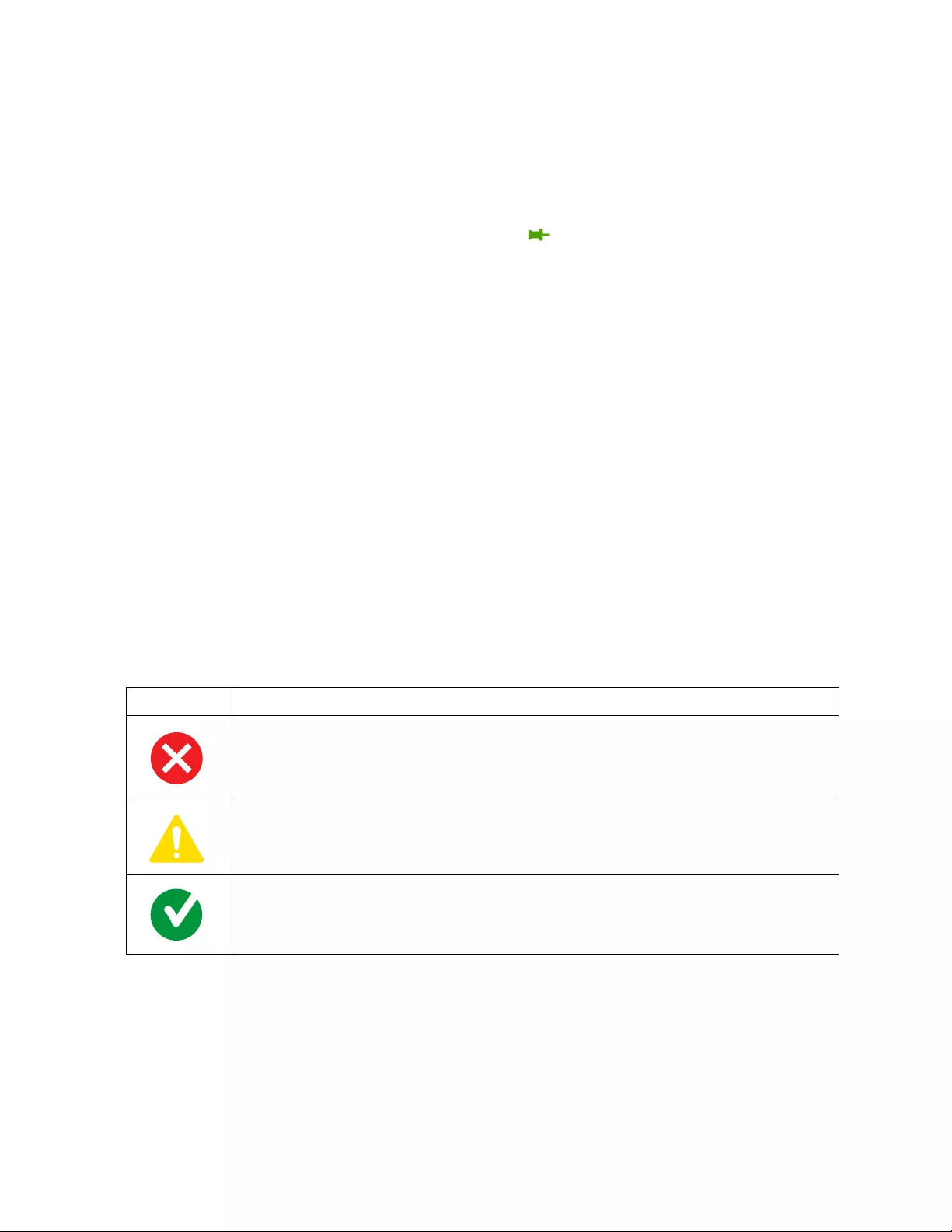
Metered by Outlet with Switching Rack PDU AP86XX User Guide106
Web User Interface Features
Read the following to familiarize yourself with basic Web UI features for your Rack PDU.
Tabs
The following tabs are available:
• Home: Appears when you log on (This is the default tab when you log on. To change the login
page to a different page, click on the green pushpin at the top right side of the browser
window while on the desired page). View active alarms, the load status of the Rack PDU, and the
most recent Rack PDU events. For more information, see “About Home” on page 108.
• Status: Gives the user the status of the Rack PDU and Network. The RPDU tab covers the status
of alarms, groups, device, phase, bank, and environment. Network tab covers just the network.
See “Status Tab” on page 109.
• Control: The Control tab covers three topics: RPDU, Security and Network. Much more
information is covered under each of these tabs and will be described in the Control tab section.
• Configuration: The Configuration tab covers RPDU, Security, Network, Notification, General
and Logs. Much more information is covered under each of these tabs and will be described in
the Configuration tab section.
• Tests: The Tests tab covers RPDU and Network. The RPDU tab covers LCD Blink and the
Network tab covers LED Blink. Both will be further described later in the Tests section of the
document.
• Logs: The Logs section covers: Event, Data and Firewall. The Event and Data tabs cover more
information which will be further discussed later in the Logs section of the document.
• About: The About section covers RPDU and Network, which will be further discussed later in the
About section of the document.
Device status icons
One or more icons and accompanying text indicate the current operating status of the Rack PDU:
At the upper right corner of every page, the Web UI displays the same icons currently displayed on the Home
page to report Rack PDU status:
• The No Alarms icon if no alarms exist.
• One or both of the other icons (Critical and Warning) if any alarms exist, and after each icon, the
number of active alarms of that severity.
Symbol Description
Critical: A critical alarm exists, which requires immediate action.
Warning: An alarm condition requires attention and could jeopardize your data or
equipment if its cause is not addressed.
No Alarms: No alarms are present, and the Rack PDU and NMC are operating
normally.

107Metered by Outlet with Switching Rack PDU AP86XX User Guide
Quick Links
At the lower left on each page of the interface, there are three configurable links. By default, the links access
the URLs for these Web pages:
•
Link 1: The home page of the APC by Schneider Electric website
•
Link 2: Demonstrations of APC by Schneider Electric web-enabled products
•
Link 3: Information on EcoStruxure IT
Located in the upper right hand corner of each page:
• User name (click to change user preferences)
• Language (if available, click to change language preference)
• Log Off (click to log the current user off of the Web UI)
• Help (click to view help contents)
• (click to set the current Web page to be the log in home page)
Example:
Log In Home: To make any screen the “home” screen (i.e., the screen that displays first when
you log on), go to that screen, and click the icon in the top right corner.
Click to revert to displaying the Home screen when you log on.
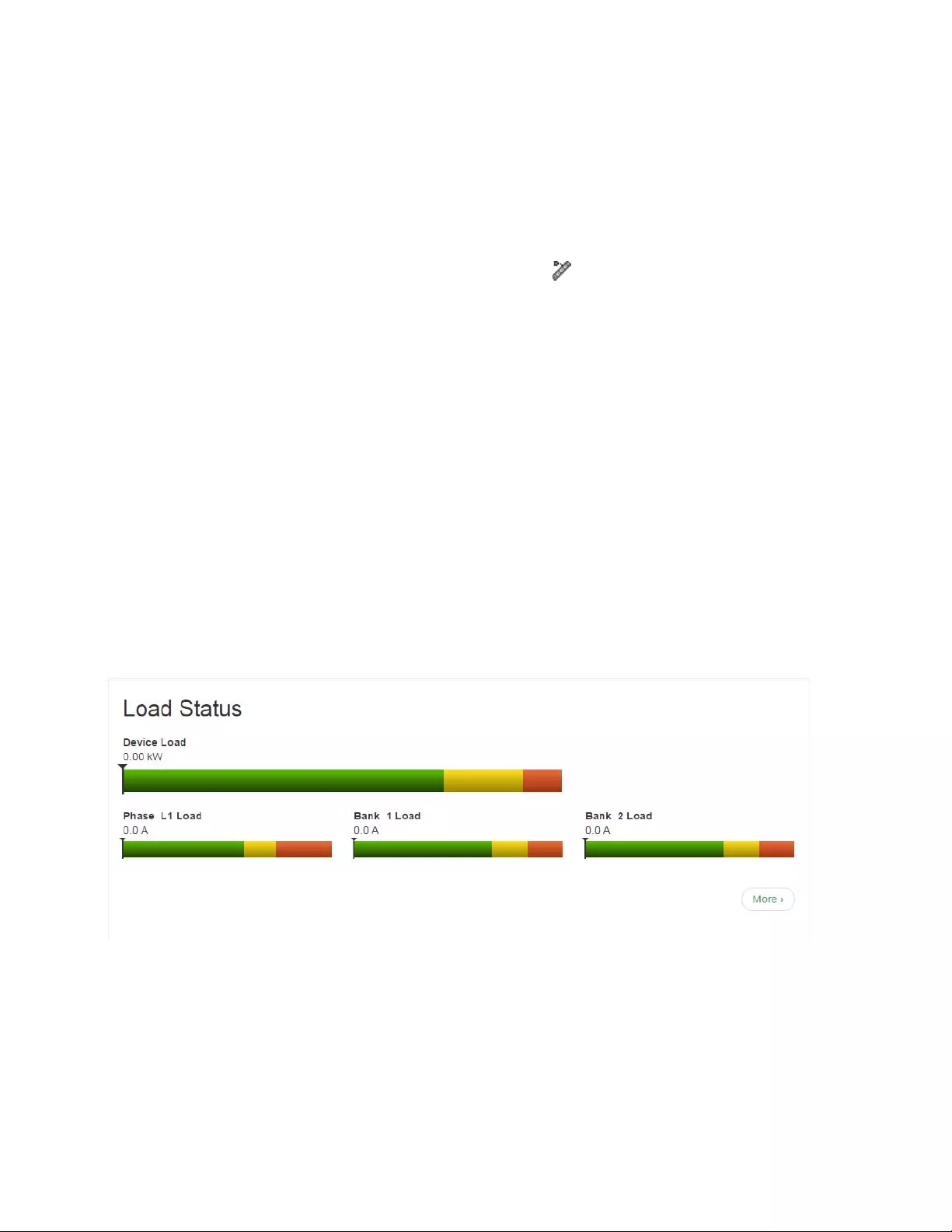
Metered by Outlet with Switching Rack PDU AP86XX User Guide108
Network Port Sharing (NPS) on the Web User
Interface (Web UI)
Group Control using Network Port Sharing
The Web UI of the Rack PDU will have additional capabilities if the Rack PDU is part of an NPS group. This
includes an NPS Group Status Web page and an NPS Group Configuration page. In addition, for Web pages
that support NPS Rack PDUs, the user can select a different Rack PDU in the group to view by selecting the
Rack PDU Display ID of the unit he or she would like to view.
Each Rack PDU in the NPS group is denoted with a Rack PDU icon followed by its Display ID (1 to 4). The
Rack PDU that the user is logged into is displayed with an additional asterisk (*) following the Display ID.
NOTE: The Reset/Reboot Web page has many additional reset/reboot options for Rack PDU groups. These
include individual Rack PDU reset to defaults, individual Rack PDU rebooting, and clearing of guest PDU lost
communication alarms by removing the guests from the group.
About Home
The Home page contains the following information: Active Alarms, Load Status and Recent Device Events.
Active Alarms will show if any alarms exist. If no alarms exist, a green check mark with the words ”No Alarms
Present” will show. The Load Status shows a colored bar demonstrating the level of the Bank, Phase and
Device loads. To see the Device Status select the More link at the bottom of the list.The Recent Device Events
box will list the five most recent device Events by the device by Date, Time and Event.
The Overview view
In the Load Status area, view the load for the device in kW and for the phases and banks in amps, as
applicable. The green, yellow, and red meter shows the current load status: normal, near overload, or overload.
NOTE: If a low load threshold was configured, the meter will also include a blue segment to the left of the
green.
In the Rack PDU Parameters box, the reader will find the Name, Location, Contact, Model Number, Rating,
User (type of user account accessing the Rack PDU) and Uptime (the amount of time the Rack PDU has been
operating since the last reboot from either a power cycle or a reboot of the Management Interface).
In the Recent Device Events box are the Events which have occurred most recently and the dates and times
they occurred. A maximum of five Events are shown at one time. Click More Events to go to the Logs tab to
view the entire event log.
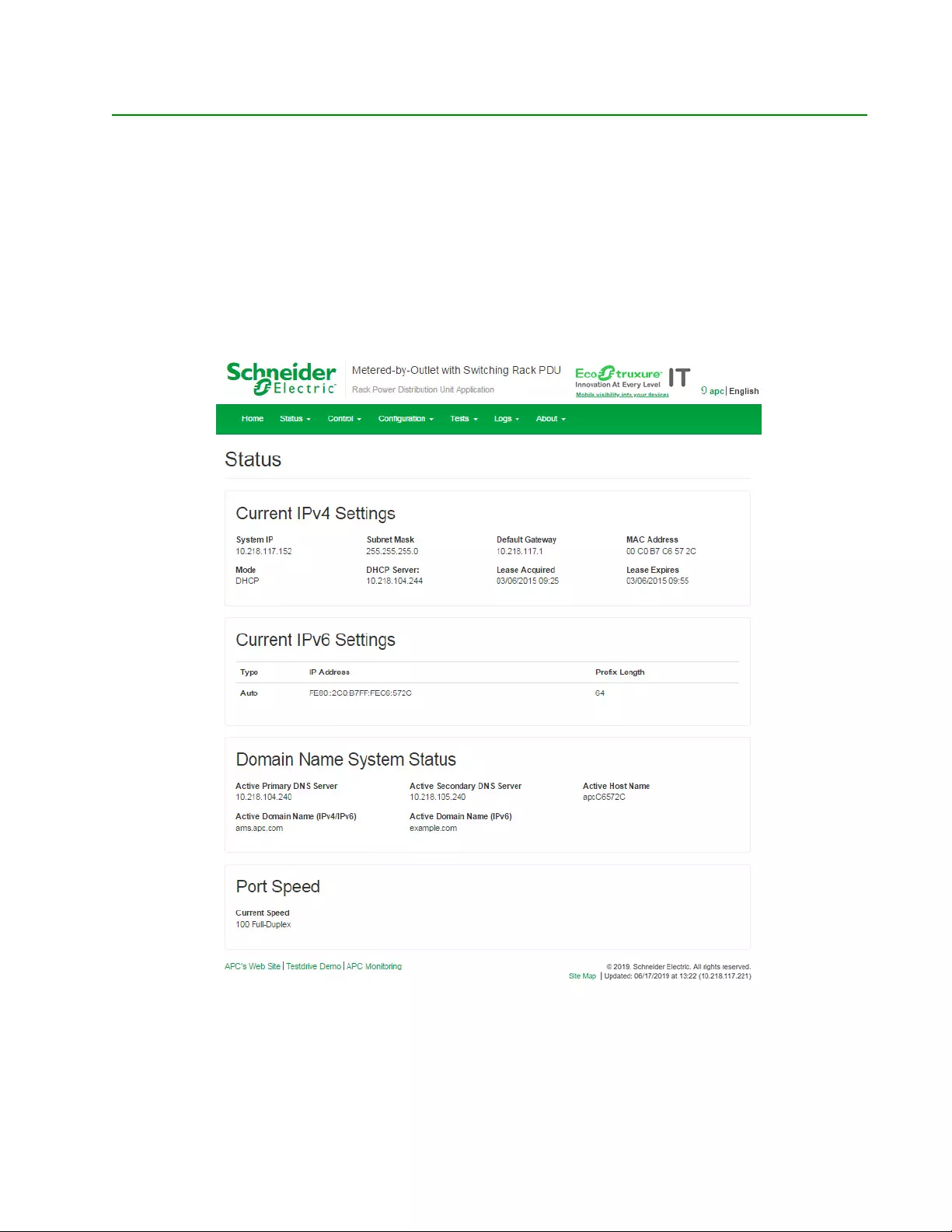
109Metered by Outlet with Switching Rack PDU AP86XX User Guide
Status Tab
About the Status Tab
Use the Status tab to:
• View the load status for the Rack PDU and Network Status
• Under the Rack PDU tab, readers can scroll and access: Alarms, Device, Phase, Bank, Outlets
and Environment.
• Manage outlets
• Select Network from the menu, to view the current IPv4 and IPv6 settings.
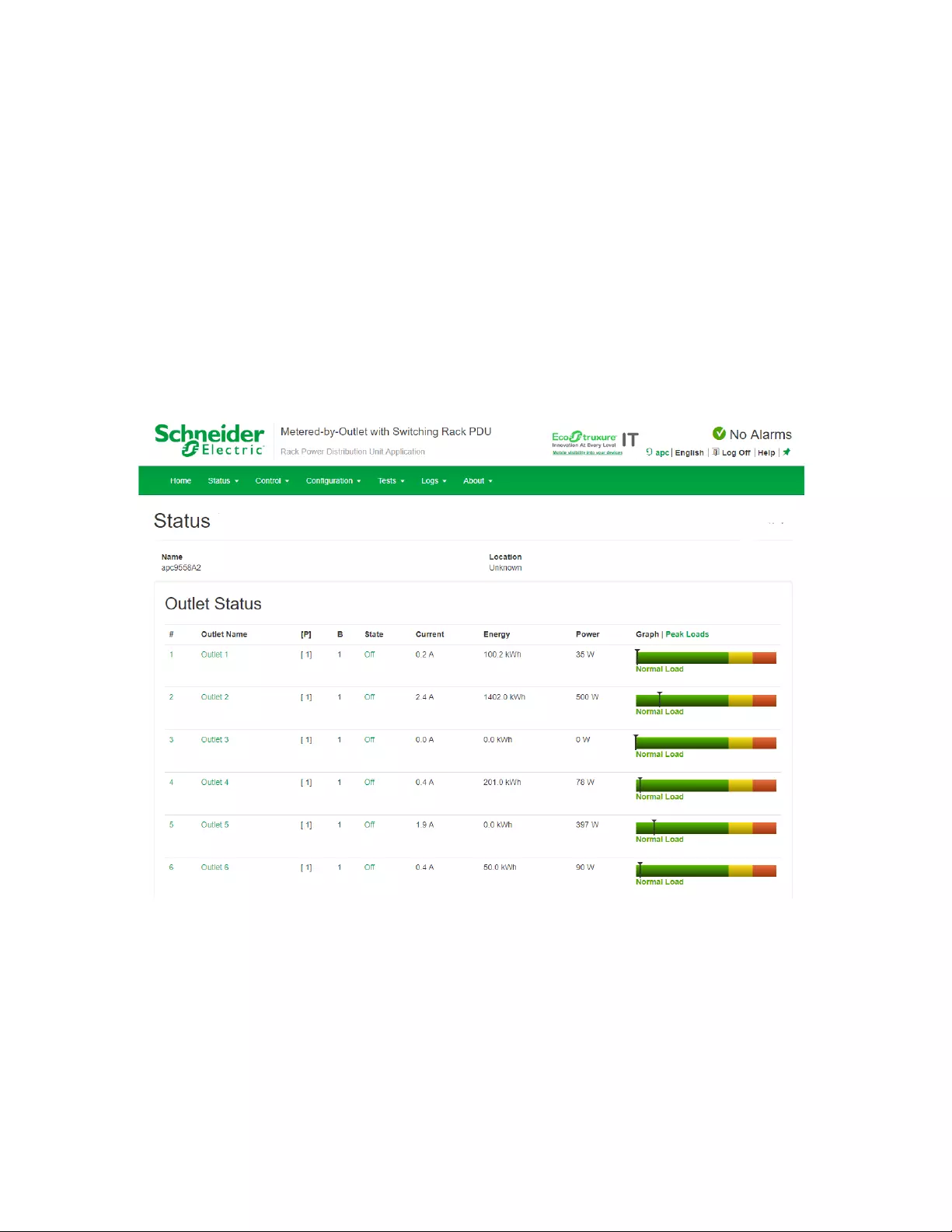
Metered by Outlet with Switching Rack PDU AP86XX User Guide110
View the Load Status and Peak Load
Path: Status > RPDU
Alarms:
Lists Device Alarm Status.
Group:
Network Port sharing Group Status. List the Properties, Metering and firmware version information.
Change Host RPDU can be accessed from its link at the bottom of the page.
Device:
Shows status of device. Lists Status, Properties and Configuration information.
Phase:
Shows Phase Status. Delta values for Phase Load Balance are displayed for models with two or
more metered phases. The phase settings can also be configured via a Configure Phase Settings link at the
bottom of the page. Configuration can be changed as well.
Bank:
Shows bank status (only on units with this feature). List current size and demonstrates range on a
colored red, green and yellow sliding bar. The bank settings can be changed via a Configure Bank status link at
the bottom of the page.
Outlet:
Shows: Outlet Name, Phase, State and Outlet Load
Switched Outlet:
Choose from the following options:
• Scheduling: Shows Scheduled outlet actions. You can also schedule outlet actions from this
page (see for “Schedule Outlet Actions” on page 125 for more information).
• Outlet Alarm Actions: Shows outlet alarm actions. You can also configure alarm actions from
this page (see “Configure Outlet Alarm Actions” on page 124 for more information).
• Outlet Groups: Shows outlet groups as either enabled or disabled. You can also configure
groups from this page (see “Configure and Control Outlet Groups” on page 117 for more
information).
Environment:
Shows Alarm Status, Temperature, Humidity and can configure Temperature and Humidity
Configuration after pressing the Configure link.

111Metered by Outlet with Switching Rack PDU AP86XX User Guide
View the Network Status
Path: Status > Network
The Network screen displays information about your network.
Current IPv4 Settings
System IP:
The IP address of the unit.
Subnet Mask:
The IP address of the sub-network.
Default Gateway:
The IP address of the router used to connect to the network.
MAC Address:
The MAC address of the unit.
Mode:
How the IPv4 settings are assigned: Manual, DHCP, or BOOTP.
DHCP Server:
The IP address of the DHCP server. This is only displayed if Mode is DHCP.
Lease Acquired:
The date/time that the IP address was accepted from the DHCP server.
Lease Expires:
The date/time that the IP address accepted from the DHCP server expires and will need to
be renewed.
Current IPv6 Settings
Type:
How the IPv6 settings are assigned.
IP Address:
The IP address of the unit.
Prefix Length:
The range of addresses for the sub-network.
Domain Name System Status
Active Primary DNS Server:
The IP address of the primary DNS server.
Active Secondary DNS Server:
The IP address of the secondary DNS server.
Active Host Name:
The host name of the active DNS server.
Active Domain Name (IPv4/IPv6):
The IPv4/IPv6 domain name that is currently in use.
Active Domain Name (IPv6):
The IPv6 domain name that is currently in use.
Ethernet Port Speed
Current Speed:
The current speed assigned to the Ethernet port.
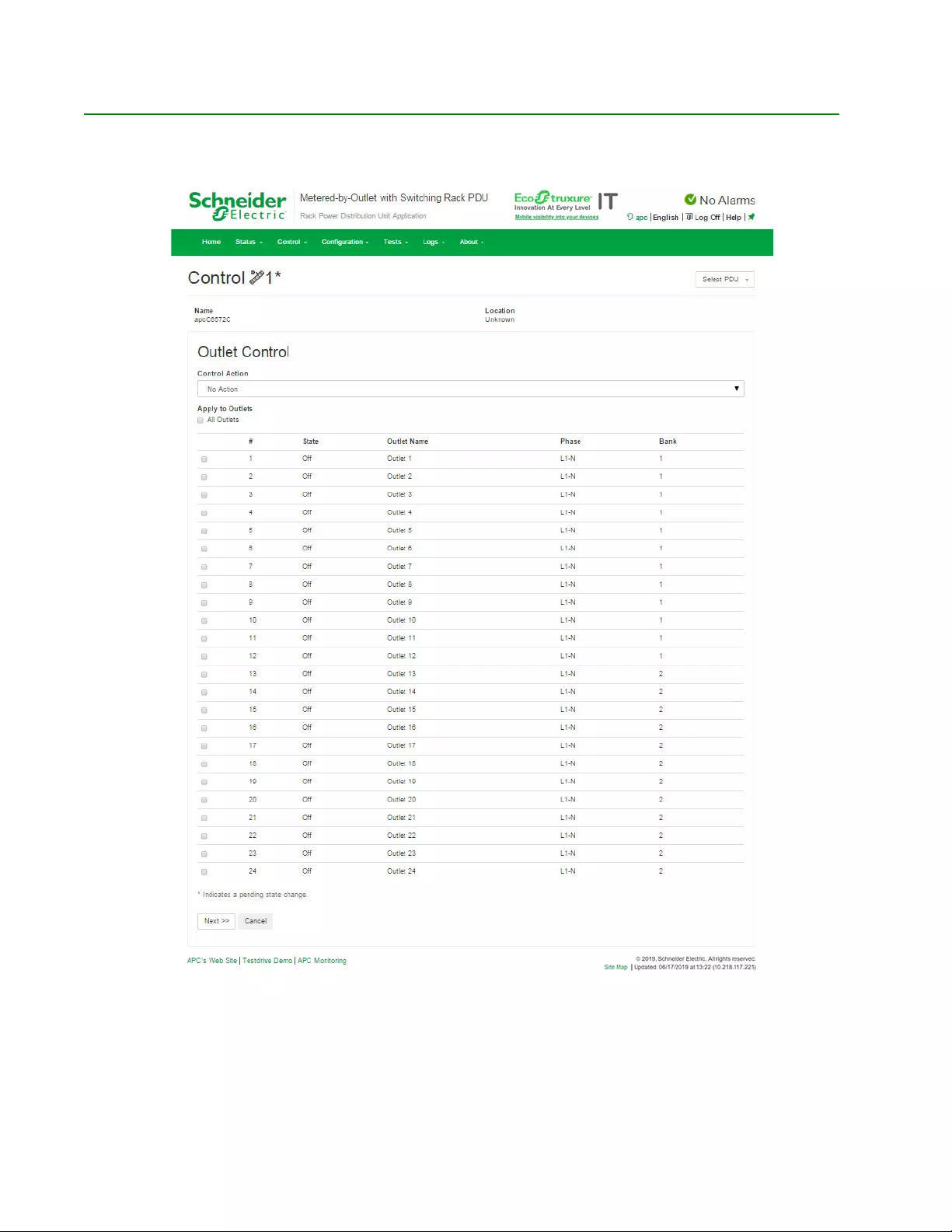
Metered by Outlet with Switching Rack PDU AP86XX User Guide112
Control
The Control menu options enable you to take immediate actions affecting active user management and the
security of your network.

113Metered by Outlet with Switching Rack PDU AP86XX User Guide
Controlling Rack PDU Outlets
Path: Control > RPDU > Outlet
Shows Outlet Control, Control Action, and Selected Outlets. Inside the Select Outlet box the screen will show
the Outlet’s Name, its State and its Phase.
NOTE: If you apply an outlet control action to outlets or outlet groups, the following delays are used for the
action:
• For an individual outlet (not in an outlet group), the action uses the delay periods and reboot
duration configured for that outlet.
• For a global outlet group, the action uses the delay periods and reboot duration configured for the
global outlet.
• For a local outlet group, the action uses the delay periods configured for the lowest-numbered
outlet in the group.
To control the outlets on your Rack PDU
Mark the checkboxes for each individual outlet or outlet group to control, or select the All Outlets checkbox.
Select a Control Action from the list, and click Next >>. On the confirmation page that explains the action,
choose to apply or cancel it.
Control actions you can select
Option Description
No Action Do nothing.
On Immediate Apply power to the selected outlets.
On Delayed Apply power to each selected outlet according to its value for Power On Delay.†
Off Immediate Remove power from the selected outlets.
Off Delayed Remove power from each selected outlet according to its value for Power Off Delay.†
Reboot
Immediate
Remove power from each selected outlet. Then apply power to each of these outlets
according to its value for Reboot Duration.†
Reboot Delayed
Remove power from each selected outlet according to its value for Power Off Delay.
Wait until all outlets are off (the highest value for Reboot Duration), and then apply
power to each outlet according to its value for Power On Delay. †
Cancel Pending
Commands
Cancel all commands pending for the selected outlets and keep them in the present
state.
NOTE: For global outlet groups, you can cancel a command only from the interface of
the initiator outlet group. The action will cancel the command for the initiator outlet group
and all follower outlet groups.
†
If a local outlet group is selected, only the configured delays and reboot duration of the lowest-
numbered outlet of the group are used. If a global outlet group is selected, only the configured delays
and reboot duration of the global outlet are used.
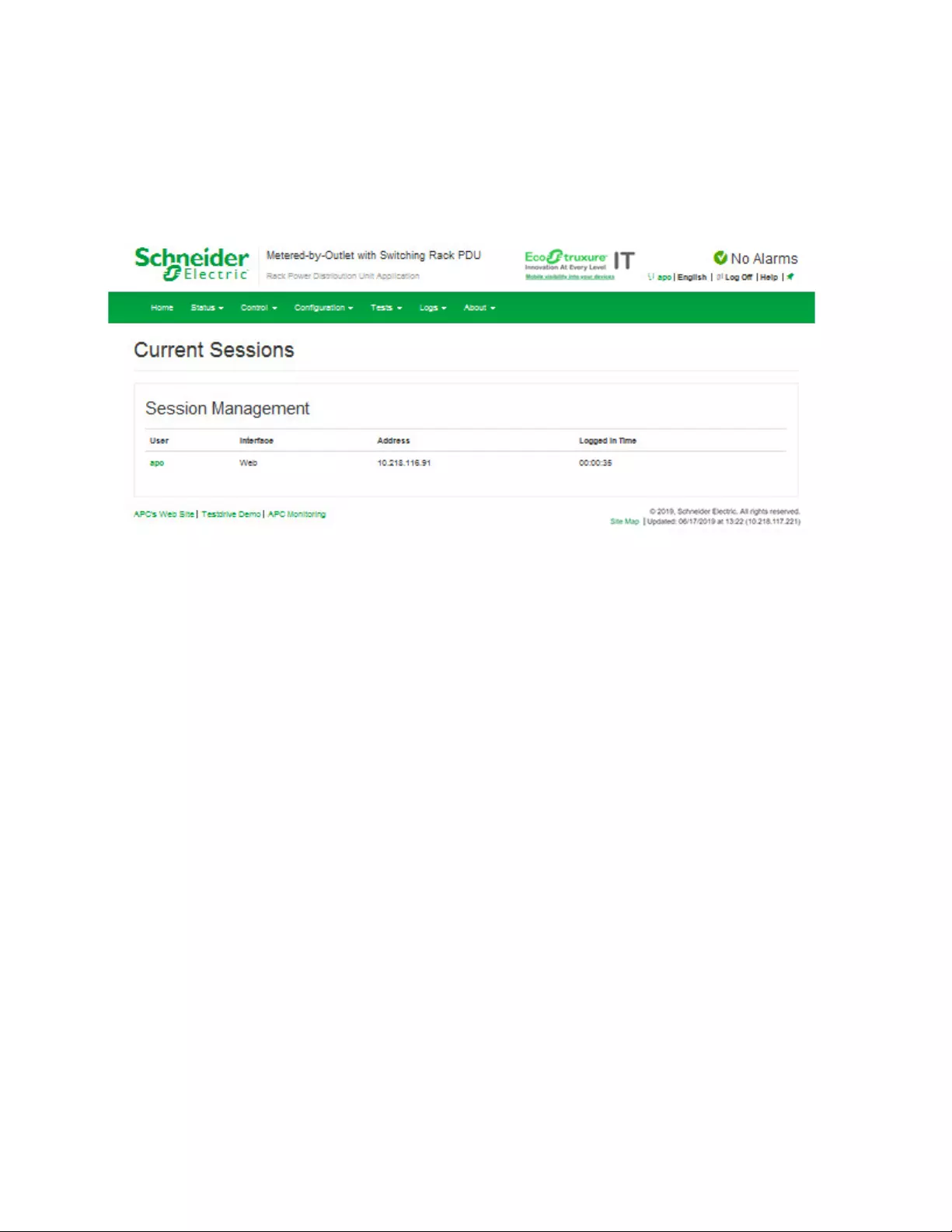
Metered by Outlet with Switching Rack PDU AP86XX User Guide114
Managing User Sessions
Path: Control > Security > Session Management
The Session Management menu displays all active users currently connected to the Rack PDU. To view
Information about a given user, click their user name. The Session Details screen displays basic information
about the user including what interface they are logged-in to, their IP address, and user authentication. There
is also an option to Terminate Session for the user.
Resetting the Network Interface
Path: Control > Network > Reset/Reboot
This menu gives you the option to reset and reboot various components of the network interface. Users have
the option to Reboot Management Interface,
NOTE: Rebooting the Management Interface only restarts the Rack PDU’s Network Management Interface.
It does not affect the outlet ON/OFF status.
Reset All:
Clear the Exclude TCP/IP checkbox to reset all configuration values; mark the Exclude TCP/IP
checkbox to reset all values except TCP/IP and EAPoL.
Reset Only:
(Resetting may take up to a minute) Options include:
• TCP/IP settings: Set TCP/IP Configuration to DHCP & BOOTP, its default setting. This requires
that the Rack PDU receive its TCP/IP settings from a DHCP or BOOTP server. See “View the
result of the test DNS in the Last Query Response field.” EAPoL is reset to disabled.
•
Event configuration: Reset all changes to event configuration, by event and by group, to their
default settings.
• Guest PDU lost communication alarms by removing corresponding guest PDUs.
• Host Display ID and Remove all Guest PDUs.
• RPDU to Defaults.
• For NPS groups:
Guest PDU lost Communication alarms by removing corresponding guest PDUs.
Host Display ID and remove all guest PDUs
Host to Defaults
Guest to Defaults
Guest Management Interface (Reboot)
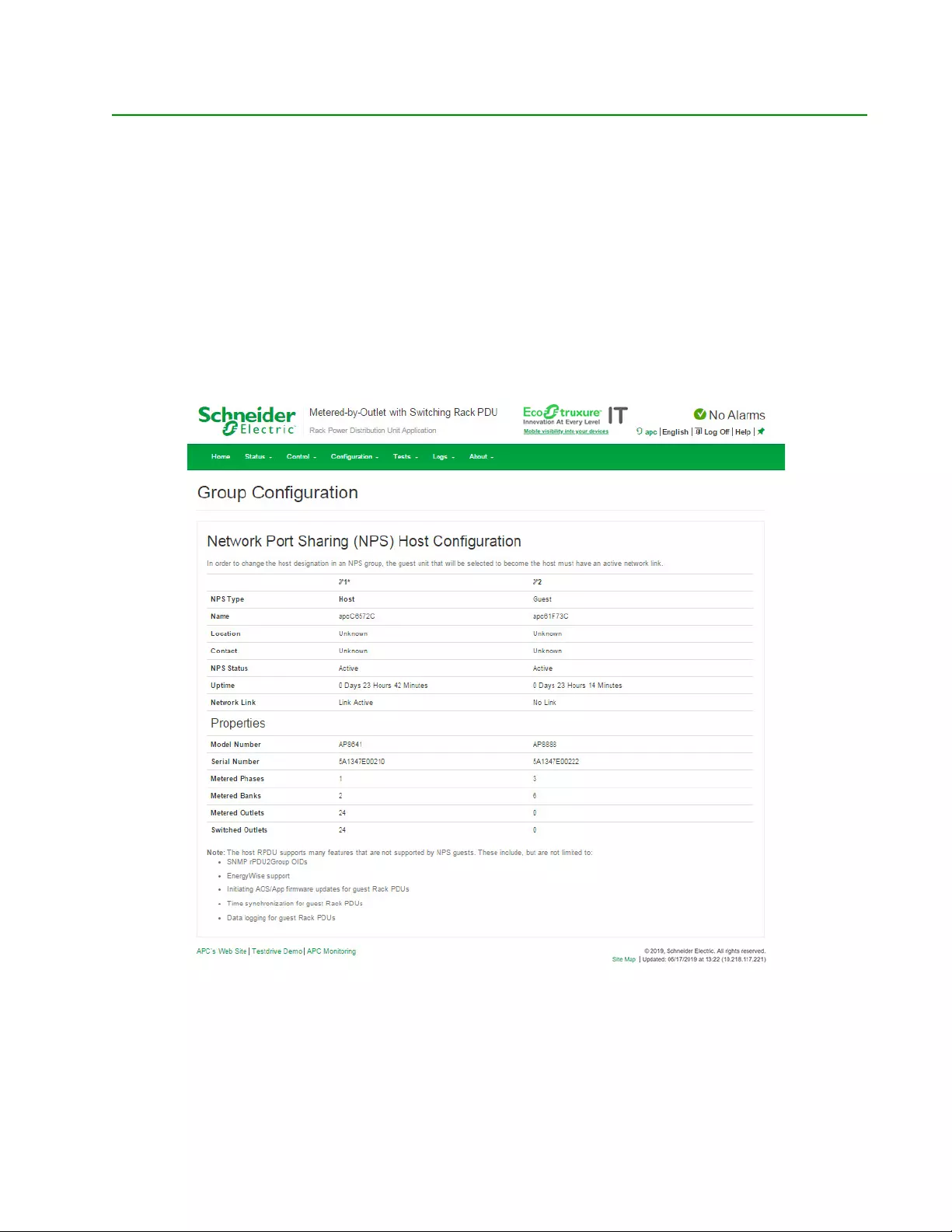
115Metered by Outlet with Switching Rack PDU AP86XX User Guide
Configuration
About the Configuration Tab
Under the Configuration tab, several menu options are available to make changes to the Rack PDUs:
• View the load status for the Rack PDU
• Configure load thresholds for all connected devices, phases, banks, and outlets
• Manage and control outlets
• Configure a name and location for the Rack PDU
• View and manage the peak load measurement
• Click user-configurable links to open Web pages for specific devices connected to the Rack PDU

Metered by Outlet with Switching Rack PDU AP86XX User Guide116
Configure Load Thresholds
Path: Configuration > RPDU
View the load for the device, phases, banks, and outlets. The indicator in the green, yellow, and red meter
shows the current load status: normal, near overload, or overload. If a low load threshold was configured, the
meter will include a blue segment to the left of the green. When viewing the Device Load, the triangle above
the meter indicates peak load.
NOTE: The Rack PDU generates an alarm when any bank exceeds its configured value. However, if a circuit
breaker trips, there is no definitive indication that the circuit breaker is open, other than that the current for that
bank will drop. Set the Low Load Warning to 1 amp for these reasons:
• The default setting for the Low Load Warning is 0 amps. This effectively disables the warning.
With a setting of 0 amps for the Low Load Warning, the Web UI will not indicate that a circuit
breaker may have tripped.
• A 1 amp detection threshold for the Low Load Warning for Bank Load Management will help to
indicate that a circuit breaker may have tripped.
To configure load thresholds
1. To configure load thresholds for the device, phases, or banks, make a selection from the
Configuration > RPDU > Device and Phase and Bank drop-down menu. To configure load
thresholds for outlets, click Configuration and then click an outlet.
2. Set Overload Alarm, Near Overload Warning, and Low Load Warning thresholds.
3. Click Apply to save your settings.
Configure Rack PDU Name and Location
Path: Configuration > RPDU > Device
The name and location you enter will appear on the Home tab.
1. Enter a name and location and contact.
2. Click Apply to save.
Set the Coldstart Delay for the Rack PDU
Path: Configuration > RPDU > Device
The Coldstart Delay is the number of seconds added to each outlet’s Power On Delay before an outlet will turn
on after power is applied to the Rack PDU. Allowed values are from 1 to 300 seconds, Immediate, or Never
(never turn on).
1. Make a selection for Coldstart Delay.
2. Click Apply.
Reset Peak Load and kWh
Path: Configuration > RPDU > Device
3. Click the Configuration tab, then RPDU, then Device.
4. Click the Peak Load and Kilowatt-Hours check boxes as desired.
5. Click Apply.

117Metered by Outlet with Switching Rack PDU AP86XX User Guide
Set the Overload Outlet Restrictions
Path: Configuration > RPDU > Phase and Bank
Prevent users from applying power to outlets during an overload condition. You can set the following
restrictions for each phase and bank:
• None: Users can apply power to outlets regardless of an Overload Alarm or Near Overload
Warning.
• On Warning: Users cannot apply power to an outlet on the selected phase or bank if the current
for that phase or bank has exceeded the Near Overload Warning threshold.
• On Overload: Users cannot apply power to an outlet on the selected phase or bank if the current
for that phase or bank has exceeded the Overload Alarm threshold.
To set Overload Outlet Restrictions:
1. Click the Configuration
tab, t
hen
RPDU
,
then phase or bank from the menu.
2. Make selections for Overload Outlet Restriction.
3. Click Apply.
Configure Phase Load Balance
Path: Configuration > RPDU > Phase
The Phase Load Balance alarm is only available for units with two or more metered phases.
Specify a warning threshold (in Amps) between 0 and the maximum phase current rating, then select Enable
under Alarm Generation. Once this feature is enabled, the RPDU will generate a Warning alarm if the phases
are out of balance by more than the specified number of Amps.
Configure and Control Outlet Groups
Outlet group terminology
An outl et gr oup consists of outlets that are logically linked together on the same Rack PDU. Outlets that are in
an outlet group turn on, turn off, and reboot in a synchronized manner:
• A local outlet group consists of two or more outlets on a Rack PDU. Only the outlets in that group
are synchronized.
• A global outlet group consists of one or more outlets on a Rack PDU. One outlet is configured as
a global outlet, which logically links the outlet group to outlet groups on up to three other Rack
PDUs. All outlets in the linked global outlet groups are synchronized.
– For global outlet groups, the initiator outlet group is the group that issued the action.
– For global outlet groups, a follower outlet group is any other outlet group that is synchronized
with the initiator outlet group.
When you apply an outlet control action to outlets that are members of an outlet group, the outlets are
synchronized as follows:
• For a global outlet group, use the delay periods and reboot duration configured for the global
outlet of the initiator outlet group.
• For a local outlet group, the outlets use the delay periods and reboot duration of the lowest-
numbered outlet in the group.

Metered by Outlet with Switching Rack PDU AP86XX User Guide118
Purpose and benefits of outlet groups
By using groups of synchronized outlets on Rack PDUs, you can ensure that outlets turn on, turn off, and
reboot in a synchronized manner. Synchronizing control group actions through outlet groups provides the
following benefits.
• Synchronized shutdown and startup of the power supplies of dual-corded servers prevents
erroneous reporting of power supply failures during a planned system shutdown or reboot.
• Synchronizing outlets by using outlet groups provides more precise shutdown and restart timing
than relying on the delay periods of individual outlets.
• A global outlet is visible to the user interface of any Rack PDU to which it is linked.
System requirements for outlet groups
To set up and use synchronized outlet control groups:
• You need a computer that can initiate synchronized control operations through the Web UI or
Command Line Interface of the Rack PDUs or through SNMP.
• All of the Rack PDUs must use firmware that has the same version number for both APC by
Schneider Electric’s APC Operating System (AOS) module and the application module.
• All of the Rack PDUs must be configured with the same “Member Name”.
• If you are using Network mode, you will also need the following items. These are not necessary if
you are using Network Port Sharing mode over the In/Out ports.
– You need a 10/100Base-T TCP/IP network, with an Ethernet hub or switch that has a power
source not shared by the computers or other devices being synchronized.
– All of the Rack PDUs must be on the same subnet.
– Outlet groups you synchronize must have the same Multicast IP address, outlet group port,
authentication phrase, and encryption phrase. Make sure each Ethernet switch that connects
Rack PDUs allows Multicast network traffic for that Multicast IP address.
Rules for configuring outlet groups
For a system that uses outlet groups, the following rules apply:
• A Rack PDU can have more than one outlet group, but an outlet can belong to only one outlet
group.
• A local outlet group, which has no global outlet, must consist of two or more outlets.
• You can synchronize a global outlet group on one Rack PDU with a global outlet group on each of
three other Rack PDUs.
– In a global outlet group, you can designate only one outlet to be a global outlet, linking to outlet
groups on other Rack PDUs for the purpose of synchronization. That global outlet can be the
only outlet in its group, or the group can consist of multiple outlets.
– A global outlet of one outlet group must have the same physical outlet number as the global
outlet of any other outlet group to which it links.
• To create and configure outlet groups, you must use the Web UI or export configuration file (.ini
file) settings from a configured Rack PDU. The Command Line Interface lets you display whether
an outlet is a member of an outlet group and lets you apply control actions to an outlet group, but
the Command Line Interface does not let you set up or configure an outlet group.

119Metered by Outlet with Switching Rack PDU AP86XX User Guide
Enable outlet groups
Path: Configuration > RPDU > Switched Outlet > Outlet Groups
Configure the following parameters, and click Apply.
Enable creation of outlet groups:
Enable support for global outlet groups (linked groups):
Setting parameters for outlet groups using Network mode:
NOTE: Devices attempting to synchronize with Outlet Groups on other devices using network mode must all
have the same Authentication Phrase and Encryption Phrase. The values are hidden to the user.
Create a local outlet group
Path: Configuration > RPDU > Switched Outlet > Outlet Groups
1. Make sure outlet groups are enabled. (See “Typical outlet group configurations” on page 121.)
2. Click Create Local Outlet Group.
3. Select the checkboxes of the outlets that will be in the group and assign the group a name in the
Outlet Group Name field. You must select at least two outlets.
Parameters Description
Device Level
Outlet Group
To create an outlet group, you must enable the desired group method. Choices
are: Disabled, Local Only, Enabled via Network, and Enabled via In/Out Ports
(Network Port Sharing).
Parameters Description
Member Name
To link outlet groups on multiple Rack PDUs, you must define the same Member
name on each of the Rack PDUs.
NOTE: A maximum of four devices can be configured with the same Member
name
Parameters Description
Multicast IP
To link outlet groups on multiple Rack PDUs, you must define the same Multicast
IP address on each of the Rack PDUs.
NOTE: A maximum of four devices can be configured with the same Member
name and Multicast IP address.
Authentication
Phrase
A phrase of 15 to 32 ASCII characters that verifies that the device is
communicating with other devices, that the message has not been changed
during transmission, and that the message was communicated in a timely
manner. The authentication phrase indicates that it was not delayed and that it
was not copied and sent again later at an inappropriate time.
Encryption Phrase A phrase of 15 to 32 ASCII characters that ensures the privacy of the data (by
means of encryption).
Outlet Group Port The port number on which the device will communicate with other devices. This
must be the same on all PDUs in a group.

Metered by Outlet with Switching Rack PDU AP86XX User Guide120
Create a global outlet group
Path: Configuration > RPDU > Switched Outlet > Outlet Groups
To set up multiple global outlet groups that link to outlet groups on other Rack PDUs:
1. Make sure outlet groups are enabled. (See “Typical outlet group configurations” on page 121.)
2. Click Create Global Outlet Groups.
3. Select the checkboxes of the outlets that will be in the group and then click "Apply and Select
Global Outlets" to select the global outlet for the group. If there is only one outlet in the group, it
will automatically be assigned as the global outlet.
4. To add outlets to any of the global outlet groups you created, see “Edit or delete an outlet group”.
Edit or delete an outlet group
Path: Configuration > RPDU > Switched Outlet > Outlet Groups
1. In the Configure Group table, click on the number or name of the outlet group to edit or delete.
2. When editing an outlet group you can do any of the following:
– Rename the outlet group.
– Add or remove outlets by clicking the checkboxes to mark or unmark them.
NOTE: You cannot remove an outlet from an outlet group that contains only two outlets unless
the remaining outlet is a global outlet.
3. To delete the outlet group, click Delete Outlet Group.
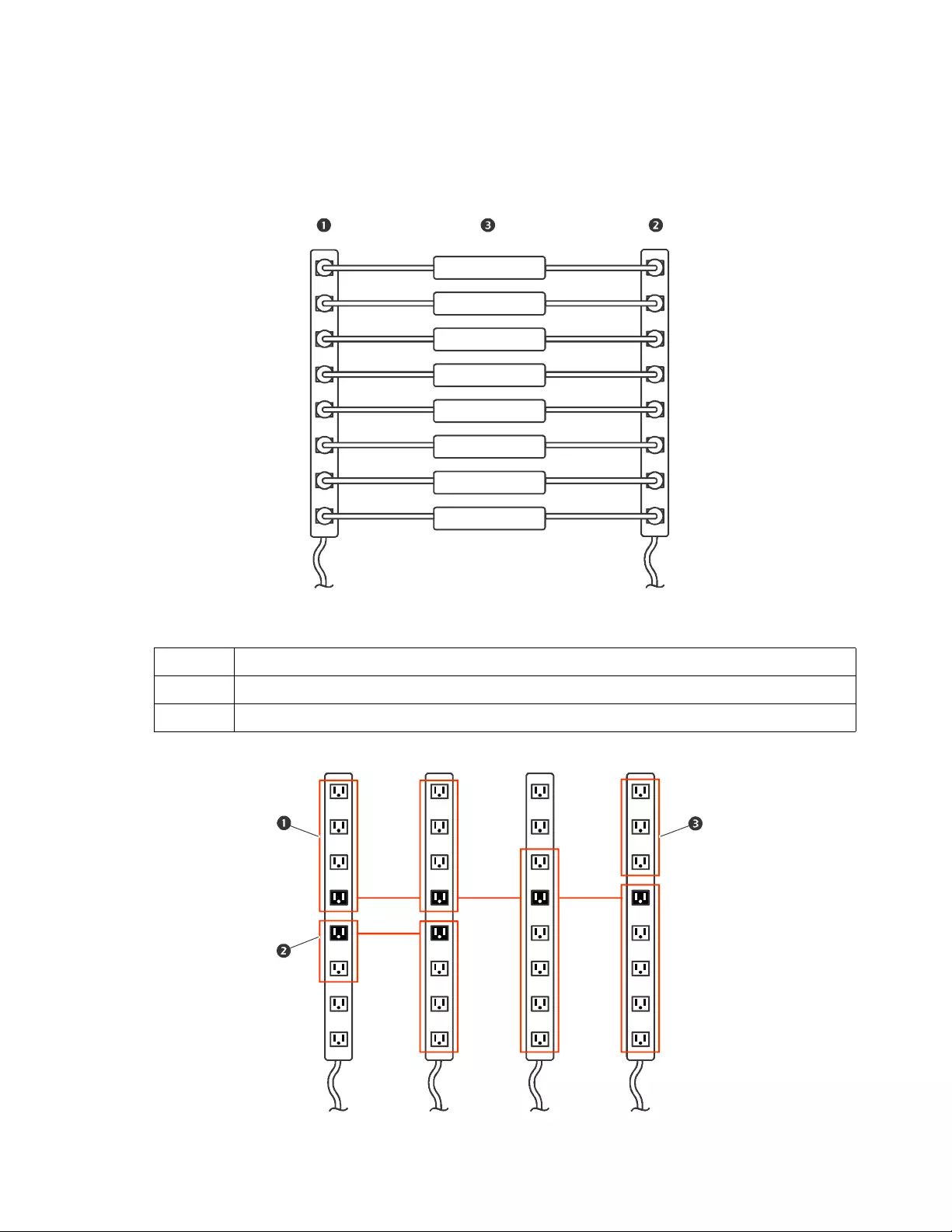
121Metered by Outlet with Switching Rack PDU AP86XX User Guide
Typical outlet group configurations
The following configuration shows two Rack PDUs, each with eight outlet groups. Each outlet group consists of
a single global outlet. Each outlet group on the first Rack PDU is linked to the outlet group in the same
location on the second Rack PDU. One power cord of a dual-corded server is connected to each outlet on
the first Rack PDU, and its other cord is connected to the corresponding outlet on the second Rack PDU,
ensuring that output power from both power sources to the server will turn On or Off in a synchronized manner
in response to an outlet control action.
The following configuration shows three sets of synchronized outlets. Global outlets are shown in black. Outlet
groups are enclosed in red rectangles.
These four global outlet groups synchronize a total of 19 outlets.
These two global outlet groups synchronize 6 outlets, 2 in one group and 4 in the other.
This local outlet group synchronizes 3 outlets on the same Rack PDU.
Server 1
Server 2
Server 3
Server 4
Server 5
Server 6
Server 7
Server 8

Metered by Outlet with Switching Rack PDU AP86XX User Guide122
Verify your setup and configuration for global outlet groups
Path: Configuration > RPDU > Switched Outlet > Outlet Groups
To ensure that your setup meets all system requirements for outlet groups and that you have configured the
outlet groups correctly, view the groups and their connections:
• The Configure Group table displays the following:
– All configured outlet groups on the current Rack PDU.
– The outlets in each group by outlet number.
– Any outlet groups on other Rack PDUs with which a global outlet group is synchronized. Each
Rack PDU is identified by its IP address if using network mode, or Display ID if using Network
Port Sharing over In/Out ports. Each global outlet is displayed in bold text.
• The Global Outlet Overview section displays the following:
– The IP address or Display ID of the current Rack PDU.
– The IP address or Display ID of any Rack PDUs that contain global outlets that are available to
be synchronized with outlet groups on other Rack PDUs.
– All global outlets configured on the Rack PDUs, regardless of whether they are synchronized
with outlet groups on the current Rack PDU.

123Metered by Outlet with Switching Rack PDU AP86XX User Guide
Outlet Settings
Select From the options to control the outlets on your Rack PDU.
Path: Configuration > RPDU > Switched Outlet (or Outlet Groups)
Configure outlet settings and the outlet name
The following settings are available:
Path: Configuration > RPDU > Switched Outlet > Configuration
Click the Configure Multiple Outlets button in the Outlet Configuration section or click the outlet name.
• Configure outlet settings for multiple outlets:
– Select the checkboxes next to the numbers of the outlets you want to modify, or select the All
Outlets checkbox.
– Enter values for Name and Link, and click the Apply button immediately below the list.
– Enter values for Power On Delay, Power Off Delay, or Reboot Duration, and click the Apply
button immediately below the list.
• Configure outlet settings for a single outlet:
– Enter values for Name and Link, and click the Apply button immediately below the list.
– Enter values for Power On Delay, Power Off Delay, or Reboot Duration, and click the Apply
button immediately below the list.
Setting Description
Name Set the name for one or more outlets. The name is displayed next to the
outlet number on status screens.
External Link
Define an HTTP or HTTPS link to a website or IP address.
The external device Web link can be set to the IP address of the external
device plugged into the outlet (if applicable). Alternatively, it can be set to
the device's manufacturer Web page in order to more easily view user
manuals, etc. Clicking the link on the Outlet Links page will open a new
browser window to the link.
Power On Delay
Set the number of seconds that the Rack PDU waits after a command is
issued before applying power to an outlet.
NOTE: To configure an outlet to remain off at all times, select the Never
radio button next to Power On Delay.
Power Off Delay
Set the number of seconds that the Rack PDU waits after a command is
issued before removing power from an outlet.
NOTE: To configure an outlet to remain on at all times, select the Never
radio button next to Power Off Delay.
Reboot Duration Set the number of seconds an outlet remains Off before restarting.

Metered by Outlet with Switching Rack PDU AP86XX User Guide124
Configure Outlet Alarm Actions
Path: Configuration > RPDU > Switched Outlet > Outlet Alarm Actions
Configure outlets to turn on or off when specific alarms are generated. You can create up to 16 switched outlet
alarm actions. Each outlet can only be controlled by one action at a time.
Click Create New Alarm Action to make a new action, or select the name of an alarm action to edit it. The
following settings are available:
Click Apply to save your changes, Cancel to discard your changes, or Delete to delete an existing alarm
action.
NOTES:
• You cannot edit an alarm action while the action is active.
• If you delete an alarm action that clears automatically while the action is active,
– The outlets are automatically set to the non-action state. For example, if the alarm action is
Off, the outlets are turned on.
– The alarm is cleared.
– The action event is deleted from the event log.
• If you delete an alarm action that must be cleared manually while the action is active,
– The outlet state is not changed.
– The alarm is cleared.
– The action event is deleted from the event log.
Setting Description
Status The alarm action is enabled by default. De-select this option to disable it.
Action Name
Enter a name for the action (up to 30 characters). This name will appear in
the event log. If you do not configure a name, the default, Alarm Action, is
used.
Alarm Status Shows the current status of the configured alarm.
Alarm Type
Select the kind of alarm that will trigger this action:
• Max Temperature Threshold Violation Alarm.
• High Temperature Threshold Violation Alarm.
• Low Humidity Threshold Violation Alarm.
• Min Humidity Threshold Violation Alarm.
Apply to Outlets Select the outlets that the alarm action applies to.
Alarm Outlet Action Select whether the configured outlets will turn On or Off when the alarm is
generated.
Alarm Clearing Method
Select outlet behavior when the alarm clears.
•Manual: The outlet state does not change; you must log on and return
the outlets to their pre-alarm states as desired.
•Auto: The outlets are automatically set to the non-action state. For
example, if the alarm action is Off, the outlets are turned On after the
alarm clears.

125Metered by Outlet with Switching Rack PDU AP86XX User Guide
Schedule Outlet Actions
Actions you can schedule
To configure values for Power On Delay, Power Off Delay, and Reboot Duration for each outlet, see
“Configure outlet settings and the outlet name” on page 123. Although you must use the Web UI to schedule
outlet actions, you can set these values in either the Web or Command Line Interfaces. For any outlets you
select, you can schedule any of the actions listed in the following table to occur daily; at intervals of one, two,
four, or eight weeks; or only once.
Schedule an outlet event
Path: Configuration > RPDU > Switched Outlet > Scheduling
1. On the Outlet Scheduling page, select how often the event will occur (One-Time, Daily, or
Weekly), and click the Next button.
NOTE: If you select Weekly, you can choose to have the event occur once every week or once
every two, four, or eight weeks.
2. On the Schedule a Daily Action page, in the Name of event text box, replace the default name,
Outlet Event, with a name that will identify your new event.
3. Use the drop-down lists to select the type of event and when it will occur.
The date format for one-time events is mm/dd, and the time format for all events is hh/mm, with
the two-digit hour specified in 24-hour time.
– An event that is scheduled daily or at one of the intervals available in the Weekly selection
continues to occur at the scheduled interval until the event is deleted or disabled.
– You can schedule a one-time event to occur only on a date within 12 months of the date on
which you perform the scheduling. For example, on September 26, 2018, you could schedule
a one-time event on any date from the current date until September 26, 2019.
4. Use the checkboxes to select which outlets will be affected by the action. You can select one or
more individual outlets or All Outlets.
5. Click Apply to confirm the scheduling of the event, or Cancel to clear it.
When you confirm the event, the summary page is re-displayed, with the new event displayed in the list of
scheduled events.
Option Description
No Action Do nothing.
On Immediate Apply power to the selected outlets.
On Delayed Apply power to each selected outlet according to its value for Power
On Delay.†
Off Immediate Remove power from the selected outlets.
Off Delayed Remove power from each selected outlet according to its value for
Power Off Delay.†
Reboot Immediate Remove power from each selected outlet. Then apply power to each of
these outlets according to its value for Reboot Duration.†
Reboot Delayed
Remove power from each selected outlet according to its value for
Power Off Delay. Wait until all outlets are off (the highest value for
Reboot Duration), and then apply power to each outlet according to its
value for Power On Delay. †
†
If a local outlet group is selected, only the configured delays and reboot duration of the lowest-
numbered outlet of the group are used. If a global outlet group is selected, only the configured
delays and reboot duration of the global outlet are used.

Metered by Outlet with Switching Rack PDU AP86XX User Guide126
Edit, disable, enable, or delete a scheduled outlet event
Path: Configuration > RPDU > Switched Outlet > Scheduling
1. In the event list in the Scheduled Outlet Action section of the Scheduling page, click on the
name of the event.
2. On the Daily/Weekly scheduled action detail page, you can do any of the following:
– Change details of the event, such as the name of the event, when it is scheduled to occur, and
which outlets are affected.
– Under Status of event at the top of the page you can perform the following tasks:
• Disable the event, leaving all its details configured so that it can be re-enabled later. A
disabled event will not occur. An event is enabled by default when you create it.
• Enable the event, if it was previously set to Disable.
• Delete the event, removing the event completely from the system. A deleted event cannot
be retrieved.
When you finish making changes on this page, click Apply to confirm the changes or Cancel.
Outlet User Manager
The Outlet User Management Web page allows a user with administrative rights to view existing outlet user
information and to add new users. Individual outlets can be assigned to each outlet user. When an outlet user
logs into the Rack PDU, he or she will only be able to view or control outlets that have been assigned to the
outlet user.
To modify an existing outlet user's assigned outlets, click on the outlet listing under the desired Rack PDU icon.
To modify an existing outlet user's properties, click on the desired user name.
To create a new outlet user account, click the Add User button on the Web page. This will take you to the new
user configuration Web page. Be sure to select Outlet in the User Type field. After filling out all of the fields,
click Next >> to continue to the next page which allows you to select the desired outlets for the outlet user.
Configure an outlet user
Path: Configuration > RPDU > Outlet User
1. Click the Add New User button.
2. Type in the information for the following options and click Apply to confirm the changes.
Outlet Manager and Network Port Sharing
Outlet users can be assigned outlets on any Rack PDU in a group with switched outlets. The outlet users will
be stored on the Host PDU. In the Web UI, you can view outlets assigned to a particular PDU by clicking on its
Display ID in the window.
Option Description
User Name
Set the outlet user name. "New User" is reserved and is not allowed.
NOTE: A user name in orange indicates the user account has been
disabled.
Password Set the outlet user password.
User Description Set identification/description of outlet user.
Account Status Enable, disable, or delete outlet user's account.
Device outlet access Select the outlets the user can access.

127Metered by Outlet with Switching Rack PDU AP86XX User Guide
Configure Temperature and Humidity Sensors
Path: Configuration > RPDU > Environment
NOTE: To use this feature, you must have installed an optional APC by Schneider Electric Temperature Sensor
(AP9335T) or APC by Schneider Electric Temperature/Humidity Sensor (AP9335TH) to your Rack PDU.
For temperature:
• If the high temperature threshold is reached, the system generates a Warning alarm.
• If the maximum temperature threshold is reached, the system generates a Critical alarm.
Similarly, for humidity:
• If the low humidity threshold is reached, the system generates a Warning alarm.
• If the minimum humidity threshold is reached, the system generates a Critical alarm.
• NOTE: Click the thermometer symbol in the upper right corner to toggle between Fahrenheit and
Celsius.
To configure temperature and humidity sensors:
1. Enter values for minimum, maximum, high, and low thresholds.
2. Enter Hysteresis values.
3. Enable alarm generation as desired.
4. Click Apply.
Hysteresis:
This value specifies how far past a threshold the temperature or humidity must return to clear a
threshold violation.
• For Maximum and High temperature threshold violations, the clearing point is the threshold minus
the hysteresis.
• For Minimum and Low humidity threshold violations, the clearing point is the threshold plus the
hysteresis.
Increase the value for Temperature Hysteresis or Humidity Hysteresis to avoid multiple alarms if temperature
or humidity that has caused a violation then wavers slightly up and down. If the hysteresis value is too low,
such wavering can cause and clear a threshold violation repeatedly.
Example of rising but wavering temperature: The maximum temperature threshold is 85°F, and the
temperature hysteresis is 3°F. The temperature rises above 85°F, violating the threshold. It then wavers down
to 84°F and then up to 86°F repeatedly, but no clearing event and no new violation occur. For the existing
violation to clear, the temperature would have to drop to 82°F (3°F below the threshold).
Example of falling but wavering humidity: The minimum humidity threshold is 18%, and the humidity
hysteresis is 8%. The humidity falls below 18%, violating the threshold. It then wavers up to 24% and down to
13% repeatedly, but no clearing event and no new violation occur. For the existing violation to clear, the
humidity would have to rise to above 26% (8% past the threshold).

Metered by Outlet with Switching Rack PDU AP86XX User Guide128
Security
Session Management screen
Path: Configuration > Security > Session Management
Enabling Allow Concurrent Logins means that two or more users can log on at the same time. Each user has
equal access and each interface (HTTP, FTP, telnet console, serial console (CLI), etc.) counts as a logged-in
user.
Remote Authentication Override: The Rack PDU supports Radius storage of passwords on a server. However,
if you enable this override, the Rack PDU will allow a local user to log on using the password for the Rack PDU
that is stored locally on the Rack PDU. See also “Local Users” and “Remote Users authentication”.
Ping Response
Path: Configuration > Security > Ping Response
Select the Enable check box for IPv4 Ping Response to allow the Rack PDU to respond to network pings.
Clear the check box to disable an Rack PDU response. This does not apply to IPv6.
Local Users
Use These menu options to view, and to set up access and individual preferences (like displayed date format),
to the Rack PDU user interfaces. This applies to users as defined by their logon name.
Path: Configuration > Security > Local Users > Management
Setting user access:
With this option an Administrator or Super User can list and configure the users
allowed access to the Web UI. The Super User user account always has access to the Rack PDU.
Click on Add User to add a user. On the resulting User Configuration screen, you can add a user and
withhold access by clearing the Access check box. User names and passwords are case-sensitive. The
maximum length for both the name and password is 64 bytes, with less for multi-byte characters. You have to
enter a password. Blank passwords, (passwords with no characters) are not allowed.
NOTE: Values greater than 64 bytes in Name and Password might get truncated. To change an Administrator/
Super User setting, you must enter all three password fields.
Use Session Timeout to configure the time (3 minutes by default) that the Web UI waits before logging off an
inactive user. If you change this value, you must log off for the change to take effect.
NOTE: This timer continues to run if a user closes the browser window without first logging Off by clicking Log
Off at the upper right.Because that user is still considered to be logged on, no user can log on until the time
specified as Minutes of Inactivity expires. For example, with the default value for Minutes of Inactivity, if a
user closes the browser window without logging off, no user can log on for 3 minutes.
Serial Remote Authentication Override:
By selecting this option, you can bypass RADIUS by using the
serial console (CLI) connection. This screen enables it for the selected user, but it must also be enabled
globally to work, (through the “Session Management” screen).
Default settings:
Determine the default values to populate in each of the fields when the Super User or
Administrator-level account creates a new user. These values can be changed before the settings are applied
to the system.
• Access: Put a check in the Enable box to allow access.
• User Type: Select the user type from the dropdown menu.
• User Description: Type the user Description in the box.
• Session Timeout: Select from 1 to 60 minutes.
• Bad Login Attempts. Set the number of failed login attempts the user can have. Select from 0 to
99 attempts. 0 = unlimited.

129Metered by Outlet with Switching Rack PDU AP86XX User Guide
User Preferences:
This option is enabled by default.
• Event Log Color Coding: Mark the checkbox to enable color-coding of alarm text recorded in the
event log. System event entries and configuration change entries do not change color.
• Change the default temperature scale: Select the temperature scale, US Customary
(Fahrenheit) or Metric (Celsius), in which to display all temperature measurements in this user
interface.
• Export Log Format: Configure which format the event log should be displayed in when exported
(downloaded). Tab (default) allows fields to be tab-delimited whereas CSV is comma-separated.
• Date Format: Select the numerical format in which to display all dates in this user interface. In the
selections, each letter m (for month), d (for day), and y (for year) represents one digit. Single-digit
days and months are displayed with a leading zero.
• Language: Select the user interface display languages from the drop-down box.
Password Requirements:
• Strong Passwords: Configure whether new passwords created for user accounts will require
additional rules such as at least one lowercase character, one uppercase character, one number,
and one symbol.
• Password Policy: Select the duration (in days) to which the user will be required to change their
password. A value of 0 days disables this feature (by default).
Text Color Alarm Severity
Red Critical: A critical alarm exists, which requires immediate action.
Orange Warning: An alarm condition requires attention and could jeopardize
your data or equipment if its cause is not addressed.
Green Alarm Cleared: The conditions that caused the alarm have improved.
Black Normal: No alarms are present. The Rack PDU and all connected
devices are operating normally.

Metered by Outlet with Switching Rack PDU AP86XX User Guide130
Remote Users
Authentication:
Specify how you want users to be authenticated at logon.
Path: Configuration > Security > Remote Users > Authentication
For information about local authentication (not using the centralized authentication of a RADIUS server), see
the Security Ha nd boo k, available at www.apc.com.
The authentication and authorization functions of RADIUS (Remote Authentication Dial-In User Service) is
supported.
• When a user accesses the Rack PDU or other network-enabled device that has RADIUS enabled,
an authentication request is sent to the RADIUS server to determine the User permission level.
• RADIUS user names used with the Rack PDU are limited to 32 characters.
Select one of the following:
• Local Authentication Only: RADIUS is disabled. Local authentication is enabled.
• RADIUS, then Local Authentication: RADIUS and local authentication are enabled.
Authentication is requested from the RADIUS server first. If the RADIUS server fails to respond,
local authentication is used.
• RADIUS Only: RADIUS is enabled. Local authentication is disabled.
• NOTE: If RADIUS Only is selected, and the RADIUS server is unavailable, or improperly
configured, remote access is unavailable to all users. You must use a serial connection to the
Command Line Interface and change the access setting to local or radiusLocal to regain
access. For example, the command to change the access setting to local would be: radius -a
local
RADIUS:
Path: Configuration > Security > Remote Users > RADIUS
Use this option to do the following:
• List the RADIUS servers (a maximum of two) available to the Rack PDU and the time-out period
for each.
• Click on a link, and configure the parameters for authentication by a new RADIUS server.
• Click a listed RADIUS server to display and modify its parameters.
RADIUS Setting Definition
RADIUS Server
The server name or IP address (IPv4 or IPv6) of the RADIUS server.
Click on a link to configure the server.
NOTE: RADIUS servers use port 1812 by default to authenticate
users. The Rack PDU supports ports 1812, 5000 to 32768.
Secret The shared secret between the RADIUS server and the Rack PDU.
Reply Timeout The time in seconds that the Rack PDU waits for a response from the
RADIUS server.
Tes t Set t in g s Enter the Administrator user name and password to test the RADIUS
server path that you have configured.
Skip Test and Apply Do not test the RADIUS server path. (Not recommended)

131Metered by Outlet with Switching Rack PDU AP86XX User Guide
Configure the RADIUS Server
Summary of the configuration procedure:
You must configure your RADIUS server to work with the Rack PDU.
For examples of the RADIUS users file with Vendor Specific Attributes (VSAs) and an example of an entry in
the dictionary file on the RADIUS server, see the Security Handbook.
1. Add the IP address of the Rack PDU to the RADIUS server client list (file).
2. Users must be configured with Service-Type attributes unless Vendor Specific Attributes (VSAs)
are defined. If no Service-Type attributes are configured, users will have read-only access (on the
Web UI only).
See your RADIUS server documentation for information about the RADIUS users file, and see
the Security Handbook for an example.
3. VSAs can be used instead of the Service-Type attributes provided by the RADIUS server. VSAs
require a dictionary entry and a RADIUS users file. In the dictionary file, define the names for the
ATTRIBUTE and VALUE keywords, but not for the numeric values. If you change numeric values,
RADIUS authentication and authorization will fail. VSAs take precedence over standard RADIUS
attributes.
Configuring a RADIUS server on UNIX
®
with shadow passwords:
If UNIX shadow password files are used (/etc/passwd) with the RADIUS dictionary files, the following two
methods can be used to authenticate users:
• If all UNIX users have administrative privileges, add the following to the RADIUS “user” file. To
allow only Device Users, change the APC-Service-Type to Device.
DEFAULT Auth-Type = System
APC-Service-Type = Admin
• Add user names and attributes to the RADIUS “user” file, and verify the password against /etc/
passwd. The following example is for users bconners and thawk:
bconners Auth-Type = System
APC-Service-Type = Admin
thawk Auth-Type = System
APC-Service-Type = Device
Supported RADIUS servers
FreeRADIUS v1.x and v2.x, Microsoft Server 2008 and 2012 Network Policy Server (NPS) are supported.
Other commonly available RADIUS applications may work but have not been fully tested.
RADIUS and Network Port Sharing
NOTE:
See the Security Handbook for Network Management Cards for more information on using RADIUS.
For RADIUS users file with VSAs, outlets on guest Rack PDUs can be associated to RADIUS users by using
the method in the following example:
# give user access to outlets 1, 2, and 3 on unit 1,
# outlet 7 on unit 2, outlets 1 through 6
# on unit 3, and outlets 1,2,4 through 6, 7 through 10,
# and 20 on unit 4
newOutletUser Auth-Type = Local, User-Password = "newoutlets"
APC-Service-Type = Outlet,
APC-Outlets = "1[1,2,3];2[7];3[1-6];4[1,2,4-6,7-10,20];"

Metered by Outlet with Switching Rack PDU AP86XX User Guide132
Firewall Menus
Path: Configuration > Security > Firewall
Configuration:
: Enable or disable the firewall functionality. The configured policy is listed by default. Select
the Enable checkbox to enable the firewall. The check box is un-checked by default.
• Click Apply to confirm a firewall policy you have selected to enable. The Firewall Confirmation
page will open.
– The Confirmation page contains a recommendation to test the firewall before enabling. It is not
mandatory.
– The first hyperlink goes to the Firewall Policy page.
– The second hyperlink goes to the Firewall Test page.
– Click Apply to enable the firewall and return to the Configuration page.
– Click Cancel to return to the Configuration page without enabling the Firewall.
• Click Cancel: No new selection will be enabled. You stay on the Configuration page.
Active Policy:
Select an active policy from the Available Policies drop-down list, and view the validity of that
policy. The current active policy is displayed by default; you can select another from the list.
• Click Apply to enable your changes. If a different firewall was selected and enabled, the change
is effective immediately. If a newly configured firewall policy has been selected, it is recommended
that you test the new firewall before enabling it. (See Configuration above.)
Click Cancel to restore the original active policy and stay on the Active Policy page.
Active Rules:
When a firewall is enabled, this read-only page lists the individual rules that are being
enforced by a current active policy. See the Create/Edit Policy section for descriptions of the fields (Priority,
Destination, Source, Protocol, Action, and Log).
Create/Edit Policy:
Create a new policy; delete or edit an existing policy:
NOTE: While deleting an active enabled firewall policy cannot be done, editing a running policy can be done
but is not recommended as changes are applied immediately. Instead, disable the firewall, edit the policy, test
it, and then re-enable the policy.
Create a new policy: Click Add Policy, and type in the file name for the new firewall file. The filename should
have a .fwl file extension. If left without a file extension, .fwl will be appended to the name automatically.
• Click Apply: If the filename is legal, the empty file firewall policy file will be created. It will be
located in the /fwl folder with the other policies on the system.
• Click Cancel to return to the previous page without creating a new firewall file.

133Metered by Outlet with Switching Rack PDU AP86XX User Guide
Edit an existing policy: Select Edit Policy to go to the edit page. You can edit an firewall policy which is not
active.
Warning page: If you attempt to edit the active enabled policy, a
warning page will open:
“Editing the active firewall policy will cause all changes made to be
applied immediately. It is recommended to disable the firewall and
test the policy before enabling it.”
– Click Apply to leave the Warning page and return to the Edit Policy page.
– Click Cancel to leave the Warning page and return to the Create/Edit Policy page.
1. Select the policy you want to edit from the Policy Name drop-down list, and click Edit Policy.
2. Click Add Rule or select the Priority of an existing rule to go to the Edit Rule page. From this
page, you can change the rule settings or delete the selected rule.
It is recommended that you add one of the following as the lowest priority rule in your firewall policy:
• To use the firewall as a white list, add
250 Dest any / Source any / protocol any / discard
• To use the firewall as a black list, add
250 Dest any / Source any / protocol any / allow
Setting Description
Priority If 2 rules conflict, the rule with the higher priority will determine what
happens. The highest priority is 1; the lowest is 250.
Type
host: In the IP/any field, you will enter a single IP address.
subnet: In the IP/any field, you will enter a subnet address.
range: In the IP/any field, you will enter a range of IP addresses.
IP/any
Specify the IP address or range of addresses this rule applies to, or select
one of the following:
•any: The rule applies regardless of the IP address.
•anyipv4:The rule applies for any IPv4 address.
•anyipv6:The rule applies for any IPv6 address.
Port
Specify a port the rule will apply to.
•None: The rule will apply to any port.
•Common Configured ports: Select a standard port.
•Other: Specify a non-standard port number.
Protocol
Specify which protocol the rule applies to.
•any: any protocol.
•tcp: used for reliable information transfer between applications.
•udp: alternative to TCP using for faster, lower bandwidth information
transfer. Though it has fewer delays, UDP is less reliable than TCP.
•icmp: used to report errors for troubleshooting.
•icmpv6: used to report errors for troubleshooting on applications using
IPv6.
Action allow: Allow the packet that matches this rule.
discard: Discard the packet that matches this rule.
Log
If this rule applied to a packet, regardless of whether the packet is blocked or
allowed, this will add an entry to the Firewall Log. See “Firewall Logs” on
page 162.

Metered by Outlet with Switching Rack PDU AP86XX User Guide134
Delete a policy: Select Delete Policy to open the Confirm Deletion page. Click Apply to confirm, and the
selected firewall file is removed from the file system.
Load Policy:
Upload a policy (with the .fwl suffix) from a source external to this device.
Test:
Temporarily enforce the rules of a chosen policy for a time that you specify
802.1X Security Configuration
Path: Configuration > Security > 802.1X Security
The NMC takes the role of a supplicant in an EAPoL (Extensible Authentication Protocol over LAN)
architecture used in IEEE 802.1X port-based network access control. The NMC supports EAP-TLS as an
authentication method which requires the user to upload 3 client-side certificates. The private key is stored in
an encrypted format. The user needs to provide a valid passphrase to be able to enable 802.1X security
access.
NOTE: The NMC supports only EAP-TLS authentication method.
The Web UI offers the following options for EAPoL configuration:
Setting Description
EAPoL Access
Used to enable or disable 802.1X Security Access.
NOTE: The 802.1X security access is disabled by default. The user can
enable only when valid certificates and a valid passphrase for the private
key are provided by the user.
Supplicant
Identifier
Allows the users to set their own supplicant identifier (up to 32
characters including whitespace).
NOTE: By default, the supplicant identifier is set to “NMC-Supplicant-
xx:xx:xx:xx:xx:xx” where six octets of ‘xx’ are the MAC ID of the NMC.
CA Certificate
Upload/replace or remove a CA root certificate. The supported file
formats are PEM (Privacy Enhanced Mail) or the DER (Distinguished
Encoding Rules) format with permitted file extensions .pem, .PEM, .der,
or .DER.
Private Key
Certificate
Upload/replace or remove an encrypted private key. The supported file
formats are PEM (Privacy Enhanced Mail) or the DER (Distinguished
Encoding Rules) format with permitted file extensions .key or .KEY.
NOTE: Unencrypted private key is not accepted.
Private Key
Passphrase
Provide the passphrase to decrypt the encrypted private key. Allows up
to 64 characters including whitespace.
User/Public
Certificate
Upload/replace or remove a user/public certificate. The supported file
formats are PEM (Privacy Enhanced Mail) or the DER (Distinguished
Encoding Rules) format with permitted file extensions .pem, .PEM, .der,
or .DER.
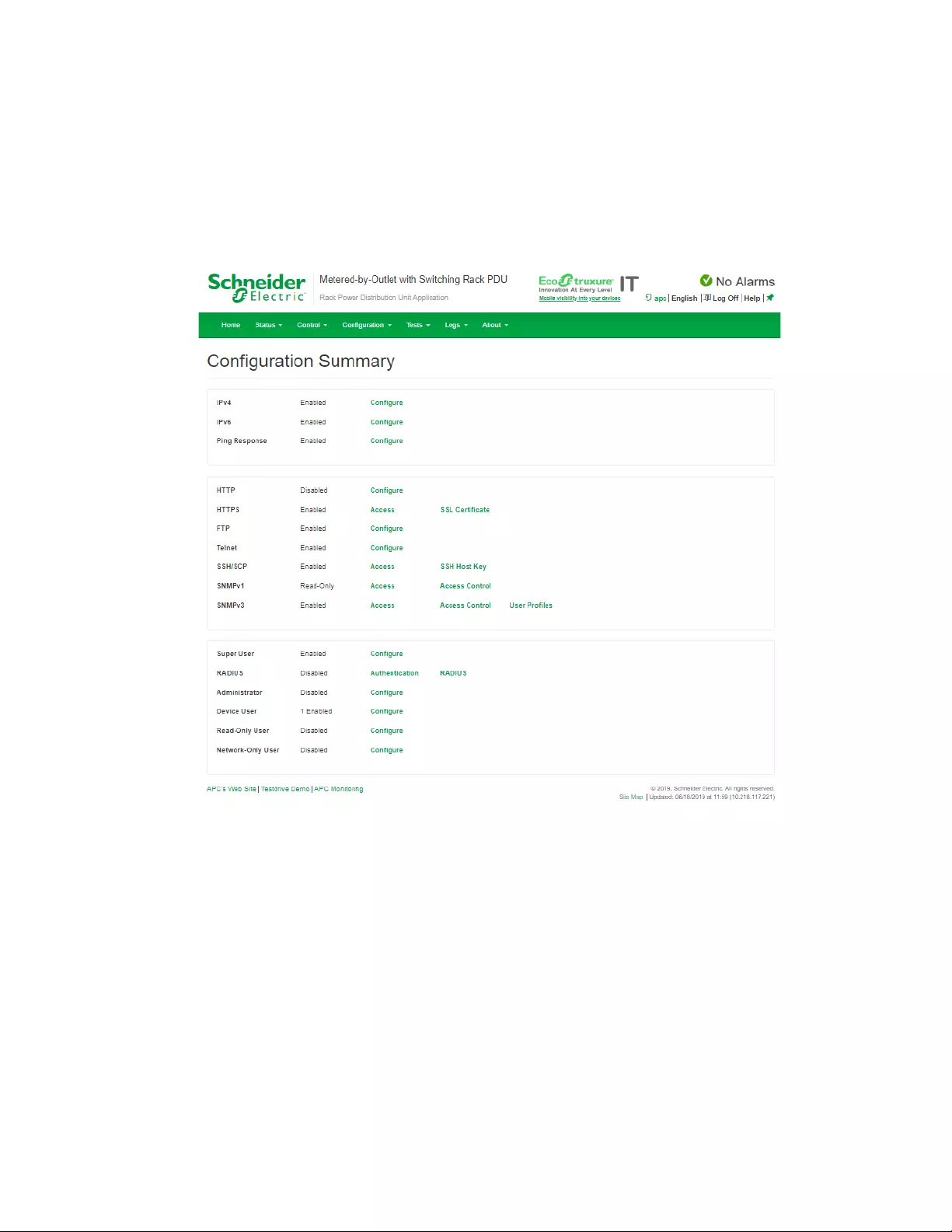
135Metered by Outlet with Switching Rack PDU AP86XX User Guide
Network Features
Protocol Configuration Summary
Path: Configuration > Network > Summary
You can use this page to view all protocols enabled or disabled on your Rack PDU. Select a link for any
protocol to go to the appropriate configuration page.

Metered by Outlet with Switching Rack PDU AP86XX User Guide136
TCP/IP and Communication Settings
TCP/IP:
Path: Configuration > Network > TCP/IP
The TCP/IP option on the left navigation menu, selected by default when you choose Network on the top
menu bar, displays the current IPv4 address, subnet mask, default gateway, MAC address, and boot mode of
the Rack PDU. For information on DHCP and DHCP options, see RFC2131 and RFC2132.
Setting Description
Enable Enable or disable IPv4 with this check box.
Manual Configure IPv4 manually by entering the IP address, subnet mask, and default gateway.
BOOTP
A BOOTP server provides the TCP/IP settings. At 32-second intervals, the Rack PDU
requests network assignment from any BOOTP server:
• If the Rack PDU receives a valid response, it starts the network services.
• If the Rack PDU finds a BOOTP server, but a request to that server fails or times out,
the Rack PDU stops requesting network settings until it is restarted.
• By default, if previously configured network settings exist, and the Rack PDU receives
no valid response to five requests (the original and four retries), it uses the previously
configured settings so that it remains accessible.
Click Next>> to access the BOOTP Configuration page to change the number of retries or
the action to take if all retries fail:1
•Maximum retries: Enter the number of retries that will occur when no valid response is
received, or zero (0) for an unlimited number of retries.
•If retries fail: Select Use prior settings
(the default) or Stop BOOTP request.
DHCP
The default setting. At 32-second intervals, the Rack PDU requests network assignment
from any DHCP server.
• If the Rack PDU receives a valid response, it does not (as previously) require the APC
cookie from the DHCP server in order to accept the lease and start the network
services.
• If the Rack PDU finds a DHCP server, but the request to that server fails or times out, it
stops requesting network settings until it is restarted.1
•Require vendor specific cookie to accept DHCP Address: By selecting this check
box, you can require the DHCP server to provide a cookie which supplies information to
the Rack PDU.
1.
The default values for these three settings on the configuration pages generally do not need to be changed:
•Vendor Class: APC
•Client ID: The MAC address of the Rack PDU, which uniquely identifies it on the local area network (LAN)
•User Class: The name of the application firmware module

137Metered by Outlet with Switching Rack PDU AP86XX User Guide
DHCP response options:
Each valid DHCP response contains options that provide the TCP/IP settings that the Rack PDU needs to
operate on a network, and other information that affects the operation of the Rack PDU.
Vendor Specific Information (option 43):
The Rack PDU uses this option in a DHCP response to
determine whether the DHCP response is valid. This option contains an APC-specific option in a TAG/LEN/
DATA format, called the APC Cookie. This is disabled by default.
• APC Cookie. Tag 1, Len 4, Data “1APC”
Option 43 communicates to the Rack PDU that a DHCP server is configured to service devices.
Following, in hexadecimal format, is an example of a Vendor Specific Information option that contains the APC
cookie:
Option 43 = 0x01 0x04 0x31 0x41 0x50 0x43
TCP/IP options:
The Rack PDU uses the following options within a valid DHCP response to define its TCP/
IP settings. All of these options except the first are described in RFC2132.
• IP Address (from the yiaddr field of the DHCP response, described in RFC2131): The IP address
that the DHCP server is leasing to the Rack PDU.
• Subnet Mask (option 1): The Subnet Mask value that the Rack PDU needs to operate on the
network.
• Router, i.e., Default Gateway (option 3): The default gateway address that the Rack PDU needs
to operate on the network.
• IP Address Lease Time (option 51): The time duration for the lease of the IP Address to the Rack
PDU.
• Renewal Time, T1 (option 58): The time that the Rack PDU must wait after an IP address lease is
assigned before it can request a renewal of that lease.
• Rebinding Time, T2 (option 59): The time that the Rack PDU must wait after an IP address lease
is assigned before it can seek to rebind that lease.
Other options:
The Rack PDU also uses these options within a valid DHCP response. All of these options
except the last are described in RFC2132.
• Network Time Protocol Servers (option 42): Up to two NTP servers (primary and secondary)
that the Rack PDU can use.
• Time Offset (option 2): The offset of the Rack PDU's subnet, in seconds, from Coordinated
Universal Time (UTC).
• Domain Name Server (option 6): Up to two Domain Name System (DNS) servers (primary and
secondary) that the Rack PDU can use.
• Host Name (option 12): The host name that the Rack PDU will use (32-character maximum
length).
• Domain Name (option 15): The domain name that the Rack PDU will use (64-character maximum
length).
• Boot File Name (from the file field of the DHCP response, described in RFC2131): The fully
qualified directory-path to a user configuration file (.ini file) to download. The siaddr field of the
DHCP response specifies the IP address of the server from which the Rack PDU will download
the .ini file. After the download, the .ini file is used as a boot file to reconfigure the settings.

Metered by Outlet with Switching Rack PDU AP86XX User Guide138
Path: Configuration > Network > TCP/IP > IPv6 settings
Port Speed
Path: Configuration > Network > Port Speed
The Port Speed setting defines the communication speed of the TCP/IP port.
• For Auto-negotiation (the default), Ethernet devices negotiate to transmit at the highest possible
speed, but if the supported speeds of two devices are unmatched, the slower speed is used.
• Alternatively, you can choose 10 Mbps or 100 Mbps, each with the option of half-duplex
(communication in only one direction at a time) or full-duplex (communication in both directions on
the same channel simultaneously).
Setting Description
Enable Enable or disable IPv6 with this check box.
Manual Configure IPv6 manually by entering the IP address and the default gateway.
Auto
Configuration
When the Auto Configuration check box is selected, the system obtains addressing
prefixes from the router (if available). It uses those prefixes to automatically configure
IPv6 addresses.
DHCPv6
Mode
Router Controlled: Selecting this option means that DHCPv6 is controlled by the
Managed(M) and Other(O) flags received in IPv6 router advertisements. When a
router advertisement is received, the Rack PDU checks whether the M or the O flag is
set. The Rack PDU interprets the state of the M (Managed Address Configuration
Flag) and O (Other Stateful Configuration Flag) "bits" for the following cases:
•Neither is set: Indicates the local network has no DHCPv6 infrastructure. The Rack
PDU uses router advertisements and manual configuration to get addresses that
are not link-local and other settings.
•M, or M and O are set: In this situation, full DHCPv6 address configuration occurs.
DHCPv6 is used to obtain addresses AND other configuration settings. This is
known as DHCPv6 stateful. Once the M flag has been received, the DHCPv6
address configuration stays in effect until the interface in question has been closed.
This is true even if subsequent router advertisement packets are received in which
the M flag is not set.
If an O flag is received first, then an M flag is received subsequently, the Rack PDU
performs full address configuration upon receipt of the M flag
•Only O is set: In this situation, the Rack PDU sends a DHCPv6 Info-Request
packet. DHCPv6 will be used to configure “other” settings (such as location of DNS
servers), but NOT to provide addresses. This is known as DHCPv6 stateless.
Address and Other Information: With this radio box selected, DHCPv6 is used to
obtain addresses AND other configuration settings. This is known as DHCPv6
stateful.
Non-Address Information Only: With this radio box selected, DHCPv6 will be used
to configure "other" settings (such as location of DNS servers), but NOT to provide
addresses. This is known as DHCPv6 stateless.
Never: Select this to disable DHCPv6.

139Metered by Outlet with Switching Rack PDU AP86XX User Guide
DNS
Configuration:
Path: Configuration > Network > DNS > Configuration
Use the options under Configuration to configure and test the Domain Name System (DNS):
• Override Manual DNS Settings: Selection of Override Manual DNS Settings will result in
configuration data from other sources (typically DHCP) taking precedence over the manual
configurations set here.
• Select
Primary DNS Server or Secondary DNS Server to specify the IPv4 or IPv6 addresses of
the primary and optional secondary DNS server. For the Rack PDU to send email, you must at
least define the IP
address of the primary DNS server.
– The Rack PDU waits up to 15 seconds for a response from the primary DNS server or
secondary DNS server (if specified). If the Rack PDU does not receive a response within that
time, email cannot be sent. Use DNS servers on the same segment as the Rack PDU or on a
nearby segment (but not across a wide-area network [WAN]).
– Define the IP addresses of the DNS servers then enter the DNS name of a computer on your
network to look up the IP address for that computer to verify correct operation.
• System Name Synchronization: Allow the system name to be synchronized with the host name
so both fields automatically contain the same value.
NOTE: When enabling this feature, the system name identifier can no longer contain a space
character (since it will be synchronized to the host name field).
• Host Name: Configure a host name here and a domain name in the Domain Name field then
users can enter a host name in any field in the Rack PDU interface (except email addresses) that
accepts a domain name.
• Domain Name (IPv4/IPv6): Configure the domain name here only. In all other fields in the Rack
PDU interface (except email addresses) that accept domain names, the Rack PDU adds this
domain name when only a host name is entered.
– To override all instances of the expansion of a specified host name by the addition of the
domain name, set the domain name field to its default, somedomain.com, or to 0.0.0.0.
– To override the expansion of a specific host name entry, include a trailing period. The Rack
PDU recognizes a host name with a trailing period (such as mySnmpServer.) as if it were a
fully-qualified domain name and does not append the domain name.
• Domain Name (IPv6): Specify the IPv6 domain name here.
Test:
Path: Configuration > Network > DNS > Test
Use this option to send a DNS query that tests the setup of your DNS servers by looking up the IP address.
View the result of a test in the Last Query Response field.
• Select
test to send a DNS query that tests the setup of your DNS servers:
–As Query Question, identify the value to be used for the selected query type:
Query Type Selected Query Question to Use
by Host The URL
by FQDN The fully qualified domain name, my_server.my_domain
by IP The IP address
by MX The Mail Exchange address

Metered by Outlet with Switching Rack PDU AP86XX User Guide140
Web
Path: Configuration > Network > Web > Configuration
Option Description
access
To activate changes to any of these selections, log off from the Rack PDU:
•Disable: Disables access to the Web UI. (To re-enable access, log in to the Command
Line Interface, then type the command http -S enable. For HTTPS access, type
https -S enable.)
•Enable HTTP: Enables Hypertext Transfer Protocol (HTTP), which provides Web
access by user name and password, but does not encrypt user names, passwords,
and data during transmission. HTTP is disabled by default.
•Enable Enables Hypertext Transfer Protocol (HTTPS) over Secure Sockets Layer/
Transport Layer Security (SSL/TLS). SSL/TLS encrypts user names, passwords, and
data during transmission, and authenticates the Rack PDU by digital certificate. When
HTTPS is enabled, your browser displays a small lock icon. HTTPS is enabled by
default.
• See “Creating and Installing Digital Certificates” in the Security Handbook, available at
www.apc.com.
HTTP Port: The TCP/IP port (80 by default) used to communicate by HTTP with the
Rack PDU.
HTTPS Port: The TCP/IP port (443 by default) used to communicate by HTTPS with the
Rack PDU.
For either of these ports, you can change the port setting to any unused port from 5000 to
32768 for additional security. Users must then use a colon (:) in the address field of the
browser to specify the port number. For example, for a port number of 5000 and an IP
address of 152.214.12.114:
http://152.214.12.114:5000
https://152.214.12.114:5000
Minimum Protocol: Choose from the drop down menu - SSL 3.0, TLS 1.0, TLS 1.1, or
TLS 1.2
Require Authentication Cookie: Click to put a check the Enable box.
Limited Status Access: Click to put a check in the box before Enable or Use as a
default page.

141Metered by Outlet with Switching Rack PDU AP86XX User Guide
ssl
certificate
Add, replace, or remove a security certificate.
Status:
•Not installed: A certificate is not installed, or was installed by FTP or SCP to an
incorrect location. Using Add or Replace Certificate File installs the certificate to the
correct location, /ssl on the Rack PDU.
•Generating: The Rack PDU is generating a certificate because no valid certificate
was found.
•Loading: A certificate is being activated on the Rack PDU.
•Valid certificate: A valid certificate was installed or was generated by the Rack PDU.
Click on this link to view the contents of the certificate.
If you install an invalid certificate, or if no certificate is loaded when you enable
SSL/TLS, the Rack PDU generates a default certificate, a process which delays
access to the interface for up to one minute. You can use the default certificate for
basic encryption-based security, but a security alert message displays whenever you log
on.
Add or Replace Certificate File: Enter or browse to the certificate file created with the
Security Wizard.
See “Creating and Installing Digital Certificates” in the Security Handbook, available at
www.apc.com, to choose a method for using digital certificates created by the Security
Wizard or generated by the Rack PDU.
Remove: Delete the current certificate.
Option Description

Metered by Outlet with Switching Rack PDU AP86XX User Guide142
Console
Path:
Configuration > Network > Console >
options
NOTE:
To use SSH, you must have an SSH client installed. Most Linux and other UNIX platforms
include an SSH client, but Microsoft Windows operating systems do not. Clients are available from
various vendors.
Option Description
access
•Disable: Disables all access to the Command Line Interface.
•Enable Telnet: Telnet transmits user names, passwords, and data without encryption.
Telnet is disabled by default.
•Enable SSH: SSH transmits user names, passwords, and data in encrypted form,
providing protection from attempts to intercept, forge, or alter data during transmission.
SSH is enabled by default.
Configure the ports to be used by these protocols:
•Telnet Port: The Telnet port used to communicate with the Rack PDU (23 by default).
You can change the port setting to any unused port from 5000 to 32768 for additional
security. Users must then use a colon (:) or a space, as required by your Telnet client
program, to specify the non-default port. For example, for port 5000 and an IP address
of 152.214.12.114, your Telnet client requires one of the these commands:
telnet 152.214.12.114:5000
telnet 152.214.12.114 5000
•SSH Port: The SSH port used to communicate with the Rack PDU (22 by default). You
can change the port setting to any unused port from 5000 to 32768 for additional
security. See the documentation for your SSH client for the command line format
required to specify a non-default port.
ssh host
key
Status indicates the status of the host key (private key):
•SSH Disabled: No host key in use: When disabled, SSH cannot use a host key.
•Generating: The Rack PDU is creating a host key because no valid host key was
found.
•Loading: A host key is being activated on the Rack PDU.
•Valid: One of the following valid host keys is in the /ssh directory (the required location
on the Rack PDU):
•A 1024-bit or 2048-bit host key created by the Security Wizard
•A 2048-bit RSA host key generated by the Rack PDU
Add or Replace: Browse to and upload a host key file created by the Security Wizard.
To use the Security Wizard, see the Security Handbook, available at www.apc.com.
NOTE: To reduce the time required to enable SSH, create and upload a host key in
advance. If you enable SSH with no host key loaded, the Rack PDU takes up to one
minute to create a host key, and the SSH server is not accessible during that time.
Remove: Remove the current host key.

143Metered by Outlet with Switching Rack PDU AP86XX User Guide
SNMP
All user names, passwords, and community names for SNMP are transferred over the network as plain text. If
your network requires the high security of encryption, disable SNMP access or set the access for each
community to Read. (A community with Read access can receive status information and use SNMP traps.)
When using StruxureWare Data Center Expert to manage a Rack PDU on the public network, you must have
SNMP enabled in the Rack PDU interface. Read access will allow the StruxureWare Data Center Expert to
receive traps from the Rack PDU, but Write access is required while you use the interface of the Rack PDU to
set the StruxureWare Data Center Expert as a trap receiver.
For detailed information on enhancing and managing the security of your system, see the Security Handbook,
available at www.apc.com.
Network Port Sharing:
All Rack PDUs in a group can be accessed through the Host Rack PDU via SNMP "rPDU2" OIDs available in
our PowerNet-MIB.
The full path to these OIDs is:
iso(1).org(3).dod(6).internet(1).private(4).enterprises(1).apc(318).products(1).
hardware(1).rPDU2(26)
Individual Rack PDUs can be identified in the SNMP MIB tables by viewing the corresponding "Module" OIDs
in each table. These Module OIDs will return the Display ID of the Rack PDU.
Example Module OIDs: rPDU2IdentModule, rPDU2DeviceConfigModule,
rPDU2SensorTempHumidityConfigModule
In order to be backwards compatible with previous versions, the Host Rack PDU will always be the first index in
any table that supports multiple Rack PDUs. In addition, after the Rack PDU group is set up, the index order of
guest Rack PDUs should not change even if the Display ID is changed or a PDU temporarily loses
communication. The index order should only change if you manually remove a Rack PDU from the group.
A MIB table walk should skip the indexes associated with a Rack PDU that has temporarily lost
communication.

Metered by Outlet with Switching Rack PDU AP86XX User Guide144
SNMPv1
Path: Configuration > Network > SNMPv1 > options
NOTE: SNMPv1 is disabled by default. SNMPv2c is supported under SNMPv1 in this configuration.
Option Description
access Enable SNMPv1 Access: Enables SNMP version 1 as a method of communication with
this device. NOTE: This configuration also supports SNMPv2c.
access
control
You can configure up to four access control entries to specify which Network
Management Systems (NMSs) have access to this device. The opening page for access
control, by default, assigns one entry to each of the four available SNMPv1 communities,
but you can edit these settings to apply more than one entry to any community to grant
access by several specific IPv4 and IPv6 addresses, host names, or IP address masks.
To edit the access control settings for a community, click its community name.
• If you leave the default access control entry unchanged for a community, that
community has access to this device from any location on the network.
• If you configure multiple access control entries for one community name, the limit of
four entries requires that one or more of the other communities must have no access
control entry. If no access control entry is listed for a community, that community has
no access to this device.
Community Name: The name that an NMS must use to access the community. The
maximum length is 15 ASCII characters.
NMS IP/Host Name: The IPv4 or IPv6 address, IP address mask, or host name that
controls access by NMSs. A host name or a specific IP address (such as 149.225.12.1)
allows access only by the NMS at that location. IP addresses that contain 255 restrict
access as follows:
• 149.225.12.255: Access only by an NMS on the 149.225.12 segment.
• 149.225.255.255: Access only by an NMS on the 149.225 segment.
• 149.255.255.255: Access only by an NMS on the 149 segment.
• 0.0.0.0 (the default setting) which can also be expressed as 255.255.255.255: Access
by any NMS on any segment.
Access Type: The actions an NMS can perform through the community.
•Read: GETS only, at any time
•Write: GETS at any time, and SETS when no user is logged onto the Web UI or CLI.
•Write+: GETS and SETS at any time.
•Disable: No GETS or SETS at any time.

145Metered by Outlet with Switching Rack PDU AP86XX User Guide
SNMPv3
Path: Configuration > Network > SNMPv3 > options
For SNMP GETs, SETs, and trap receivers, SNMPv3 uses a system of user profiles to identify users. An
SNMPv3 user must have a user profile assigned in the MIB software program to perform GETs and SETs,
browse the MIB, and receive traps.
NOTE:
SNMPv3 is disabled by default. To use SNMPv3, you must have a MIB program that supports
SNMPv3.
The Rack PDU supports SHA or MD5 authentication and AES or DES encryption.
Option Description
access SNMPv3 Access: Enables SNMPv3 as a method of communication with this device.
user
profiles
By default, lists the settings of four user profiles, configured with the user names apc
snmp profile1 through apc snmp profile4, and no authentication and no privacy (no
encryption). To edit the following settings for a user profile, click a user name in the list.
User Name: The identifier of the user profile. SNMP version 3 maps GETs, SETs, and
traps to a user profile by matching the user name of the profile to the user name in the
data packet being transmitted. A user name can have up to 32 ASCII characters.
Authentication Passphrase: A phrase of 15 to 32 ASCII characters that verifies that the
NMS communicating with this device through SNMPv3 is the NMS it claims to be, that the
message has not been changed during transmission, and that the message was
communicated in a timely manner, indicating that it was not delayed and that it was not
copied and sent again later at an inappropriate time.
Privacy Passphrase: A phrase of 15 to 32 ASCII characters that ensures the privacy of
the data (by means of encryption) that an NMS is sending to this device or receiving from
this device through SNMPv3.
Authentication Protocol: The APC by Schneider Electric implementation of SNMPv3
supports SHA and MD5 authentication. Authentication will not occur unless an
authentication protocol is selected.
Privacy Protocol: The implementation of SNMPv3 supports AES and DES as the
protocols for encrypting and decrypting data. Privacy of transmitted data requires that a
privacy protocol is selected and that a privacy passphrase is provided in the request from
the NMS. When a privacy protocol is enabled but the NMS does not provide a privacy
passphrase, the SNMP request is not encrypted.
NOTE: You cannot select the privacy protocol if no authentication protocol is selected.

Metered by Outlet with Switching Rack PDU AP86XX User Guide146
FTP Server
Path: Configuration > Network > FTP Server
The FTP Server settings enable or disable access to the FTP server. FTP is disabled by default.
By default, the FTP server communicates with the Rack PDU through TCP/IP port 21. The FTP server uses
both the specified port and the port one number lower than the specified port.
You can change the Port setting to the number of any unused port from 5001 to 32768 for added security.
Users must then use a colon (:) to specify the non-default port number. For example, for port 5001 and IP
address 152.214.12.114, the command would be ftp 152.214.12.114:5001.
NOTE: FTP transfers files without encryption. For higher security, transfer files with Secure CoPy (SCP).
Secure SHell (SSH) is enabled by default, and enables SCP automatically. However, SCP will not allow a file
transfer until the Super User default password (apc) is changed. At any time that you want a Rack PDU to be
accessible for management by StruxureWare Data Center Expert, FTP server access must be enabled in the
Rack PDU interface.
For detailed information on enhancing and managing the security of your system, see the Security Handbook,
available at www.apc.com.
access
control
You can configure up to four access control entries to specify which NMSs have access to
this device. The opening page for access control, by default, assigns one entry to each of
the four user profiles, but you can edit these settings to apply more than one entry to any
user profile to grant access by several specific IP addresses, host names, or IP address
masks.
• If you leave the default access control entry unchanged for a user profile, all NMSs that
use that profile have access to this device.
• If you configure multiple access entries for one user profile, the limit of four entries
requires that one or more of the other user profiles must have no access control entry.
If no access control entry is listed for a user profile, no NMS that uses that profile has
any access to this device.
To edit the access control settings for a user profile, click its user name.
Access: Mark the Enable checkbox to activate the access control specified by the
parameters in this access control entry.
User Name: From the drop-down list, select the user profile to which this access control
entry will apply. The choices available are the four user names that you configure through
the user profiles option on the left navigation menu.
NMS IP/Host Name: The IP address, IP address mask, or host name that controls
access by the NMS. A host name or a specific IP address (such as 149.225.12.1) allows
access only by the NMS at that location. An IP address mask that contains 255 restricts
access as follows:
• 149.225.12.255: Access only by an NMS on the 149.225.12 segment.
• 149.225.255.255: Access only by an NMS on the 149.225 segment.
• 149.255.255.255: Access only by an NMS on the 149 segment.
• 0.0.0.0 (the default setting) which can also be expressed as 255.255.255.255: Access
by any NMS on any segment.
Option Description

147Metered by Outlet with Switching Rack PDU AP86XX User Guide
Notifications
Event Actions
Path: Configuration > Notification
Types of notification:
You can configure event actions to occur in response to an event or group of events. These actions notify users
of the event in any of several ways:
• Active, automatic notification. The specified users or monitoring devices are contacted directly.
– Email notification
–SNMP traps
– Syslog notification
• Indirect notification
– Event log. If no direct notification is configured, users must check the log to determine which
events have occurred
You can also log system performance data to use for device monitoring. See “Logs in the
Configuration Menu” on page 155 for information on how to configure and use this data
logging option.
– Queries (SNMP GETs)
For more information, see “SNMP” on page 143. SNMP enables an NMS to perform
informational queries. For SNMPv1, which does not encrypt data before transmission,
configuring the most restrictive SNMP access type (READ) enables informational queries
without the risk of allowing remote configuration changes.
Configure event actions
Path: Configuration > Notification > Event Actions > By Event
By default, logging an event is selected for all events. To define event actions for an individual event:
1. To find an event, click on a column heading to see the lists under the Device Events or System
Events categories.
Or you can click on a sub-category under these headings, like Security or Temperature.
2. Click on the event name to view or change the current configuration, such as recipients to be
notified by email, or Network Management Systems (NMSs) to be notified by SNMP traps.
If no Syslog server is configured, items related to Syslog configuration are not displayed.
NOTE: When viewing details of an event configuration, you can enable or disable event logging or Syslog, or
disable notification for specific email recipients or trap receivers, but you cannot add or remove recipients or
receivers. To add or remove recipients or receivers, see the following:
• “Identifying Syslog servers” on page 155
• “Configuration > Notification > Email > Recipients” on page 150
• “SNMP trap receiver screen” on page 151

Metered by Outlet with Switching Rack PDU AP86XX User Guide148
Path: Configuration > Notification > Event Actions > By Group
To configure a group of events simultaneously:
1. Select how to group events for configuration:
–Select
Events by Severity, and then select one or more severity levels. You cannot change
the severity of an event.
–Select
Events by Category, and then select all events in one or more pre-defined categories.
2. Click Next to move to the next screen to do the following:
– Select event actions for the group of events.
• To select any action except Logging (the default), you must first have at least one
relevant recipient or receiver configured.
• If you selected Logging and have configured a Syslog server, select Event Log or
Syslog on the next screen. See “Logs in the Configuration Menu” on page155
3. Click Next to move to the next screen to do the following:
– If you selected Logging on the previous screen, select Enable Notifications or Disable
Notification.
– If you selected Email Recipients on the previous screen, select the email recipients to
configure.
– If you selected Trap Receivers on the previous screen, select the trap receiver to configure.
4. Click Next to move to the next screen to do the following:
– If you are configuring Logging settings, view the pending actions and click Apply to accept
the changes or click Cancel to revert to the previous settings.
– If you are configuring Email Recipients or Trap Receivers, select Enable Notifications or
Disable Notification and set the notification timing settings (see “Notification parameters:” on
page 148 for more information on these settings).
5. Click Next to move to the next screen to do the following:
– View the pending actions and click Apply to accept the changes or click Cancel to revert to
the previous settings.
Notification parameters:
These configuration fields define email parameters for sending notifications of
events.
They are usually accessed by clicking the receiver or recipient name.
NOTE: For events that have an associated clearing event, you can also set these parameters.
Field Description
Delay n time before
sending
If the event persists for the specified time, the notification is sent. If the
condition clears before the time expires, no notification is sent.
Repeat at an interval of n The notification is sent repeatedly at the specified interval (the default is
every 2 minutes until the condition clears).
Up to n times During an active event, the notification repeats for this number of times.
or
Until condition clears The notification is sent repeatedly until the condition clears or is
resolved.

149Metered by Outlet with Switching Rack PDU AP86XX User Guide
Email notification screens
Use Simple Mail Transfer Protocol (SMTP) to send email to up to four recipients when an event occurs. To use
the email feature, you must define the following settings:
• The IP addresses of the primary and, optionally, the secondary Domain Name System (DNS)
servers.
• The IP address or DNS name for the SMTP Server and From Address.
• The email addresses for a maximum of four recipients.
• You can use the To Address setting of the recipients option to send email to a text-based screen.
Path: Configuration > Notification > email > Server
This screen lists your primary and secondary DNS servers and displays the following fields:
From Address:
The contents of the From field in email messages sent by the Rack PDU:
• In the format user@ [IP_address] (if an IP address is specified as Local SMTP Server)
• In the format user@domain (if DNS is configured and the DNS name is specified as Local SMTP
Server) in the email messages.
NOTE: The local SMTP server may require that you use a valid user account on the server for this
setting. See the server documentation.
SMTP Server:
The IPv4/ IPv6 address or DNS name of the local SMTP server.
NOTE: This definition is required only when the SMTP server is set to Local.
Authentication:
Enable this if the SMTP server requires authentication.
Port:
The SMTP port number, with a default of 25. The range is 25, 465, 587, 2525, 5000 to 32768.
User Name, Password, and Confirm Password:
If your mail server requires authentication, enter your
user name and password here. This performs a simple authentication, not SSL/TLS.
Use SSL/TLS:
Select when encryption is used.
•
Never: The SMTP server does not require nor support encryption.
•
If Supported: The SMTP server advertises support for STARTTLS but doesn't require the
connection to be encrypted. The STARTTLS command is sent after the advertisement is given.
•
Always: The SMTP server requires the STARTTLS command to be sent on connection to it.
•
Implicitly: The SMTP server only accepts connections that begin encrypted. No STARTTLS
message is sent to the server.
Require CA Root Certificate:
This should only be enabled if the security policy of your organization does
not allow for implicit trust of SSL/TLS connections. If this is enabled, a valid root CA certificate must be loaded
onto the Rack PDU for encrypted emails to be sent.
File Name:
This field is dependent on the root CA certificates installed on the Rack PDU and whether or not
a root CA certificate is required.

Metered by Outlet with Switching Rack PDU AP86XX User Guide150
Path: Configuration > Notification > Email > Recipients
Specify up to four email recipients. Click on a name to configure the settings.
Generation:
Enables (default) or disables sending email to the recipient.
To Address:
The user and domain names of the recipient. To use email for paging, use the email address
for the recipient’s pager gateway account (for example, myacct100@skytel.com). The pager gateway will
generate the page.
To bypass the DNS lookup of the IP address of the mail server, use the IP address in brackets instead of the
email domain name, e.g., use jsmith@[xxx.xxx.x.xxx] instead of jsmith@company.com. This is useful when
DNS lookups are not working correctly.
Language:
The language which the email notification will be sent in. This is dependent on the installed
language pack (if applicable).
Port:
The SMTP port number, with a default of 25. The range is 25, 465, 587, 2525, 5000 to 32768.
Format:
The long format contains name, location, contact, IP address, serial number of the device, date and
time, event code, and event description. The short format provides only the event description.
Server:
Select one of the following methods for routing email:
•
Local: This is through the site-local SMTP server. This recommended setting ensures that the
email is sent using the site-local SMTP server. Choosing this setting limits delays and network
outages and retries sending email for many hours. When choosing the Local setting you must
also enable forwarding at the SMTP server of your device and set up a special external email
account to receive the forwarded email. Check with your SMTP server administrator before
making these changes.
•
Recipient: This is the SMTP server of the recipient. The Rack PDU performs an MX record look-
up on the recipients email address and uses that as its SMTP server. The email is only sent once
so it could easily be lost.
•
Custom: This setting enables each email recipient to have its own server settings. These settings
are independent of the settings given under “SMTP Server” above.
Path: Configuration > Notification > Email > SSL Certificates
Load a mail SSL/TLS certificate on the Rack PDU for greater security. The file must have an extension of .crt
or .cer. Up to five files can be loaded at any given time.
When installed, the certificate details also display here. An invalid certificate will display “n/a” for all fields
except File Name.
Certificates can be deleted using this screen. Any email recipients using the certificate should be manually
modified to remove reference to this certificate.
Path: Configuration > Notification > Email > Test
Send a test message to a configured recipient.

151Metered by Outlet with Switching Rack PDU AP86XX User Guide
SNMP trap receiver screen
Path: Configuration > Notification > SNMP Traps > Trap Receivers
With Simple Network Management Protocol (SNMP) traps, you can automatically get notifications for
significant Rack PDU events. They are a useful tool for monitoring devices on your network.
The trap receivers are displayed by NMS IP/Host Name, where NMS stands for Network Management
System. You can configure up to six trap receivers.
To configure a new trap receiver, click Add Trap Receiver. To edit (or delete) one, click its IP address/host
name.
Trap Generation:
Enable (the default) or disable trap generation for this trap receiver.
NMS IP/Host Name:
The IPv4/ IPv6 address or host name of this trap receiver. The default, 0.0.0.0, leaves
the trap receiver undefined.
Language:
Select a language from the drop-down list. This can differ from the Web UI and from other trap
receivers.
Select either the SNMPv1 or SNMPv3 radio button to specify the trap type. For an NMS to receive both types
of traps, you must separately configure two trap receivers for that NMS, one for each trap type.
SNMPv1:
Settings for SNMPv1.
•
Community Name: The name used as an identifier when SNMPv1 traps are sent to this trap
receiver.
•
Authenticate Traps: When this option is enabled (the default), the NMS identified by the NMS IP/
Host Name setting will receive authentication traps (traps generated by invalid attempts to log on
to this device).
SNMPv3:
Settings for SNMPv3.
•
User Name: Select the identifier of the user profile for this trap receiver.
If you delete a trap receiver, all notification settings configured under “Configuring event actions” for the
deleted trap receiver are set to their default values.
SNMP traps test screen
Path: Configuration > Notification > SNMP Traps > Test
Last Test Result:
The result of the most recent SNMP trap test. A successful SNMP trap test verifies only
that a trap was sent; it does not verify that the trap was received by the selected trap receiver. A trap test
succeeds if all of the following are true:
• The SNMP version (SNMPv1 or SNMPv3) configured for the selected trap receiver is enabled on
this device.
• The trap receiver itself is enabled.
• If a host name is selected for the To address, that host name can be mapped to a valid IP
address.
To:
Select the IP address or host name to which a test SNMP trap will be sent. If no trap receiver is
configured, a link to the Trap Receiver configuration screen is displayed.

Metered by Outlet with Switching Rack PDU AP86XX User Guide152
General Menu
This menu contains miscellaneous configuration items including device identification, date and time, exporting
and importing your Rack PDU configuration options, the three links at the bottom left of the screen, and
consolidating data for troubleshooting purposes.
Identification screen
Path: Configuration > General > Identification
Define the Name, the Location (the physical location), and the Contact (the person responsible for the
device) used by:
• the SNMP agent of the Rack PDU and
• StruxureWare Data Center Expert
Specifically, the name field is used by the sysName, sysContact, and sysLocation object identifiers (OIDs) in
the SNMP agent of the Rack PDU. For more information about MIB-II OIDs, see the PowerNet® SNMP
Management Information Base (MIB) Reference Guide, available at www.apc.com.
Host Name Synchronization allows the host name to be synchronized with the system name so both fields
automatically contain the same value.
NOTE: When enabling this feature, the system name identifier can no longer contain a space character (since
it will be synchronized to the host name field).
System Message:
When defined, a custom message will appear on the log on screen for all users.

153Metered by Outlet with Switching Rack PDU AP86XX User Guide
Date/Time screen
Path: Configuration > General > Date/Time > Mode
Set the time and date used by the Rack PDU. (Note that the time format used is 24 hour only.) You can change
the current settings manually or through a Network Time Protocol (NTP) Server:
With both, you select the Time Zone. This is your local time difference with Coordinated Universal Time (UTC),
also known as Greenwich Mean Time (GMT).
NOTE: Use the 24 hour time format ONLY for setting time.
Manual Mode:
Do one of the following:
• Enter the date and time for the Rack PDU
• Select the check box Apply Local Computer Time to apply the date and time settings of the
computer you are using
Synchronize with NTP Server:
Have an NTP (Network Time Protocol) Server define the date and time for
the Rack PDU. By default, any Rack PDU on the private side of a StruxureWare Data Center Expert obtains its
time settings by using StruxureWare Data Center Expert as an NTP server.
• Override Manual NTP Settings: If you select this, data from other sources (typically DHCP) take
precedence over the NTP configurations you set here.
• Primary NTP Server: Enter the IP address or domain name of the primary NTP server.
• Secondary NTP Server: Enter the IP address or domain name of the secondary NTP server,
when a secondary server is available.
• Update Interval: Define, in hours, how often the Rack PDU accesses the NTP Server for an
update. Minimum: 1; Maximum: 8760 (1 year).
• Update Using NTP Now: Initiate an immediate update of the date and time by the NTP Server.
Daylight Saving:
Path: Configuration > General > Date /Time > Daylight Saving
Daylight Saving Time (DST) is disabled by default. You can enable traditional United States DST, or enable and
configure a customized daylight saving time to match how Daylight Saving Time is implemented in your local
area.
When customizing DST, the system puts the clock forward by an hour when the time and date you specify
under Start is reached and puts the clock back an hour when the time and date you specify under End is
reached.
• If your local DST always starts or ends on the fourth occurrence of a specific weekday of a month
(e.g., the fourth Sunday), choose Fourth/Last. If a fifth Sunday occurs in that month, you should
still choose Fourth/Last.
• If your local DST always starts or ends on the last occurrence of a specific weekday of a month,
whether it is the fourth or the fifth occurrence, choose Fifth/Last.

Metered by Outlet with Switching Rack PDU AP86XX User Guide154
Creating and importing settings with the config file
Path: Configuration > General > User Config File
Use the settings from one Rack PDU to configure another. Retrieve the config.ini file from the configured Rack
PDU, customize that file (e.g., change the IP address), and upload the customized file to the new Rack PDU.
The file name can be up to 64 characters, and must have the.ini suffix.
To retrieve and customize the file of a configured Rack PDU, see “How to Export Configuration Settings” on
page 166.
Instead of uploading the file to one Rack PDU, you can export the file to multiple Rack PDUs by using an FTP
or SCP script.
Configure Links
Path: Configuration > General > Quick Links
Select Configuration > General > Quick Links to view and change the URL links displayed at the bottom left
of each page of the interface.
By default, these links access the following Web pages:
•
Link 1: The home page of the APC by Schneider Electric website
•
Link 2: Demonstrations of APC by Schneider Electric web-enabled products
• Link 3: Information on EcoStruxure IT
Status Reports the progress of the upload. The upload succeeds even if the file contains errors,
but a system event reports the errors in the event log.
Upload Browse to the customized file and upload it so that the current Rack PDU can use it to set
its own configuration.
Download Allows the download of the Configuration File (config.ini) file directly through the Web
browser to the user's computer.

155Metered by Outlet with Switching Rack PDU AP86XX User Guide
Logs in the Configuration Menu
Identifying Syslog servers
Path: Configuration > Logs > Syslog > Servers
Click Add Server to configure a new Syslog server.
Syslog Server:
Uses IPv4/ IPv6 addresses or host names to identify from one to four servers to receive
Syslog messages sent by the Rack PDU.
Port:
The port that the Rack PDU will use to send Syslog messages. The default UDP port assigned to
Syslog is 514.
Language:
Select the language for any Syslog messages.
Protocol:
Select either UDP or TCP.
Syslog settings
Path: Configuration > Logs > Syslog > Settings
Message Generation:
Enable the generation and the logging of Syslog messages for events that have
Syslog configured as a notification method.
Facility Code:
Selects the facility code assigned to the Syslog messages of the Rack PDU (User, by
default).
NOTE: User best defines the Syslog messages sent by the Rack PDU. Do not change this selection unless
advised to do so by the Syslog network or system administrator.
Severity Mapping:
This section maps each severity level of the Rack PDU or environment events to
available Syslog priorities. The local options are Critical, Warning, and Informational. You should not need to
change the mappings.
•
Emergency: The system is unusable
•
Alert: Action must be taken immediately
•
Critical: Critical conditions
•
Error: Error conditions
•
Warning: Warning conditions
•
Notice: Normal but significant conditions
•
Informational: Informational messages
•
Debug: Debug-level messages
The following are the default settings for the Local Priority settings:
•
Critical is mapped to Critical
• Warning is mapped to Warning
• Informational is mapped to Info

Metered by Outlet with Switching Rack PDU AP86XX User Guide156
Syslog test and format example
Path: Configuration > Logs > Syslog > Test
Send a test message to the Syslog servers (configured through the “Identifying Syslog servers” option above).
The result will be sent to all configured Syslog servers.
Select a severity to assign to the test message and then define the test message. Format the message to
consist of the event type (for example, APC, System, or Device) followed by a colon, a space, and the event
text. The message can have a maximum of 50 characters.
• The priority (PRI): the Syslog priority assigned to the message event, and the facility code of
messages sent by the Rack PDU.
• The Header: a time stamp and the IP address of the Rack PDU.
• The message (MSG) part:
• The
TAG field, followed by a colon and space, identifies the event type.
• The
CONTENT field is the event text, followed (optionally) by a space and the event code.
Example: APC: Test Syslog is valid.
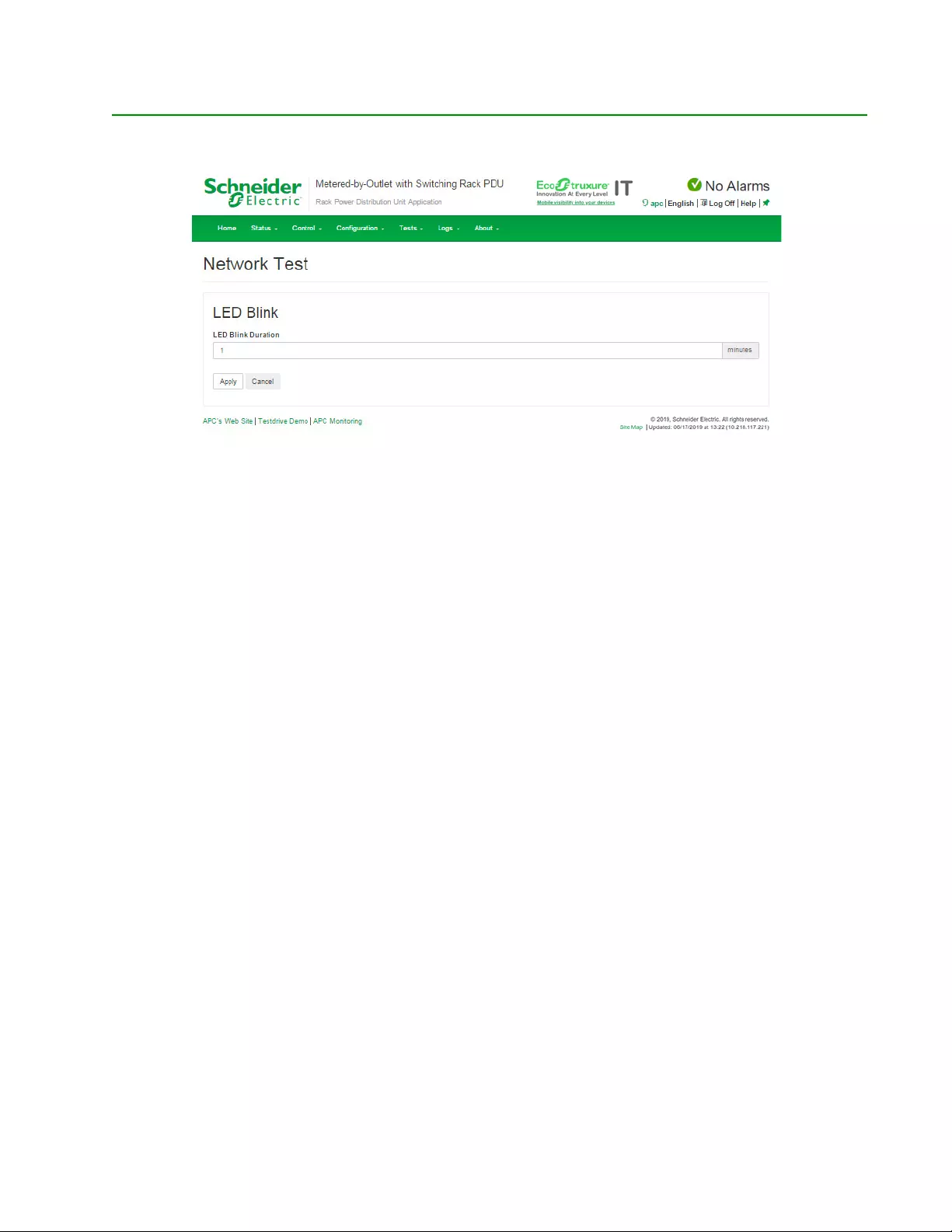
157Metered by Outlet with Switching Rack PDU AP86XX User Guide
Tests Tab
Set the Network Status LED or Device LCD to Blink
Path: Tests > Network > LED Blink
If you are having trouble finding your Rack PDU, enter a number of minutes in the LED Blink Duration field,
click Apply, and the Status and Link LED lights on the display will blink.
Path: Tests > RPDU > LCD Blink
Under this menu, you can enter a number of minutes in the LCD Blink Duration field, click Apply and the LCD
backlight will begin blinking.
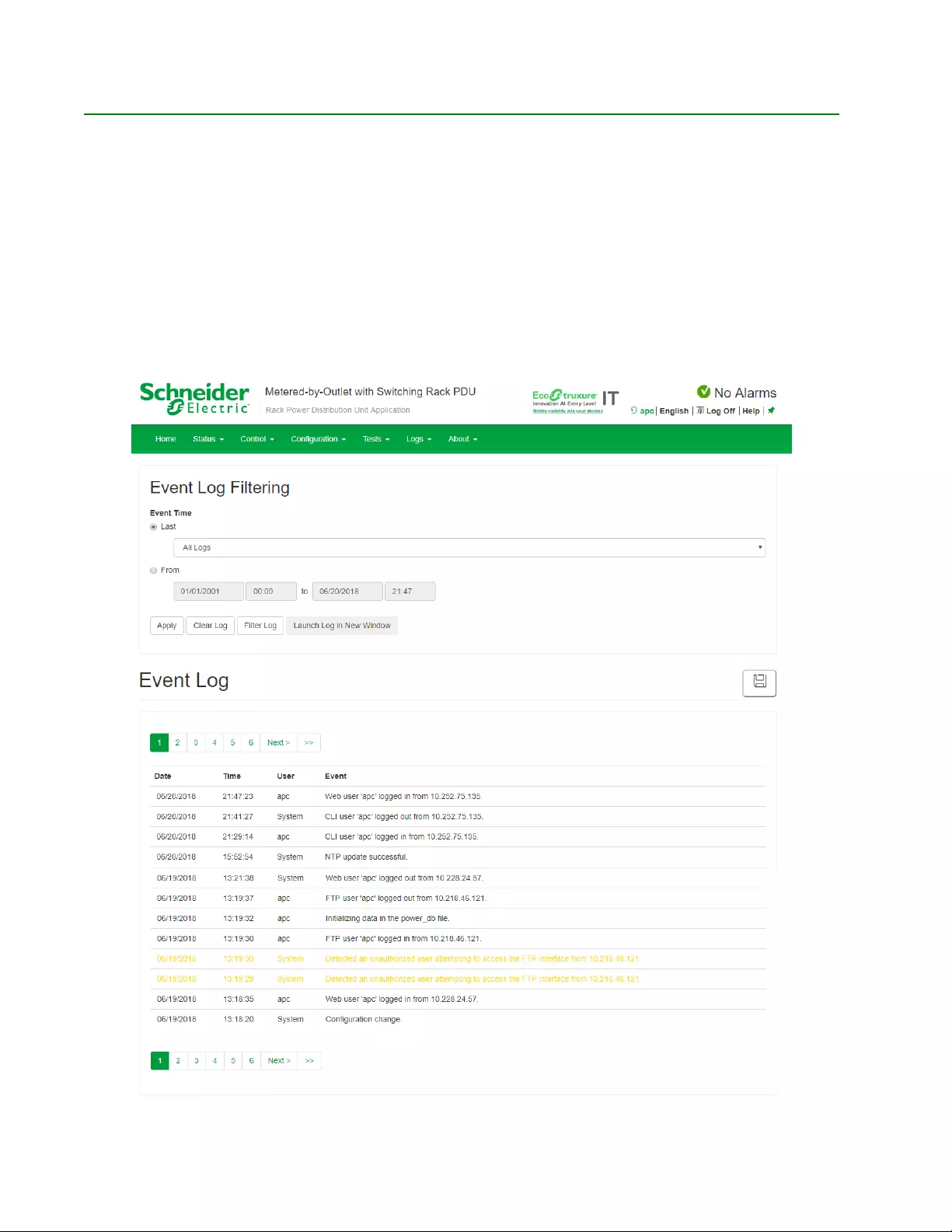
Metered by Outlet with Switching Rack PDU AP86XX User Guide158
Logs Tab
Event, Data and Firewall Logs
Event log
Path: Logs > Events
By default, the log displays all events recorded during the last two days, starting with the latest events.
Additionally, the log records any event that sends an SNMP trap, except SNMP authentication failures, and
abnormal internal system events.
You can enable color coding for events on the Configuration > Security > Local Users Management screen.

159Metered by Outlet with Switching Rack PDU AP86XX User Guide
Path: Logs > Events > Log
By default, the event log displays the most recent events first. To see the events listed together on a Web page,
click Launch Log in New Window.
To open the log in a text file or to save the log to disk, click on the floppy disk icon( ) on the same line as the
Event Log heading.
You can also use FTP or Secure CoPy (SCP) to view the event log. See “Use FTP or SCP to retrieve log files”
on page 162.
Filtering event logs:
Use filtering to omit information you don’t want to display.
• Filtering the log by date or time: Use the Last or From radio buttons. (The filter configuration is
saved until the Rack PDU restarts.)
• Filtering the log by event severity or category:
– Click Filter Log.
– Clear a check box to remove it from view.
– After you click Apply, text at the upper right corner of the Event Log page indicates that a filter
is active. The filter is active until you clear it or until the Rack PDU restarts.
• Removing an active filter:
– Click Filter Log.
– Click Clear Filter (Show All).
– As Administrator, click Save As Default to save this filter as the new default log view for all
users.
Important points on filtering:
• Events are processed through the filter using OR logic. If you apply a filter, it works regardless of
the other filters.
• Events that you cleared in the Filter By Severity list never display in the filtered Event Log, even
if selected in the Filter by Category list.
• Similarly, events that you clear in the Filter by Category list never display in the filtered Event Log.
Deleting event logs:
To delete all events, click Clear Log. Deleted events cannot be retrieved.
To disable the logging of events based on their assigned severity level or their event category, see “Configure
event actions” on page 147
Path: Logs > Events > Reverse Lookup
With reverse lookup enabled, when a network-related event occurs, both the IP address and the domain name
for the networked device with the event are logged in the event log. If no domain name entry exists for the
device, only its IP address is logged with the event.
Since domain names generally change less frequently than IP addresses, enabling reverse lookup can
improve the ability to identify addresses of networked devices that are causing events.
Reverse lookup is disabled by default. You should not need to enable it if you have no DNS server configured
or have poor network performance because of heavy network traffic.
Path: Logs > Events > Size
Use Event Log Size to specify the maximum number of log entries.
NOTE: When you resize the event log in order to specify a maximum size, all existing log entries are deleted.
When the log subsequently reaches the maximum size, the older entries are deleted.

Metered by Outlet with Switching Rack PDU AP86XX User Guide160
Network Port Sharing event logs and traps:
Rack PDU events from guest Rack PDUs are sent to the host Rack PDU for inclusion into its log. The log entry
will include the Display ID of the unit that the event occurred on.
These events are then handled the same as local events from the host PDU. Therefore alarms, SNMP traps,
emails, Syslog, etc., will support Rack PDU events and alarms from all Rack PDUs in a group.
Example event log: Rack PDU 4: Device low load.
NOTE: System events will only be logged for the host Rack PDU. System events from guest Rack PDUs will
not be logged on the host PDU.
Data log
Use the data log to display measurements about the Rack PDU, the power input to the Rack PDU, and the
ambient temperature of the Rack PDU.
The steps to display and resize the data log are the same as for the event log, except that you use menu
options under Data instead of Events.
Path: Logs > Data > Log
Filtering data logs:
Use filtering to omit information you don’t want to display. Using the Network Port
Sharing Data Log, the host Rack PDU will poll data from guest Rack PDUs so that data from all Rack PDUs in
a group are available. To view data from a different Rack PDU in a group, select the desired Rack PDU from
the "Filter Log" pull-down list.
Similarly for data log graphing, you can select a different Rack PDU by clicking on the Change Data Filter
button.
• Filtering the log by date or time: Use the Last or From radio buttons. (The filter configuration is
saved until the Rack PDU restarts.)
• Filtering the log by event severity or category:
– Click Filter Log.
– Clear a check box to remove it from view.
– After you click Apply, text at the upper right corner of the Data Log page indicates that a filter
is active. The filter is active until you clear it or until the Rack PDU restarts.
• Removing an active filter:
– Click Filter Log.
– Click Clear Filter (Show All).
– As Administrator, click Save As Default to save this filter as the new default log view for all
users.
Deleting data logs:
To delete all data log records, click Clear Data Log. Deleted data log records cannot be
retrieved.
Path: Logs > Data > Interval
Define, in the Log Interval setting, how frequently data is searched for and stored in the data log. When you
click Apply, the number of possible storage days is recalculated and display at the top of the screen. When the
log is full, the oldest entries are deleted.
NOTE: Because the interval specifies how often the data is recorded, the smaller the interval, the more times
the data is recorded and the larger the log file.

161Metered by Outlet with Switching Rack PDU AP86XX User Guide
Path: Logs > Data > Graphing
Data log graphing provides a graphical display of logged data and is an enhancement of the existing data log
feature. How the graphing enhancement displays data and how efficiently it performs will vary depending on
your computer hardware, computer operating system, and the Web browser you use to access the interface of
the unit.
NOTE: JavaScript® must be enabled in your browser to use the graphing feature. Alternatively, you can use
FTP or SCP to import the data log into a spreadsheet application, and graph data in the spreadsheet
Graph Data:
Select the data items that correspond to the abbreviated column headings in the data log to
graph multiple data items. Hold down
C
TRL
to select multiple items.
Graph Time:
Select Last to graph all records or to change the number of hours, days, or weeks for which
data log information is graphed. Select a time option from the drop-down menu. Select From to graph data
logged during a specific time period.
NOTE: Enter time using the 24-hour clock format.
Apply:
Click Apply to graph the data.
Launch Graph in New Window:
Click Launch Graph in New Window to launch the data log graph in a
new browser window that provides a larger view of the graph.
Path: Logs > Data > Rotation
Rotation causes the contents of the data log to be appended to the file you specify by name and location. Use
this option to set up password-protection and other parameters.
• FTP Server: The IP address or host name of the server where the file will reside.
• User Name/Password: The user name with password required to send data to the repository file.
This user must also be configured to have read and write access to the data repository file and the
directory (folder) in which it is stored.
• File Path: The path to the repository file.
• Filename: The name of the repository file (an ASCII text file), e.g. datalog.txt. Any new data is
appended to this file: it does not overwrite it.
• Unique Filename: Select this check box to save the log as mmddyyyy_<filename>.txt, where
filename is what you specified in the Filename field above. Any new data is appended to the file
but each day has its own file.
• Delay n hours between uploads: The number of hours between uploads of data to the file (max.
24 hours).
• Upon failure, try uploading every n minutes: The number of minutes between attempts to
upload data to the file after a failed upload.
–Up to n times: The maximum number of times the upload will be attempted after it fails
initially.
–Until upload succeeds: Attempt to upload the file until the transfer is completed.
Path: Logs > Data > Size
Use Data Log Size to specify the maximum number of log entries.
NOTE: When you resize the data log in order to specify a maximum size, all existing log entries are deleted.
When the log subsequently reaches the maximum size, the older entries are deleted.

Metered by Outlet with Switching Rack PDU AP86XX User Guide162
Firewall Logs
Path: Logs > Firewall
If you create a firewall policy, firewall events will be logged here.
The information in the log can be useful to help the technical support team solve problems. Log entries contain
information about the traffic and the rules action (allowed, discarded). When logged here, these events are not
logged in the main Event Log (see “Event log” on page 158).
A firewall log contains up to 50 of the most recent events. The firewall log is cleared when the management
interface reboots.
Use FTP or SCP to retrieve log files
An Administrator or Device User can use FTP or SCP to retrieve a tab-delineated event log file (event.txt)
or data log file (data.txt) and import it into a spreadsheet.
• The file reports all events or data recorded since the log was last deleted or (for the data log)
truncated because it reached maximum size.
• The file includes information that the event log or data log does not display.
– The version of the file format (first field)
– The date and time the file was retrieved
–The
Name, Contact, and Location values and IP address of the Rack PDU
– The unique Event Code for each recorded event (event.txt file only)
NOTE: The Rack PDU uses a four-digit year for log entries. You may need to select a four-
digit date format in your spreadsheet application to display all four digits.
If you are using the encryption-based security protocols for your system, use SCP to retrieve the log file.
If you are using unencrypted authentication methods for the security of your system, use FTP to retrieve the
log file.
NOTE: By default, FTP is disabled and SCP (via SSH) is enabled.
See the Security Handbook, available at www.apc.com, for information on available protocols and methods
for setting up the type of security you need.
To use SCP to retrieve the files:
To retrieve the event.txt file, use the following command:
scp -c <cipher> username@hostname_or_ip_address:event.txt ./event.txt
To retrieve the data.txt file, use the following command:
scp -c <cipher> username@hostname_or_ip_address:data.txt ./data.txt
NOTEs:
• This SCP command is for OpenSSH. The command may differ depending on the SSH tool used.
• When using OpenSSH, <cipher> can be either aes256-cbc or 3des-cbc.

163Metered by Outlet with Switching Rack PDU AP86XX User Guide
To use FTP to retrieve the
event.txt
or
data.txt
files:
1. At a command prompt, type ftp and the IP address of the Rack PDU, and press
E
NTER
.
If the Port setting for the FTP Server option (set through the Network menu of the
Administration tab) has been changed from its default (21), you must use the non-default
value in the FTP command. For Windows FTP clients, use the following command, including
spaces. (For some FTP clients, you must use a colon instead of a space between the IP
address and the port number.)
ftp>open ip_address port_number
To set a non-default port value to enhance security for the FTP Server, see “FTP Server” on
page 146. You can specify any port from 5001 to 32768.
2. Use the case-sensitive User Name and Password for Administrator or Device User to log on.
For Administrator, apc is the default for User Name and Password. For the Device User, the
defaults are device for User Name and apc for Password.
3. Use the get command to transmit the text of a log to your local drive.
ftp>get event.txt
or
ftp>get data.txt
4. Type quit at the ftp> prompt to exit from FTP.

Metered by Outlet with Switching Rack PDU AP86XX User Guide164
About Tab
About the Rack PDU
Path: About > RPDU/Network
The hardware information is useful to Schneider Electric Customer Support for troubleshooting problems with
the Rack PDU. The serial number and MAC address are also available on the Rack PDU itself.
Firmware information for the Application Module, APC OS (AOS), and APC Boot Monitor indicates the name,
the firmware version, and the date and time each firmware module was created. This information is also useful
in troubleshooting and enables you to determine if updated firmware is available at the website,
www.apc.com.
Management Uptime is the length of time the network management interface has been running continuously.
Support Screen
Path: About > Support
With this option, you can consolidate various data in this interface into a single zipped file for troubleshooting
purposes and customer support. The data includes the event and data logs, the configuration file and complex
debugging information.
Click Generate Logs to create the file and then Download. You will be asked whether you want to view or
save the zipped file.

165Metered by Outlet with Switching Rack PDU AP86XX User Guide
Device IP Configuration Wizard
Capabilities, Requirements, and Installation
How to use the Wizard to configure TCP/IP settings
The Device IP Configuration Wizard can discover Rack PDUs that do not have an IP address assigned. Once
discovered, you can configure the IP address settings for the cards.
You can also search for devices already on the network by entering an IP range to define the search. The
Utility scans the IP addresses in the defined range and discovers Rack PDUs that already have a DHCP-
assigned IP address.
NOTE: For detailed information on the Utility, go to www.apc.com, select your country from the drop-down list,
select Support > Resources and Tools > FAQs and search for FA156064 (the ID of the relevant article).
NOTE: To use the DHCP Option 12 (AOS 5.1.5 or higher), see FA156110 in the FAQs.
System requirements
The Device IP Configuration Wizard is a Windows application designed specifically to remotely configure the
basic TCP/IP settings of Network Management Cards. The Wizard runs on Microsoft® Windows® 2000,
Windows Server 2003, Windows Vista, Windows XP, Windows 7, Windows Server® 2008, Windows 8, and
Windows 10, and Window 2012. This utility supports cards that have firmware version 3.x.x or higher and is for
IPv4 only.
Installation
To install the Device IP Configuration Wizard from a downloaded executable file
1. Go to www.apc.com.
2. Download the Device IP Configuration Wizard.
3. Run the downloaded executable file.
When installed, the Device IP Configuration Wizard is available through the Windows Start menu options.

Metered by Outlet with Switching Rack PDU AP86XX User Guide166
How to Export Configuration Settings
Retrieving and Exporting the .ini File
Summary of the procedure
A Super User/Administrator can retrieve the .ini file of a Rack PDU and export it to another Rack PDU or to
multiple Rack PDUs. The steps are below; see details in the sections following.
1. Configure a Rack PDU with the desired settings and export them.
2. Retrieve the .ini file from that Rack PDU.
3. Customize the file to change the TCP/IP settings at least.
4. Use a file transfer protocol supported by the Rack PDU to transfer a copy to one or more other
Rack PDUs. For a transfer to multiple Rack PDUs, use an FTP or SCP script or the .ini file utility.
NOTE: FTP is disabled by default. See “FTP Server” on page 146 to enable FTP.
Each receiving Rack PDU uses the file to reconfigure its own settings and then deletes it.
NOTE: Managing Users via the config.ini: Users are no longer managed via the config.ini in any form. Users
are now managed via a separate file with the .csf extension. See additional information in the Frequently
Asked Questions (FAQs). Go to www.apc.com, select your country from the drop-down list, select Support >
Resources and Tools > FAQs, and search for article ID FA176542.
Contents of the .ini file
The config.ini file you retrieve from a Rack PDU contains the following:
• Section headings and keywords (only those supported for the particular device from which you
retrieve the file): Section headings are category names enclosed in brackets ([ ]). Keywords,
under each section heading, are labels describing specific Rack PDU settings. Each keyword is
followed by an equals sign and a value (either the default or a configured value).
• The Override keyword: With its default value, this keyword prevents the exporting of one or
more keywords and their device-specific values. For example, in the [NetworkTCP/IP] section,
the default value for Override (the MAC address of the Rack PDU) blocks the exporting of
values for the SystemIP, SubnetMask, DefaultGateway, and BootMode.
.ini and Network Port Sharing
The .ini configuration utility is able to get and set values for all Rack PDUs in a group. In order to be backwards
compatible, the host Rack PDU will always be designated as first, "PDU_A". Any guest Rack PDUs are then
designated "PDU_B", "PDU_C", and "PDU_D" based on their Display ID in ascending order. Therefore,
"PDU_A" will not necessarily correlate to Display ID 1, and so on.
NOTE: Because of the large number of configuration values possible in a Rack PDU group, it may take a very
long time to process an INI file set. For example, a Rack PDU group of 4 units with all values changing may
take 30 minutes to complete processing.

167Metered by Outlet with Switching Rack PDU AP86XX User Guide
Detailed procedures
Retrieving:
To set up and retrieve an .ini file to export:
1. If possible, use the interface of a Rack PDU to configure it with the settings to export. (Directly
editing the .ini file risks introducing errors).
2. Use FTP or SCP to retrieve the config.ini from the configured Rack PDU:
– To use FTP:
a.Open a connection to the Rack PDU using its IP address:
ftp> open ip_address
b.Log on using the Super User/Administrator user name and password.
c.Retrieve the config.ini file containing the settings of the Rack PDU:
ftp> get config.ini
The file is written to the folder from which you launched the FTP.
To retrieve configuration settings from multiple Rack PDUs and export them to other Rack
PDUs, see Release Notes: ini File Utility, version 2.0, available at www.apc.com.
– To use SCP, use the following command:
scp -c <cipher> username@hostname_or_ip_address:config.ini ./config.ini
Then enter the correct password.
NOTEs:
• This SCP command is for OpenSSH. The command may differ depending on the SSH tool
used.
• When using OpenSSH, <cipher> can be either aes256-cbc or 3des-cbc.
Customizing:
You must customize the file before you export it.
1. Use a text editor to customize the file.
– Section headings, keywords, and pre-defined values are not case-sensitive, but string values
that you define are case-sensitive.
– Use adjacent quotation marks to indicate no value. For example, LinkURL1="" indicates that
the URL is intentionally undefined.
– Enclose in quotation marks any values that contain leading or trailing spaces or are already
enclosed in quotation marks.
– To export scheduled events, configure the values directly in the .ini file.
– To export a system time with the greatest accuracy, if the receiving Rack PDUs can access a
Network Time Protocol server, configure enabled for NTPEnable:
NTPEnable=enabled
Alternatively, reduce transmission time by exporting the [SystemDate/Time] section as a
separate .ini file.
– To add comments, start each comment line with a semicolon (;).
2. Copy the customized file to another file name in the same folder:
– The file name can have up to 64 characters and must have the .ini suffix.
– Retain the original customized file for future use. The file that you retain is the only record
of your comments.

Metered by Outlet with Switching Rack PDU AP86XX User Guide168
Transferring the file to a single
Rack PDU
:
: To transfer the .ini file to another Rack PDU, do either of the
following:
• From the Web UI of the receiving Rack PDU, select Configuration > General > User Config
File. Enter the full path of the file, or use Browse on your local PC.
• Use any file transfer protocol supported by Rack PDUs, i.e., FTP, FTP Client, SCP, or TFTP. The
following example uses FTP:
a. From the folder containing the copy of the customized .ini file, use FTP to log in to the Rack PDU
to which you are exporting the .ini file:
ftp> open ip_address
b. Export the copy of the customized .ini file to the root directory of the receiving Rack PDU:
ftp> put filename.ini
Exporting the file to multiple
Rack PDU
s:
To export the .ini file to multiple Rack PDUs:
• Use FTP or SCP, but write a script that incorporates and repeats the steps used for exporting the
file to a single Rack PDU.
• Use a batch processing file and the .ini file utility.
• To create the batch file and use the utility, see Release Notes: ini File Utility, version 2.0, available
at www.apc.com.

169Metered by Outlet with Switching Rack PDU AP86XX User Guide
The Upload Event and Error Messages
The event and its error messages
The following event occurs when the receiving Rack PDU completes using the .ini file to update its settings.
Configuration file upload complete, with number valid values
If a keyword, section name, or value is invalid, the upload by the receiving Rack PDU succeeds, and additional
event text states the error.
Messages in config.ini
A Rack PDU from which you download the config.ini file must be discovered successfully in order for its
configuration to be included. If the Rack PDU is not present or is not discovered, the config.ini file contains a
message under the appropriate section name, instead of keywords and values.
For example: Rack PDU not discovered
If you did not intend to export the Rack PDU configuration as part of the .ini file import, ignore these messages.
Errors generated by overridden values
The Override keyword and its value will generate error messages in the event log when it blocks the
exporting of values. See “Contents of the .ini file” on page 166 for information about which values are
overridden.
Because the overridden values are device-specific and not appropriate to export to other Rack PDUs, ignore
these error messages. To prevent these error messages, delete the lines that contain the Override keyword
and the lines that contain the values that they override. Do not delete or change the line containing the section
heading.
Related Topics
On Windows operating systems, instead of transferring .ini files, you can use the Device IP Configuration
Wizard to update the basic TCP/IP settings of the Rack PDU and configure other settings through its user
interface. See “Device IP Configuration Wizard” on page 165.
Event text Description
Configuration file warning: Invalid keyword
on line number.
Configuration file warning: Invalid value on
line number.
A line with an invalid keyword or value is ignored.
Configuration file warning: Invalid section
on line number. If a section name is invalid, all keyword/value pairs in that
section are ignored.
Configuration file warning: Keyword found
outside of a section on line number.
A keyword entered at the beginning of the file (i.e., before
any section headings) is ignored.
Configuration file warning: Configuration file
exceeds maximum size.
If the file is too large, an incomplete upload occurs. Reduce
the size of the file, or divide it into two files, and try
uploading again.

Metered by Outlet with Switching Rack PDU AP86XX User Guide170
File Transfers
Upgrading Firmware
Benefits of upgrading firmware
When you upgrade the firmware on the Rack PDU:
• You obtain the latest bug fixes and performance improvements.
• New features become available for immediate use.
Keeping the firmware versions consistent across your network ensures that all Rack PDUs support the same
features in the same manner.
Upgrading here means simply placing the module files on the Rack PDU; there is no installation required.
Check regularly on www.apc.com for any new upgrades.
Firmware module files (Rack PDU)
A firmware release has three modules, and they must be upgraded (that is, placed on the Rack PDU) in the
same order as shown in the table below.
NOTE: It is possible to skip upgrading the bootmon file if it is already the same version as the file located on
the card.
(Each module contains one or more Cyclical Redundancy Checks (CRCs) to protect its data from corruption).
The boot monitor module, the AOS, and the application file names share the same basic format:
apc_hardware-version_type_firmware-version.bin
• apc: Indicates the context.
• hardware-version: hw0n where n identifies the hardware version on which you can use this
file.
• type: Identifies which module.
• version: The version number of the file.
• bin: Indicates that this is a binary file.
Order Module Description
1 Boot Monitor (bootmon) Roughly equivalent to the BIOS of a PC
2American Power Conversion Operating System
(AOS)
Can be considered the operating system of
the Rack PDU
3 Application Specific to the Rack PDU device type

171Metered by Outlet with Switching Rack PDU AP86XX User Guide
Firmware File Transfer Methods
NOTE:
Upgrade the bootmon module first, then the AOS module, and finally, the application module by placing
them on the Rack PDU in that order.
Obtain the free, latest firmware version from the APC by Schneider Electric website. To upgrade the firmware
of one or more Rack PDUs, use 1 of these 5 methods:
• On a Windows operating system, use the Firmware Upgrade Utility downloaded from the
website www.apc.com.
• On any supported operating system, use FTP or SCP to transfer the individual AOS and
application firmware modules.
• For a Rack PDU that is NOT on your network, use XMODEM through a serial connection to
transfer the individual firmware modules from your computer to the Rack PDU.
• Use a USB drive to transfer the individual firmware modules from your computer. See “How to
upgrade multiple Rack PDUs” on page 174.
• For upgrades to multiple Rack PDUs, see “Upgrading the firmware on multiple Rack PDUs” and
“Using the Firmware Upgrade Utility for multiple upgrades on Windows”.
Using the Firmware Upgrade Utility
This Firmware Upgrade Utility is part of the firmware upgrade package available on the www.apc.com
website. (Never use an Upgrade Utility designated for one product to upgrade the firmware of another
product).
Using the Utility for upgrades on Windows-based systems:
On any supported Windows operating
system, the Firmware Upgrade Utility automates the transferring of the firmware modules, in the correct
module order.
Unzip the downloaded firmware upgrade file and double-click the .exe file. Then enter the IP address, the user
name, and the password in the dialog fields and click Upgrade Now. You can use the Ping button to test your
entered details. See “How to upgrade multiple Rack PDUs” on page 174.
Using the Utility for manual upgrades, primarily on Linux:
On non-Windows operating systems, the
Firmware Upgrade Utility extracts the individual firmware modules, but does not upgrade the Rack PDU. See
“Firmware File Transfer Methods” on page 171 for the different upgrade methods after extraction.
To extract the firmware files:
1. After extracting files from the downloaded firmware upgrade file, run the Firmware Upgrade
Utility (the .exe file).
2. At the prompts, click Next>, and then specify the directory location to which the files will be
extracted.
3. When the Extraction Complete message displays, close the dialog box.

Metered by Outlet with Switching Rack PDU AP86XX User Guide172
Use FTP or SCP to upgrade one Rack PDU
FTP:
To use FTP to upgrade a Rack PDU over the network:
• The Rack PDU must be on the network, with its system IP, subnet mask, and default gateway
configured.
• The FTP server must be enabled at the Rack PDU, see “FTP Server” on page 146.
To transfer the files (this procedure assumes bootmon does not need upgrading, it is always necessary to
upgrade the other two, though):
1. The firmware module files must be extracted, see “To extract the firmware files:”.
2. At a computer on the network, open a command prompt window. Go to the directory that contains
the firmware files, and list the files:
C:\>cd apc
C:\apc>dir
3. Open an FTP client session:
C:\apc>ftp
4. Type open with the IP address of the Rack PDU, and press
E
NTER
. If the port setting for the
FTP Server has changed from its default of 21, you must use the non-default value in the FTP
command.
• For Windows FTP clients, separate a non-default port number from the IP address by a
space. For example (showing a space before 21000):
ftp> open 150.250.6.10 21000
• Some FTP clients require a colon instead before the port number.
5. Log on as Administrator (apc is the default user name and password).
6. Upgrade the AOS. (Always upgrade the AOS before the application module).
ftp> bin
ftp> put apc_hw05_aos_nnn.bin (where nnn is the firmware version number)
7. When FTP confirms the transfer, type quit to close the session.
8. After 20 seconds, repeat step 3 through step 7, using the application module file name at step 6,
SCP:
To use Secure CoPy (SCP) to upgrade firmware for the Rack PDU, follow these steps.
NOTE: As SCP is part of SSH, enabling SSH also enables SCP. SSH is enabled by default.
This procedure assumes bootmon does not need upgrading. It is always necessary to upgrade the other two
files:
1. Locate the firmware modules, see “Using the Utility for manual upgrades, primarily on Linux:” on
page 171.
2. Use an SCP command line to transfer the AOS firmware module to the Rack PDU. The following
example uses nnn to represent the version number of the AOS module:
scp -c <cipher> apc_hw05_aos_nnn.bin apc@158.205.6.185:apc_hw05_aos_nnn.bin
NOTE: This SCP command is for OpenSSH. The command may differ depending on the SSH
tool used. <cipher> can be either aes256-cbc or 3des-cbc.
3. Use a similar SCP command line, with the name of the application module, to transfer the
application firmware module to the Rack PDU. (Always upgrade the AOS before the application
module).

173Metered by Outlet with Switching Rack PDU AP86XX User Guide
Use XMODEM to upgrade one Rack PDU
To use XMODEM to upgrade one Rack PDU that is not on the network, you must extract the firmware files from
the Firmware Upgrade Utility (see “To extract the firmware files:”).
To transfer the files (this procedure assumes bootmon does not need upgrading, it is always necessary to
upgrade the other two though):
1. Select a serial port at the local computer and disable any service that uses the port.
2. Connect the provided serial configuration cable (part number 940-0144A) to the selected port
and to the RJ-12 style serial port at the Rack PDU.
3. Run a terminal program such as Tera Term or HyperTerminal, and configure the selected port for
57600 bps, 8 data bits, no parity, 1 stop bit, and no flow control.
4. Press the Reset button on the Rack PDU, then immediately press the Enter key twice, or until
the Boot Monitor prompt displays: BM>
5. Type XMODEM, then press
E
NTER
.
6. From the terminal program’s menu, select XMODEM, then select the binary AOS firmware file to
transfer using XMODEM. After the XMODEM transfer is complete, the Boot Monitor prompt
returns.
(Always upgrade the AOS before the application module).
7. To install the application module, repeat step 5 and step 6. In step 6, use the application module
file name.
8. Type reset or press the Reset button to restart the Rack PDU’s management interface.
Use a USB drive to transfer and upgrade the files
Use a USB drive to transfer and upgrade the files. Before starting the transfer, make sure the USB drive is
formatted in FAT32.
1. Download the firmware upgrade files and unzip them.
2. Create a folder named apcfirm on the USB flash drive.
3. Place the extracted module files in the apcfirm directory.
4. Use a text editor to create a file named upload.rcf. (The file extension must be .rcf, not .txt for
example.)
5. In upload.rcf, add a line for each firmware module that you want to upgrade. For example, to
upgrade to bootmon version 1.0.8, AOS v6.8.0, and the device application version v6.8.0, type:
BM=apc_hw05_bootmon_108.bin
AOS=apc_hw05_aos_680.bin
APP=apc_hw05_rpdu2g_680.bin
6. Place upload.rcf in the apcfirm folder on the flash drive.
7. Insert the flash drive into a USB port on your Rack PDU.
8. Press the display Reset button and wait for the card to reboot fully.
9. Check that the upgrade was completed successfully using the procedures in “Verifying
Upgrades”.

Metered by Outlet with Switching Rack PDU AP86XX User Guide174
How to upgrade multiple Rack PDUs
Use one of these three methods:
• Firmware Upgrade Utility: Use this for multiple firmware updates in IPv4 if you have Windows.
The utility records all upgrade steps in a log as a good reference to validate the upgrade.
• Export configuration settings: You can create batch files and use a utility to retrieve
configuration settings from multiple Rack PDUs and export them to other Rack PDUs. See
Release Notes: ini File Utility, version 2.0, available at www.apc.com.
• Use FTP or SCP to upgrade multiple Rack PDUs: To upgrade multiple Rack PDUs using an
FTP client or using SCP, write a script which automatically performs the procedure.
NOTE: The Firmware Upgrade Utility for your APC by Schneider Electric product is available at
www.apc.com.
Using the Firmware Upgrade Utility for multiple upgrades
After downloading the Upgrade Utility, double click on the .exe file to run the utility (which ONLY works with
IPv4) and follow these steps to upgrade your Rack PDU firmware:
1. Type in an IP address, a user name, and a password, and choose the Ping button if you need to
verify an IP address.
2. Choose the Device List button to open the iplist.txt file. This should list any device IP,
user name, and password.
For example,
SystemIP=192.168.0.1
SystemUserName=apc
SystemPassword=apc
You can use an existing iplist.txt file if it already exists.
3. Select the Upgrade From Device List check box to use the iplist.txt file.
4. Choose the Upgrade Now button to start the firmware version update(s).
5. Choose View Log to verify any upgrade.
Updating firmware for Network Port Sharing (NPS) Groups
For an NPS Group, all Rack PDUs in the group should have the same firmware version. If all Rack PDUs in the
group have AOS v6.1.3 or later, simply update the host Rack PDU and it will update all guest Rack PDUs
automatically. This may take up to 10 minutes. For any Rack PDUs in the group that do not have AOS v6.1.3 or
later, they will need to be updated manually by any of the methods detailed previously.

175Metered by Outlet with Switching Rack PDU AP86XX User Guide
Verifying Upgrades and Updates
Verify the success or failure of the transfer
To verify whether a firmware upgrade succeeded, use the xferStatus command in the Command Line
Interface to view the last transfer result, or use an SNMP GET to the mfiletransferStatusLastTransferResult
OID.
Last Transfer Result codes
Possible transfer errors include the TFTP or FTP server not being found, or the server refusing access, the
server not finding or not recognizing the transfer file, or a corrupt transfer file.
Verify the version numbers of installed firmware.
Path: About > Network
Use the Web UI to verify the versions of the upgraded firmware modules. You could also use an SNMP GET to
the MIB II sysDescr OID. In the Command Line Interface, use the about command.
Download Log files to a USB Flash drive
1. Insert a USB Flash drive to the USB port on the Display Interface
of the Rack PDU. Before starting the transfer, make sure the USB
drive is formatted in FAT32.
2. Scroll to Log to Flash on the Display Screen and press the Select button.
3. Press the Select button again to export the Log files to your Flash drive.
4. You may abort the download by pressing the Select button at any time
during the download process.
NOTE: If a debug.txt file or a dump.txt file does not exist on the Rack PDU, it cannot be downloaded to the
USB Flash drive. These files are only created following an unexpected system crash or a Network
Management Card (NMC) reset. The debug.txt and dump.txt files are used for technical support only.
Code Description
Successful The file transfer was successful.
Result not
available There are no recorded file transfers.
Failure unknown The last file transfer failed for an unknown reason.
Server
inaccessible The TFTP or FTP server could not be found on the network.
Server access
denied The TFTP or FTP server denied access.
File not found The TFTP or FTP server could not locate the requested file.
File type unknown The file was downloaded but the contents were not recognized.
File corrupt The file was downloaded but at least one Cyclical Redundancy Check (CRC)
failed.
pdu0798a
Log to flash
SELECMAI
Press <SELECT> to start export
XX previous records

Metered by Outlet with Switching Rack PDU AP86XX User Guide176
Troubleshooting
Rack PDU Access Problems
For problems that persist or are not described here, contact APC by Schneider Electric Customer Care at
www.apc.com.
Problem Solution
After a Network Port Sharing
host is updated to new
firmware, the guest Rack
PDUs show a "firmware
version does not match"
alarm.
This can be solved by manually updating the affected guest Rack PDUs by
one of the firmware update methods. For example, see “Use a USB drive
to transfer and upgrade the files” on page 173.
Cannot enable EnergyWise
on a guest Rack PDU in a
NPS group.
User is allowed to have a redundant network in a NPS chain. However,
only one Rack PDU, the host, will communicate to EnergyWise.
RF Code Issues (A)
Unable to clear RF Tag
Communications Lost
alarm (B):
(A) It is possible to receive an incorrect tag:
1. Verify you have the correct tag from the RF code. Go to:
www.rfcode.com
2. Verify you are in correct mode (RF Code active screen on LCD).
a. Select the Scroll button on the Rack PDU device.
b. On the second screen press Select to active the RF Code
Control screen.
c. The screen will say: Rf-Code Console Disabled/Enabled Press
“Select” Will Reboot.
3. Check serial communication is OK:
Connect serial cord provided with the unit to the unit Serial port and
a serial port located on the computer. Access the Command Line
Interface to verify signals are being received and sent from the
computer to the unit. Only valid if RF is disabled.
(B) Ensure tag is installed in the serial port, then disable the RF feature
through the LCD display. The RF Tag can then be safely removed.
Unable to ping the Rack PDU
If the Rack PDU’s Network Status LED is green, try to ping another node
on the same network segment as the Rack PDU. If that fails, it is not a
problem with the Rack PDU. If the Network Status LED is not green, or if
the ping test succeeds, perform the following checks:
• Verify all network connections.
• Verify the
IP
addresses of the Rack PDU and the
NMS
.
• If the
NMS
is on a different physical network (or subnetwork) from the
Rack PDU, verify the IP address of the default gateway (or router).
• Verify the number of subnet bits for the Rack PDU’s subnet mask.
Cannot allocate the
communications port through
a terminal program
Before you can use a terminal program to configure the Rack PDU, you
must shut down any application, service, or program using the
communications port.

177Metered by Outlet with Switching Rack PDU AP86XX User Guide
Cannot access the Command
Line Interface through a serial
connection
Make sure that you did not change the baud rate. Try 2400, 9600, 19200,
or 38400.
Cannot access the Command
Line Interface remotely
• Make sure you are using the correct access method, Telnet or Secure
SHell (SSH). The Super User or an Administrator can enable these
access methods. By default, Telnet is disabled, and SSH is enabled.
SSH and Telnet can be enabled/disabled independently.
• For SSH, the Rack PDU may be creating a host key. The Rack PDU can
take up to one minute to create the host key, and SSH is inaccessible for
that time.
Cannot access the Web UI
• Verify that HTTP or HTTPS access is enabled.
• Make sure you are specifying the correct URL — one that is consistent
with the security system used by the Rack PDU. SSL/TLS requires
https, not http, at the beginning of the URL.
• Verify that you can ping the Rack PDU.
• Verify that you are using a Web browser supported for the Rack PDU.
See “Supported Web Browsers” on page 104.
• If the Rack PDU has just restarted and SSL/TLS security is being set up,
the Rack PDU may be generating a server certificate. The Rack PDU
can take up to one minute to create this certificate, and the SSL/TLS
server is not available during that time.
• Check that the Minimum Protocol setting configured on the Rack PDU
for SSL/TLS matches what is enabled or configured in your Web
browser.
NOTE: Check the specific error message reported by the browser. It
may indicate the specific problem.
Cannot communicate using
Network Port Sharing (NPS)
• If you are having communications problems with Network Port Sharing,
check that the total length of network cable between up to four units is
not more than 10 meters.
• If you are having communications problems with Network Port Sharing,
check that a terminator is installed at both ends of up to four units that
can be grouped together.
• If you are using Network Port Sharing and do not see one or more of the
units in the group, check that all units in the group are using the same
firmware revision. You can download appropriate firmware revisions
from the APC by Schneider Electric website, www.apc.com.
The Rack PDU reports
“Component communications
lost with Phase Meter” and/or
“Communication lost” alarms
Refer to FA168022 in the FAQs at www.apc.com.
The Rack PDU reports “CAN
bus off” alarm Refer to FA173637 in the FAQs at www.apc.com.
The Rack PDU reports “No
metering outlets detected”
and/or “Communications lost”
alarms.
Make sure your Rack PDU is an AP86XX which contains Metering-by-
Outlet functionality and, if so, verify your terminator is in either the IN or
OUT port. For more information, refer to FA156187 in the FAQs at
www.apc.com.
Problem Solution

Metered by Outlet with Switching Rack PDU AP86XX User Guide178
SNMP Issues
Problem Solution
Unable to perform a GET
• Verify the read (GET) community name (SNMPv1) or the user profile
configuration (SNMPv3).
• Use the CLI or Web UI to ensure that the NMS has access.
See “SNMP” on page 143.
Unable to perform a SET
• Verify that SNMP is enabled. SNMPv1 and SNMPv3 are disabled by default.
• Verify the read/write (SET) community name (SNMPv1) or the user profile
configuration (SNMPv3).
• Use the CLI or Web UI to ensure that the NMS has write (SET) access
(SNMPv1) or is granted access to the target IP address through the access
control list (SNMPv3). See “SNMP” on page 143.
Unable to receive traps at
the NMS
• Make sure the trap type (SNMPv1 or SNMPv3) is correctly configured for the
NMS as a trap receiver.
• For SNMP v1, query the mconfigTrapReceiverTable MIB OID to verify that the
NMS IP address is listed correctly and that the community name defined for the
NMS matches the community name in the table. If either is not correct, use
SETs to the mconfigTrapReceiverTable OIDs, or use the CLI or Web UI to
correct the trap receiver definition.
• For SNMPv3, check the user profile configuration for the NMS, and run a trap
test.
See “SNMP” on page 143, “SNMP trap receiver screen” on page 151, and “SNMP
traps test screen” on page 151.
Traps received at an
NMS are not identified
See your NMS documentation to verify that the traps are properly integrated in the
alarm/trap database.

179Metered by Outlet with Switching Rack PDU AP86XX User Guide
Source Code Copyright Notice
cryptlib copyright Digital Data Security New Zealand Ltd 1998.
Copyright © 1990, 1993, 1994 The Regents of the University of California. All rights reserved.
This code is derived from software contributed to Berkeley by Mike Olson.
Redistribution and use in source and binary forms, with or without modification, are permitted provided that the
following conditions are met:
1. Redistributions of source code must retain the above copyright notice, this list of conditions and
the following disclaimer.
2. Redistributions in binary form must reproduce the above copyright notice, this list of conditions
and the following disclaimer in the documentation and/or other materials provided with the
distribution.
3. All advertising materials mentioning features or use of this software must display the following
acknowledgment: This product includes software developed by the University of California,
Berkeley and its contributors.
4. Neither the name of the University nor the names of its contributors may be used to endorse or
promote products derived from this software without specific prior written permission.
THIS SOFTWARE IS PROVIDED BY THE REGENTS AND CONTRIBUTORS “AS IS” AND ANY EXPRESS
OR IMPLIED WARRANTIES, INCLUDING, BUT NOT LIMITED TO, THE IMPLIED WARRANTIES OF
MERCHANTABILITY AND FITNESS FOR A PARTICULAR PURPOSE ARE DISCLAIMED. IN NO EVENT
SHALL THE REGENTS OR CONTRIBUTORS BE LIABLE FOR ANY DIRECT, INDIRECT, INCIDENTAL,
SPECIAL, EXEMPLARY, OR CONSEQUENTIAL DAMAGES (INCLUDING, BUT NOT LIMITED TO,
PROCUREMENT OF SUBSTITUTE GOODS OR SERVICES; LOSS OF USE, DATA, OR PROFITS; OR
BUSINESS INTERRUPTION) HOWEVER CAUSED AND ON ANY THEORY OF LIABILITY, WHETHER IN
CONTRACT, STRICT LIABILITY, OR TORT (INCLUDING NEGLIGENCE OR OTHERWISE) ARISING IN ANY
WAY OUT OF THE USE OF THIS SOFTWARE, EVEN IF ADVISED OF THE POSSIBILITY OF SUCH
DAMAGE.


Radio Frequency Interference
Changes or modifications to this unit not expressly approved by the party responsible
for compliance could void the user’s authority to operate this equipment.
USA—FCC
This equipment has been tested and found to comply with the limits for a Class A digital device,
pursuant to part 15 of the FCC Rules. These limits are designed to provide reasonable protection
against harmful interference when the equipment is operated in a commercial environment. This
equipment generates, uses, and can radiate radio frequency energy and, if not installed and used in
accordance with this user manual, may cause harmful interference to radio communications. Operation
of this equipment in a residential area is likely to cause harmful interference. The user will bear sole
responsibility for correcting such interference.
Canada—ICES
This Class A digital apparatus complies with Canadian ICES-003.
Cet appareil numérique de la classe A est conforme à la norme NMB-003 du Cana da.
Japan—VCCI
This is a Class A product based on the standard of the Voluntary Control Council for Interference by
Information Technology Equipment (VCCI). If this equipment is used in a domestic environment,
radio disturbance may occur, in which case, the user may be required to take corrective actions.
この装置は、情報処理装置等電波障害自主規制協議会(
VCCI
)の基準
に基づくクラス
A
情報技術装置です。この装置を家庭環境で使用すると、電波
妨害を引き起こすことがあります。この場合には、使用者が適切な対策を講ず
るように要求されることがあります。
Taiwan—BSMI
警告使用者 :
這是甲類的資訊產品 , 在居住的
環境中使用時 , 可能會造成射頻
干擾 , 在這種情況下 , 使用者會
被要求採取某些適當的對策。
